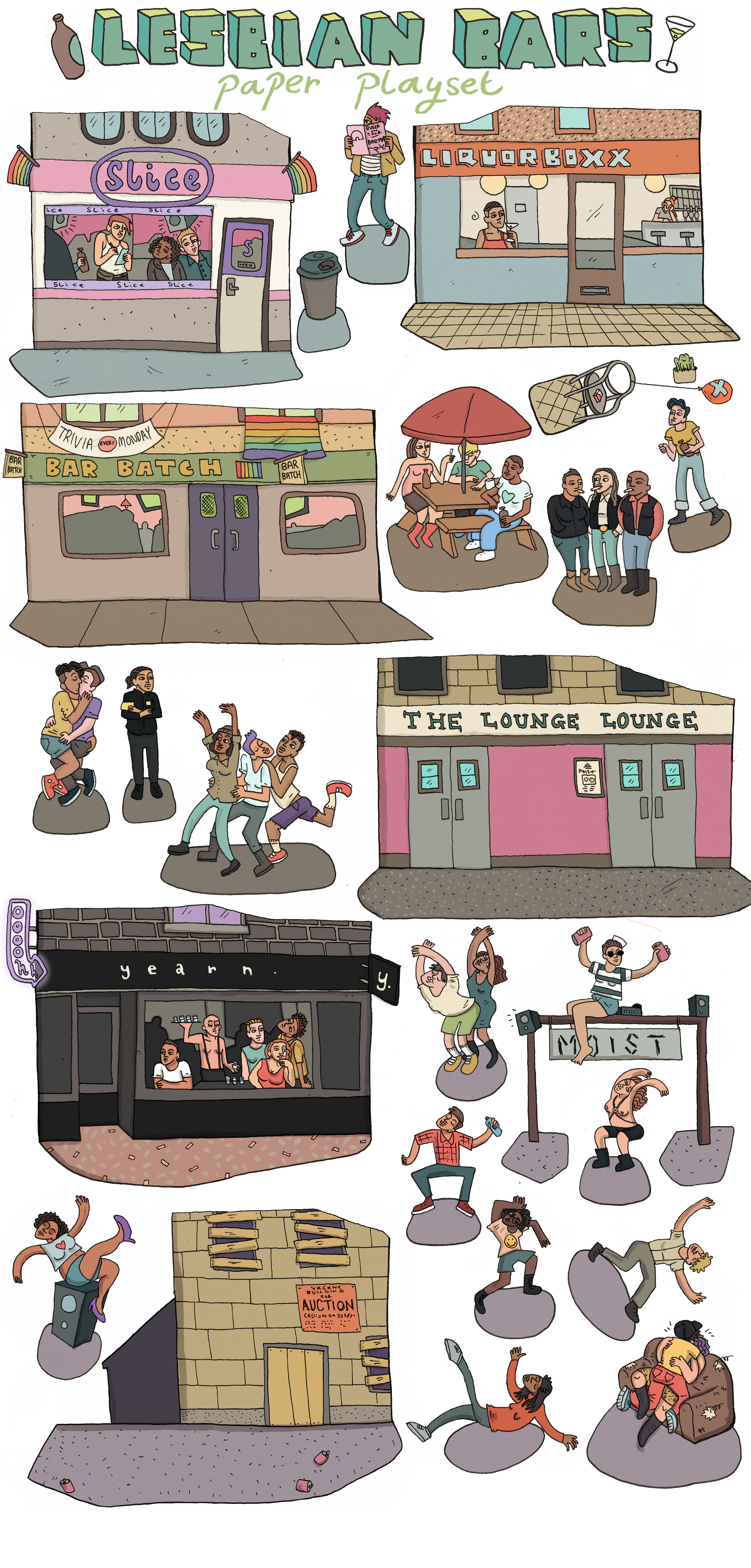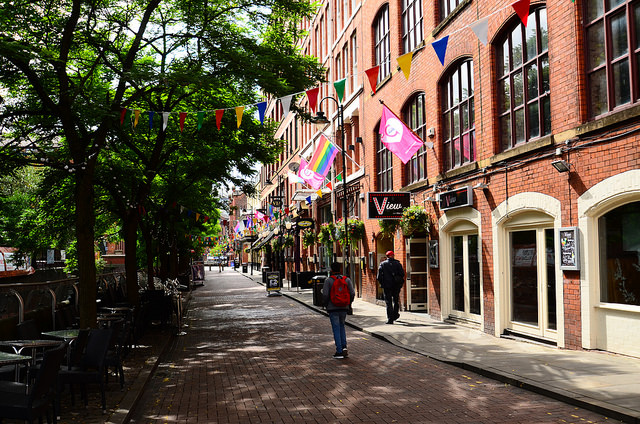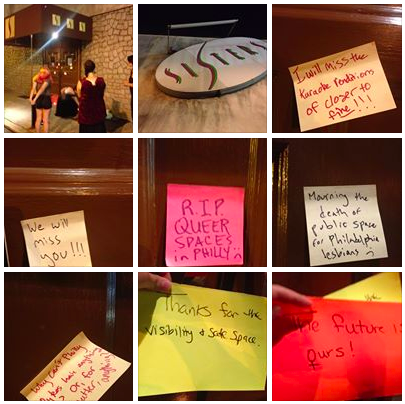Los Angeles Gay Bar The Abbey Faces an Overdue Reckoning
Feature image by FG/Bauer-Griffin/GC Images via Getty Images
This piece contains frequent reference to sexual assault.
I went to The Abbey for the first time in early 2019, a couple months after moving to Los Angeles.
New to the city and looking for queer community — and, let’s be honest, some post-breakup partying — I typed in lesbian bar on Yelp. I followed a mostly empty page advertising “Girl Bar” that ended up just being a defunct offshoot of The Abbey. Already there, I got a drink and did my best to talk to the few queer women amidst the crowd of cis gay men and straight people.
During my first year in LA, this was always the role The Abbey played. Nowhere else to go? Well, fine, let’s go to The Abbey. There are better gay bars on that very block, but with its size, lack of cover charge, and mix of genders — even if many were straight — it was a natural place for desperate queer women with limited options to end up.
But, from the beginning, I’d heard the rumors.
Spoken about with a regretful shrug, like the bar was a predatory actor still winning awards, people passed along warnings about The Abbey. Everyone seemed to know someone who had been drugged.
Open secrets — even ones that reference multiple lawsuits — are only so effective. That’s why it’s both upsetting and a relief to read the recent report on these incidents by Kate Sosin and Steven Blum for The 19th.
“More than 70 people interviewed by The 19th over the course of three years reported going to The Abbey… and experiencing disorientation to varying degrees or losing consciousness,” they write.
The piece goes on to highlight several of these incidents including Yvette Lopez who sued The Abbey in 2013, claiming she was drugged by an employee and then sexually assaulted, and Haely White, an actor and comedian who was sued by The Abbey after posting on Instagram in 2021 about being drugged. (Lopez settled; White is still fighting, “buried in legal fees.”)
It’s notable that most of the women who were drugged at The Abbey are queer. Since many of these incidents took place, bars like The Ruby Fruit and Honey’s have opened, but for years Los Angeles was completely devoid of lesbian bars. There are more dire consequences than boring nights when a lack of spaces exist for queer women and trans people.
This is emphasized by the fact that White was outed by The Abbey when they released a message exchange of White explaining she was on a date with a woman, even though she’s married to a man. “I was framed as a liar,” White said. The truth was her husband knew about the date — they weren’t monogamous even if she wasn’t ready to come out publicly.
Lopez also faced skepticism about her queerness — this time from detectives. She eventually dropped her case, because it was retraumatizing with victim blaming and detectives questioning whether she was, in fact, a lesbian.
Incidents such as these are allowed to continue for so many years, because there is an incentive not to report. Many of the individuals who spoke to the police or even just to management at The Abbey were dismissed or worse. Even White has faced emotional and financial consequences just for posting on Instagram.
In response to one incident when a woman did not report, the piece states: The Abbey said it had no record of this incident and went on to say that “anyone who believes they are a victim of a crime should report it to the police.”
It’s astounding to see this requirement of law enforcement stated by a gay bar. There’s an immense ignorance to queer history and queer present in this demand. I’m not surprised, but I am sick to witness this politic stated so brazenly.
The last time I went to The Abbey, I didn’t go inside. It was June 2020, the day of West Hollywood Pride, and I was at a protest. I asked if I could use their bathroom and was informed only patrons having brunch were allowed to use their facilities. The peak of a pandemic, amidst protests against police brutality, and they wouldn’t let a trans woman take a piss.
I hope this excellent reporting and the brave women who have come forward result in The Abbey experiencing a long overdue reckoning. I also hope there continue to be more spaces available for queer and trans people where we can dance and get drunk and do drugs while also feeling a greater amount of safety and care.
It’s impossible to create a completely safe space, but The Abbey is, at best, complicit and, at worst, entirely responsible for over a decade of harm.
Moby Dyke Is a Fresh Take on the Old Conversation About Disappearing Lesbian Bars
I didn’t go to my first lesbian bar until I was in my early twenties. Whenever I tell people this, they assume it’s because I wasn’t out until then, but actually, I came out almost 10 years before that. In South Florida, where I was born, raised, and currently live, we are flush with gay bars and sporadic parties that “cater to” queer and trans people without always explicitly saying that, but lesbian bars have always been extremely rare. The one lesbian bar that was open when I was young closed in the middle of the aughts, and the one that opened just two years before the start of the pandemic closed for good in the early days of it. So, even before I came out as non-binary, I spent most of my life going to gay bars or mixed spaces or spaces that were neither because that was what we had and my friends and I still wanted to get drunk, do karaoke, dance, and have fun.
As Krista Burton notes in her new book, Moby Dyke: An Obsessive Quest to Track Down the Last Remaining Lesbian Bars in America, the death of the lesbian bar is a well-documented phenomenon. I have written and spoken on the topic here at Autostraddle and on the podcast that I co-host, and there’s writing on it in every publication from The New York Times to Smithsonian Magazine. The set up for most of the research done on the disappearance of lesbian bars is generally the same: What the hell happened to all of them? And then the same statistic from The Lesbian Bar Project is referenced: in 1980, there were over 200 lesbian bars operating in the U.S. and by 2021, the number of lesbian bars still open and operating was 24. Burton’s book starts out similarly, but doesn’t stop at speculation about why this might be or rely on prior research. Instead, Burton decides that to really understand why there are so few lesbian bars around now, she should visit 20 of the bars that remain open to try to understand why so many of them have closed.
The book chronicles Burton’s year-long journey to each of the 20 lesbian bars she chose to visit, and the knowledge she gained on her trips to each of them. She starts her trips most obviously in San Francisco, at Wild Side West, and New York City, at both Cubbyhole and Henrietta Hudson (our beloved Ginger’s was temporarily closed at the time of her trip), but then her search takes her to places that I think will be surprising to a lot of East Coast and West Coast queers: Slammers in Columbus; Lipstick Lounge in Nashville; Alibi’s and Frankie’s in Oklahoma City; Yellow Brick Road in Tulsa; Babe’s of Carytown in Richmond; and Herz in Mobile. Before she embarked on the journey, she set specific rules for herself — such as “I would contact the bar owners and try to interview them, settling for an employee or a regular if the owner couldn’t be reached” and “I had to approach and speak to at least two strangers at every bar” — which yield surprising and fascinating results for both Burton and the reader. The discussions she includes in her narrative of her visits are easily some of the richest, most important parts of the text, making it worth reading just for that.
Some themes pop up in her discussions with bar owners, bartenders, and people who go to the bar regularly. Many of them seem to parrot a lot of the explanations we get for the disappearance of lesbian bars elsewhere: There isn’t enough money in it, the bars have gotten more inclusive over the years (with many of them calling themselves, as Burton puts it, “lesbian bar[s] that welcomed everybody”) which is obviously a good thing but also impacts who comes and who has stayed a patron, and despite some of the progress we’ve made in our society over the last 43 years, it’s still hard as hell to be a female business owner or try to be one. These explanations aren’t very surprising to Burton (or me) but what is surprising are the responses to these explanations. The people Burton encounters aren’t upset or distraught about how open these spaces have become in terms of people of varying sexualities and gender identities necessarily. They have just noticed that as the world has become more accepting of queer people overall, queer people seem to have walked away from these spaces a bit. In one of Burton’s conversations with Lisa Menichino, the owner of the legendary Cubbyhole in NYC, Lisa says, “I think sometimes a lesbian bar is like an old friend you’ve spent a lot of time with and then drifted away from. Queers think of the bar fondly, and there’s a huge out-cry if one closes, but they forget that in order to have the bar, they need to come hang out there.”
Although the book starts out with a few common questions, Burton’s quest for understanding evolves as she keeps going on her lesbian bar trips. By the time she gets to Herz in Mobile, one of my favorite parts of the book, her exploration changes from trying to figure out why these bars keep closing to truly celebrating and trying to situate these spaces among what she already knows, understands, and loves about queer culture. At Herz, she comes face-to-face with many contradictions she doesn’t expect. As Burton explains in this chapter, Alabama has some of the most draconian anti-queer and anti-trans laws in the country and explains, “I can’t imagine it had been easy to be Black lesbians trying to open a lesbian bar” there. When Sheila Smallman, one of the owners of Herz and a former chief of police, tells Burton that the bar was actually well-received and widely accepted by the neighborhood it’s in, Burton is shocked and Sheila clarifies by adding what she thinks makes that possible: “We only have two rules in here. Number one: no politics. Number two: no religion, and we mean it!” The contradictions she encounters at Herz push Burton to grapple with different, more important questions about queerness and queer culture than she ever intended to, and realizes, “Everyone is someone you can’t put in a neat little box, of course, but it’s something that’s easy to forget. Hertz was special, I decided, not because of what it was, but because it was Sheila and Rachel’s bar, a space they had created for all of us, gray areas included, in a place where it’s amazing a lesbian bar even exists.”
As we move through the bars with Burton, we also move through some stories of Burton’s life as a femme lesbian coming from a deeply religious and difficult upbringing married to a trans man. Burton introduces us to her husband early on, and we get glimpses of her most impactful queer friendships as she travels from city to city and is reminded of certain pivotal moments in those friendships. These recollections and reflections serve as a kind of glue for all of the moving parts of this narrative and help answer the “So what?” question that might be on some people’s minds as they begin the book or try to get through it. Burton, as we find out through the revelations she included in the book, is genuinely invested in the survival of lesbian bars because that’s where she experienced some of the most important moments of her life so far, where she learned to be herself, and where she felt the most comfortable as a young queer trying to navigate a world that doesn’t want young queers to survive it. She also very thoughtfully includes some personal reflections on gender inclusivity and what that means for her and her husband as they visit these spaces and daydream about frequenting them more regularly. These pieces add the emotional weight that might be necessary for both queer and non-queer readers, especially younger ones, to understand why these spaces are so sacred to so many of us and why we lament the fact that there’s so few of them around.
By the time you get to the epilogue of the book, Burton notes that “The trajectory for lesbian bars is finally moving upward” and makes it a point to shout out the bars in Chicago and other places that have opened since she completed her trip. It serves as the optimistic end to a book already brimming with optimism about these spaces and their ability to stay open against all odds. Burton might not definitively answer all the questions she originally set out to, but what she does do is give us more reasons to keep believing in the power of collectivity and community and getting together with your queer siblings and partners at your local spot at the end of a tough ass day. At the end of the book, Burton reminds us: “It doesn’t matter what you wear. It doesn’t matter who you came with. What matters is you’re there. The only thing lesbian bars need is you.” And those of us who are able should heed the call.
Why Do Lesbian Bars Keep Disappearing?
Feature image by NoSystem images via Getty Images
On a recent episode of the research and education oriented arts and culture podcast I co-host, Fat Guy, Jacked Guy, I brought attention to something I think more people should care about and that’s been on my mind a lot: the gradual disappearance of lesbian bars here in the U.S.
LGBTQ history is an area that I considered myself very well-versed in, but when I began the research for that episode, I realized I didn’t know as much about the contemporary reasons (and excuses made) for their disappearances as I thought. I’ll admit my own experiences with lesbian bars is amateur-ish at best. I don’t have a long, personal history of going to lesbian bars, because of some of the reasons I’ll get into here, but also because of where I grew up and have lived my whole life.
I came out as gay to myself and to my friends when I was 14-years-old, and in response, some of them ended up coming out, too. Being young and queer in 2002 was a truly surreal experience. Although we were able to use the internet to gather resources and make some connections to other young queer people, there wasn’t really an easy or accessible way for us to truly learn more about ourselves, about the history of people like us, and about being queer in general. Often, we had to listen to people from BOTH SIDES, not just the far right or the moderate left, openly question and debate whether or not queer people deserved to be as protected under the law as they were. We had “allies,” of course, but that didn’t make things much easier when your high school history teachers were allowing kids to openly debate the merits of “same-sex” marriage in class. In addition to that, we had very few — almost none, actually — models of what it looked like to be a healthy and successful queer person in mainstream media.
My queer friends and I did have one slight, unusual advantage, though. Not too far away from where most of us lived, there was and still is a small “gay village” called Wilton Manors situated just north of downtown Ft. Lauderdale (actually, we did an episode on this, too, if you’re interested). Wilton Manors is the first place where I ever saw gay people in real life just acting like their gay ass selves. Men on the streets holding hands, wearing leather and bondage gear, kissing on street corners. Mostly men, though. Sometimes women, but rarely, and usually, it was because they were hanging out with a larger group of guys. There weren’t a lot of people of varied gender experience, either, which I guess speaks to both the time and the way the neighborhood used to be. But it was what we had, and by the time we were old enough to drive, we were hanging out in the coffee shops and, eventually and illegally, hanging out in the gay bars of Wilton Manors as much as we could.
There was one lesbian bar in Wilton Manors, but by the time it gained popularity, our trips to the strip were getting more and more sparse. By the end of the early 2000s, there were tons of clubs and parties at clubs that were definitely borderline queer but open to everyone popping up in South Florida. Overall, they were “cooler” and younger-leaning than the bars in Wilton Manors and the long-running gay clubs on South Beach, so we started going to these mixed spaces a lot more. I didn’t actually end up going to my first lesbian bars until a couple years later on a trip to NYC, where in one weekend, some friends and I went to both the legendary Cubbyhole and to Ginger’s. Those spaces were much different from what I’d experienced back home. People were more radical, more gender exploratory, more punk, more like me and my friends. After that trip, I was jealous that they had a brick and mortar place to go to every weekend, when we had to follow parties and queer nights that bounced from venue to venue every few weeks or didn’t happen at all.
Those parties and queer nights I mentioned are still pretty much a mainstay in South Florida, but New Moon closed in 2014, and many of the remaining gay bars are, as they always have been, basically for men. It’s really tempting and compulsory to look at this as a distinctly South Florida problem, but it isn’t. It’s an everywhere problem.
Before we get to the end though, I think it’s important we take a step back and examine how we got here in the first place. Let’s jump into some dyke history, shall we?
A short history of the American lesbian bar
I think it’s important to situate the development of the lesbian bar within the broader context of American social history. As we all know, cis women have never enjoyed the same freedoms as men, and in the first half of the 20th century especially, there weren’t many places outside of the domestic sphere where women could come together with other women. So, you can imagine the empowerment that comes with being in a space devoid of cis men, which lesbian bars frequently were. Since the inception of the lesbian bar, these spaces have often been more than just a watering hole for queer women. Many lesbian bars throughout the 20th century served as places for women to gather to do community organizing work, to take care of each other, to get healthcare, and to just generally help out the communities where the bars were located. In these spaces, women of all ages were able to come together and build community and camaraderie in a way they couldn’t in any other place. This is not to say that lesbian bars have always been sites of resistance against white supremacist, heteronormative culture, but I do think it’s important to point out that community formation and support was an important part of their function in queer culture and society, even if the members of that community weren’t as revolutionary as we wish they were.
It’s widely accepted that the first lesbian bar to open in the U.S. was Mona’s 440 Club in San Francisco, California in 1936. According to Nan Alamilla Boyd’s book, Wide Open Town: A History of Queer San Francisco to 1965, Mona Sargeant and her husband, Jimmie, originally established Mona’s as a “bohemian” spot to take advantage of the ending of prohibition and the ever-expanding culture of tourism growing in the San Francisco area. It was mostly open to writers, artists, and sexual “deviants” of any flavor but quickly became well-known for its mostly female staff, clientele, and popular drag king shows after Mona and Jimmie noticed a desire for more clubs of this persuasion in the area. In archival material from Mona’s bar, including ashtrays printed with the logo, Mona’s advertised itself as a place where “Girls could be boys.” Many of the performers at Mona’s were butch women, often performing to a mixed audience of butch and femme women, “straight” women, and gay men. Mona’s clientele was interesting because it was frequented by lesbians and also by supposedly straight women whose husbands were away at war. Many of the performers at Mona’s were butch women, like the legendary Gladys Bentley, often performing to a mixed audience of butch and femme women, “straight” women, and gay men. Mona’s 440 Club stayed open — eventually changing ownership to Ann Dee who changed the name to Ann’s 440 Club — until the late 1950s. And while it’s certainly true that Mona’s broke barriers and influenced the opening of bars like it across the U.S., calling it the “first lesbian bar” is actually somewhat historically inaccurate.
Because the Prohibition of the 1920s drove all bars to go “underground,” there’s a lot of queer bar history that either wasn’t well-documented or is just not very well-known. Mona’s 440 Club might have been the first official lesbian bar, but the first-documented bar-like hang out for lesbians, Eve’s Hangout, actually opened 12 years before Mona’s 440 Club in the Greenwich Village neighborhood of New York City. Eve’s Hangout wasn’t technically a bar because it wasn’t allowed to be, but it was established specifically as a “tearoom” for women (of course, it was more specifically for lesbians), immigrant writers and artists, and Jewish people. Eve Addams, a Polish immigrant to the U.S. and the founder and operator of Eve’s Hangout, opened the tearoom at 129 MacDougal Street in 1925. Unlike Mona and Jimmie Sargeant, whose sexualities are unknown and probably heterosexual regardless of the fact that they opened Mona’s 440 Club, Addams was an out and proud lesbian looking to create safe spaces for women like her here in the U.S. Eve’s Hangout frequently “hosted after-hours, locked-doors meetings, where women-loving women could share their experiences without fear of censorship or discrimination.” Supposedly, Eve also hung a sign on the door of the tearoom that said “Men are admitted but not welcome.” It didn’t take long for the Hangout to become one of the most popular spots in the area, drawing the attention of not only queer people but also the local police. Eve’s Hangout was shut down in 1926, and, tragically, Addams’s work at the Hangout and in the community led to her eventual arrest, deportation, and death at Auschwitz in the early 1940s.
Throughout the 1940s, 1950s, and 1960s, more lesbian bars opened in big cities (and some small towns) all over the U.S. Most of these places were male-owned because, unfortunately, women couldn’t be trusted with handling their own money and property until the 1970s. Many of the lesbian bars that opened during this period were owned by male landlords and run by their female tenants. This fact is pretty widely known when it comes to LGBTQ history, but one of the biggest benefactors of the lesbian bar business was the Italian Mafia. Because banks were reluctant and/or completely unwilling to fund women-owned businesses during this time, the Mafia was one of the few places women could go to get loans or to rent property for their businesses. I don’t want anyone to be confused in thinking that the Mafia is some progressive organization. The truth is, they didn’t care what these women were doing as long as they got their kickbacks. But the relationship between the women who ran the bars and the men in these organizations was certainly interesting. Of course, because they were interested in keeping these businesses open, they often paid off police to stop raiding the bars and other members of the community to keep quiet about the bars’ locations. As we know, this didn’t stop raids from occurring but it is so wild to imagine a Tony Soprano type paying off part of the NYPD to keep some place called Kitty’s Hideaway (or something similar) open.
While lesbian bars were often a refuge for queer women (and some men), it doesn’t mean they were safe and welcoming spaces for everyone. Lesbian bars during this period were usually racist and less open to trans people and people of varied gender experience. It’s obviously not as well-documented as it should be but queer Black women, even in places like New York City and San Francisco, mostly weren’t welcome in these spaces and couldn’t be part of the scene. For Black queer women, house parties — which was actually showcased in episode six of A League of Their Own — were the main way they were able to gather and celebrate themselves and each other. In the 1950s, the lesbian bar scene shifted somewhat with more bars being opened for working-class lesbians in big cities, especially. These bars were more racially diverse, but still not free of racism or white supremacist definitions of sex and gender. And although trans people were often part of the gay and lesbian bar scene, they weren’t exactly welcome with the kind of enthusiasm you’d expect. Because of the story of the Stonewall Uprising, people have a tendency to think trans people were embraced as members of the community, when the opposite was usually true. In addition to that, at this time, lesbian culture was, of course, dominated by a binary understanding of sex and gender that was liberatory for some and exclusionary for others. Of course, as culture changed, many lesbian bars became sites that were more welcoming of Black women and women of color and less binarist thinking. But I think it’s important to give a full picture of their evolution into the second half of the 20th century.
By 1980, there were over 200 lesbian bars around the country. 200. That’s actually quite a lot. But as of 2021, the Lesbian Bar Project has recorded that there are only 24 left in the U.S.
What the fuck happened?
Where have all the lesbian bars gone?
There are so many myths about why lesbian bars close and/or don’t survive. So many. There are two that I’ve heard more times than I count. The first is, old reliable, “queer women just don’t party the way queer men do.” When people say this, they say it like it’s a scientifically verifiable fact. I don’t know if “willingness to party” can be measured in any real way, so this just feels like a cop out that people use to hide something much more sinister or difficult to discuss. If we consider the way the society around us works, it makes more sense that being a woman who owns a business that specifically caters to women is extremely difficult. As it is, women already earn less than men, and the more marginalized your identity is, the less you make. This alone puts women at a great disadvantage when it comes to entrepreneurial efforts, but there are also systemic issues that prevent these businesses from staying open or opening at all. From the advent of the lesbian bar, men have had to play some kind of role in their operations, so we can infer what it means when men aren’t involved. Businesses owned by women simply don’t have the same survival rate as businesses owned by men due to a variety of factors, including obtaining bank loans to help keep their businesses afloat when they need it. This means that, since the early 1990s, lesbian bar after lesbian bar has closed its doors for reasons that are structural and completely unrelated to how frequently people show up in these spaces.
Many studies done on this have found just that: a series of structural and systemic issues that have caused the lesbian bar scene to putter out. According to an article in The Story Exchange, one of the biggest factors is money:
“We all know women earn less than men — in 2019, women make $0.79 for every dollar men make — but the disparity can be even more pronounced in lesbian women. Based on a recent study by the UCLA School of Law, LGBTQ-identifying individuals suffer economically across the board with higher rates of unemployment and lower incomes, among other categories. Coupled with the obstacles that women business owners face when it comes to access to capital, it can be difficult for female-owned lesbian bars that rely on female customers to stay afloat. In cities, which tend to be more liberal than, say, rural communities, the demise of the lesbian bar seems counterintuitive. For example, San Francisco has one of the highest LGBTQ percentages in the country, so it would seem that lesbian bars would have an eager and available clientele. The problem, however, is urban gentrification. Techies and creatives, most of whom are well-paid males, have moved in — pushing out a female demographic that doesn’t earn enough or wield enough disposable income to patronize bars.”
In South Florida, we currently don’t have a single lesbian bar across three counties. New Moon has been closed since 2015, and the only other lesbian bar to open in Wilton Manors, named The G Spot (I know, I know), did so about 2 years before the COVID-19 pandemic and then closed as a result of it. Of course, I don’t know the individual stories behind these closures, but I do know about how much the neighborhoods and the cost of real estate have changed down here in the last seven years, and their closures track with the reasons given in the article mentioned above.
As I said, people cite other factors for why lesbian bars have closed down over the years. In an article in the Smithsonian, they discuss that “Lesbian bars have struggled to keep up with rapid societal changes, including greater LGBTQ acceptance, the internet and a more gender-fluid community. With dating apps and online communities, bars aren’t necessary for coming out and connecting with queer women.” And Gwendolyn Stegall states that many queer people “claim that ‘lesbian’ leaves out bisexual women and trans people, who definitely have been historically (or even sometimes currently) shunned from the community.” I definitely don’t disagree that some queer people feel this way. In fact, I think I probably had a bit of a moment thinking this when I was struggling with my gender dysphoria and trying to figure myself out. It’s also very real that there are lesbians out there who are transphobic and heteronormative, which impacts the way spaces are created and patronized. But I don’t think we can say that this is actually a factor in whether or not these businesses survive because although gay bars have faced some similar criticisms, their existence isn’t threatened in the same way, and they don’t suffer the same rate of closure. In fact, if I’m using my neighborhood as a small case study for these phenomena, all of the gay bars made it through Covid, and two new ones even opened up in the midst of it.
To me, it goes straight back to the fact of access to capital. Gay men have a lot more access to capital than lesbians and trans people do as a result of the structure of our society. I don’t think you can untangle that fact from this situation. They have simply always had more money to invest and more money to spend, and it feels like talking about anything else beyond the fact that women and trans people still can’t get what they need is just a distraction.
And I’m not interested in being distracted. The Lesbian Bar Project certainly managed to bring some attention to the issue over the last two years, but similar to how these bars have been disappearing over the years, that attention seems to be fizzling out. I don’t disagree that some of the spaces that have historically catered to lesbians are outdated in terms of their concepts and inclusiveness but I do think there is still a need for places outside of the internet that specifically cater to queer women and trans people. In the last ten years since my friends and I followed queer nights from place to place, my feelings and my life have changed a lot. I don’t go out in the same way I used to, but I still feel that tinge of desire again for a place where I can go often and be with lesbians and queer women and people like me, gender freaks of lesbian experience. Maybe because I’m getting older, I just want to have a place that I can be a regular at and also feel completely at ease. I have a lot of wonderful people in my life, but sometimes, I just want to go out and have a drink surrounded by people who truly, truly get it.
I don’t think it’s a secret that many LGBTQ people feel as if they don’t have a strong network and/or unified community of other queer and trans people in their local areas — I know I feel that way, at least. These spaces have historically been the sites of not only connection and celebration but of resistance and taking power for ourselves. They’ve been places where we can dance all night and then rally together in the morning to fight back against the powers that are trying to destroy us. I often wonder how much different the world would be if we still had these spaces of so many possibilities, these spaces where we could meet friends or make new ones, fuck in the bathrooms, do drugs safely, drink, host writing groups or knitting circles or open mics, listen to live music, have afternoons to engage in resistance studies together, plan radical actions and have the organizing space to act on them, take care of each other in a variety of ways, or just grab a drink after work. I wish we were still willing to fight for these spaces, and I wish we could experience them together as Addams and so many others like her were years ago. We not only deserve them, but we desperately need them.
13 Photos of Dyke Culture Between 1988 and 2003, by Phyllis Christopher
feature image: Phyllis Christopher
In the late ’80s, photographer Phyllis Christopher moved to San Francisco, where she documented protests, queer nightlife, and more. She later became a contributor and photo editor at the lesbian erotica publication On Our Backs, where she worked one-on-one with models who shared their own kinks and curiosities in its pages.
Earlier this year, Christopher published a collection of her black-and-white photos from this era called Dark Room. The book also includes writing from Susie Bright, Laura Guy, and Michelle Tea, as well as an interview with Shar Rednour. In June, I interviewed Christopher about her life and creative process, and she has generously offered to share more of her photography with us.
I love these photos. They feel joyous and hot, and they capture an underground dyke culture that was loud, ferocious, and teeming with sexuality.
If you like what you see and want to see even more, purchase Dark Room online from Book Works. And if you’re near San Francisco, you can attend the San Francisco book launch for Dark Room on Sunday, August 21st, from 3pm to 5pm at the Folsom Street Community Center. Phyllis will be joined by Susie Bright, Laura Guy, Shar Rednour, and Michelle Tea. Carol Queen will host.

San Francisco, CA – 2000 (Photo by Phyllis Christopher)

Karin – Buffalo, NY – 1988 (Photo by Phyllis Christopher)

Queer Nation visibility action at Concord Mall – Concord, CA – 1990 (Photo by Phyllis Christopher)

Dancers – Club G Spot – San Francisco, CA – 1989 (Photo by Phyllis Christopher)

Pro-Choice March – San Francisco, CA – 1989 (Photo by Phyllis Christopher)

Elvis Herselvis at Klubstitute – San Francisco, CA – 1991 (Photo by Phyllis Christopher)

Alley, South of Market – San Francisco, CA – 1997 (Photo by Phyllis Christopher)

Cartoonist Kris Kovick- San Francisco, CA – 1992 (Photo by Phyllis Christopher)

Flannel Fetish Tribute for On Our Backs – San Francisco, CA – 1991 (Photo by Phyllis Christopher)

Daddy’s Boy – San Francisco, CA – 2000 (Photo by Phyllis Christopher)

Michou and Cooper – San Francisco, CA – 1997 (Photo by Phyllis Christopher)

Tribe 8 – San Francisco, CA – 1995 (Photo by Phyllis Christopher)

San Francisco, CA – 2003 (Photo by Phyllis Christopher)
Which Historical Lesbian Bars Would American Girl Dolls Have Visited?
Let’s just take it as a given that American Girl characters are queer icons. I’m a Molly, if you couldn’t tell, but also with strong Kit tendencies. I’m saving my “American Girl Made Me Gay” essay for another day, but let’s be clear that that’s where I’m coming from.
Thanks to the incredible work of Allison Horrocks and Mary Mahoney at the acclaimed American Girls podcast, I’ve been thinking a lot about how my childhood fascination with the historical American Girl books shaped my lifelong love of history (the early 20th century in particular). In wondering how these stories shaped the person I’ve become, I’ve also become curious about how the characters I love might have grown up. These stories, for me, are so closely connected to their chronological settings; Molly is the 1940s girl, Kit is the 1930s girl, etc, and imagining them older, in subsequent decades, lets these vibrant characters expand beyond their original narrative confines.
So let’s imagine these adorable queer icons as they’d be turning 18, maybe figuring things out, maybe beginning to search for queer community. What community spaces would have been available to them as they entered adulthood? What bars would they be sneaking into? What might their queer lives have been like?
Samantha Parkington — born 1895, turns 18 in 1913

Because Samantha’s original books are set in 1904, I’m counting her as my first 20th century girl, and what a helluva start to the century she represents. A lot of Samantha nostalgia centers her luxurious accessories, but beneath all the frills, Samantha is the badass femme queen we all deserve. Growing up with her bicycling suffragette Aunt Cornelia, how could Samantha become anything other than a legend? Her civic-minded progressive labor politics are central to her story and I can see her growing up to do further community outreach and advocacy work, probably as one of those SpinstersTM who totally had a “historians will say they were friends” kind of partnership. As historian Lillian Faderman notes, at this point in time there weren’t many bars where women could go; Samantha would more likely have found her queer family at a ladies’ club or activist circle. However, by her mid-to-late twenties, I know in my heart Samantha would’ve been sneaking off to speakeasies with her, ahem, ~best friend~ Nellie and reading Radclyffe Hall.
Rebecca — born 1905, turns 18 in 1923

Rebecca wasn’t yet part of the story when I was a kid, but god I wish I’d had these books when I was in the thick of my A Tree Grows in Brooklyn phase. Rebecca grew up in New York during peak Edith-Wharton era, and would be 18 just as the 20s were really starting to roar. Prohibition was in effect from 1920-1933, but let’s be real: this girl’s too resourceful not to find the best house parties and speakeasies. By the early 1920s, bars in the West Village were growing devoted gay clientele, like one which in 1929 would be renamed Marie’s Crisis (and which remains a beloved gay piano bar.) However, I like to imagine Rebecca in community with Eve Adams, subject of a superb recent biography by queer historian Jonathan Ned Katz. Eve Adams was a Jewish immigrant from Poland who traveled around America distributing radical leftist literature, and whose 1925 book Lesbian Love was burned for being ~indecent~. Additionally, Eve Adams opened a salon and tearoom in Greenwich Village called Eve’s Hangout where queer community congregated — I picture Rebecca here, probably with a copy of The Autobiography of Alice B. Toklas by Gertrude Stein.
Kit Kittredge — born 1923, turns 18 in 1941

Oh Kit, rough-n-tumble butch queen of my heart. Typing up her own newspaper on a clattery typewriter, building a scooter out of fruit crates, playing baseball, and dressing as a boy to ride the rails and learn firsthand about Depression-era “hobo” culture, it’s safe to say we know that Kit grew up to be a badass. She’d be coming of age in wartime Cincinnati, when military necessity led to the town’s industrial boom. As a center of manufacturing, Kit would’ve had no trouble finding a job — can’t you picture her, Rosie-the-Riveter-style, slinging heavy machinery around and looking very at home in her shop floor coveralls? Especially during the war, working-class lesbians congregated at dive-ier bars, often close to the plants for an after-shift drink; this is the generation who would’ve been the elders in Stone Butch Blues. These bars haven’t received the level of historical preservation I think they deserve; since they so seldom advertised themselves as the de facto queer community centers they were, it’s hard to name for certain any specific institutions Kit might have frequented. However, Cincinnati’s current vibrant LGBTQ+ community from the 60s onward didn’t come from nothing. We know there must’ve been somewhere for Kit to get a drink and cruise for crushes after a long shift. By the time of Cincinnati’s first pride parade in 1973, Kit would have been 50 years old — a beloved butch elder, I imagine, at the front of the parade.
Nanea Mitchell — born 1932, turns 18 in 1950

Nanea is Hawaiian, living in Honolulu during the Pearl Harbor attacks. I want to shout out here how great it is to see another indigenous character added to the lineup, and with such rich and attentive historical specificity. Nanea witnesses the attack directly herself; a large part of her plotline is about recovering from this trauma and from the ensuing separation from her best friend Lily, whose family is forced to the mainland by the enforcement of Japanese internment. Even against this harrowing backdrop, wartime Honolulu was a fascinating place — acclaimed female pilot Cornelia Fort was stationed there, teaching men how to fly, when she witnessed the Pearl Harbor attack from the air, and you better believe that those fantastic, fierce lady pilots were, ahem, yknow. Nanea herself is a creative, headstrong, often-impulsive girl with a penchant for Nancy Drew novels. (Did Nancy Drew make me gay? Probably not, but having a hot girl sidekick named George sure didn’t hurt the cause.) By the 1950s, I don’t doubt that teenage Nanea wouldn’t be having any trouble shaking up gay adventures. Especially in proximity to military bases like the ones in Honolulu, gay and lesbian bars had sprung up like clover; you can read all about them in Coming Out Under Fire, about how wildly gay the WWII-era forces were, and where some of the interviews were even contributed by lesbian former-WACs still living in Honolulu.
Molly McIntire — born 1934, turns 18 in 1952

Molly’s stories are set in Jefferson, Illinois, which I take to mean Jefferson Township outside of Chicago; heading into the city, then, as an 18 year old, Molly would be walking into the thick of McCarthy-era vice raids and mob-controlled underground bars. (If you thought Molly would grow up into some straitlaced boomer, think again.) The Andersonville area of Chicago remains to this day a queer haven, but back in Molly’s day the scene looked rather different. This extensive entry in the Chicago Encyclopedia and this piece from the Chicago Tribune outline the context of the community Molly would’ve encountered, including the vibrant community led by Black LGBTQ+ people that coalesced on the South Side and included popular and long-standing mixed-race drag balls which lasted well into the 1950s. In addition to these gatherings, Molly’s main South Side bars would have probably been places like Mommy-O’s (what a name!) and The Fiesta, where she would’ve risked police surveillance or harassment, particularly if she butched it up beyond the law’s unofficial rule that people had to be wearing at least 3 items of clothing designated for their assigned sex. (May they roll in their graves at the sight of us now!). Nowadays, there are tours available of Chicago gay neighborhood history, and these interviews with patrons of Chicago’s lost lesbian bars give us a glimpse into the scene as it would’ve developed after Molly’s coming-of-age.
Maryellen Larkin — born 1945, turns 18 in 1963

Maryellen is a more recent addition to the Historical Characters line, and I love her whole vibe. She’s a polio survivor, adventurous and creative and headstrong, and she works in her family’s seaside diner in Daytona Beach, Florida. This girl is a bartender in the making if ever I’ve seen one, complete with opinions about what goes on the jukebox! Over at Dishing with Mark and Carrie, local legends in the queer community have also compiled an informal, unverified, entirely delightful rundown of Florida Bars That Were. Most of these bars catered primarily to gay men, but they speak to a lively and long-standing queer community in Central Florida. About an hour away from Maryellen in Orlando, she’dve had options like those compiled here by the Florida LGBTQ+ Museum, including Palace, which opened in 1969 and later became home to Face to Face, aka Faces, the first bar for LGBTQ+ women identified in Central Florida. Maryellen might even have been around the same age as the belovedly eccentric mother in Kristen Arnett’s Gay Florida Masterpiece Mostly Dead Things, no? I bet we’d see some gay taxidermy at her bar.
Melody Ellison — born 1954, turns 18 in 1972

God, I wish Melody had been around when I was a kid! This is a girl raised on Motown, coming up in Detroit during its industrial boom, and already (look at that Mary Tyler Moore style outfit!) a pop culture icon. Where was Melody when I was making my dad blast Motown classics radio on the way to school? She and I love the same artists — Martha Reeves and the Vandellas, Marvin Gaye, and the like — and Motown was much like Hollywood in its draconian enforcement of straight femininity in its artist contracts despite the popularity of bands like The Supremes with openly queer fans. You can find out more about the queer Motown milieu in the delicious mystery novels by Cheryl Head, which feature a queer Black private investigator! By the 70s, however, white artists closely connected with the Motown crew like Dusty Springfield were publicly out, and the rise of disco was creating an environment more openly welcoming for queer artists of color. Black lesbian organizing was gaining momentum as well; while the Black Lesbian Caucus was based primarily in New York, their newsletters had national circulation, and groups like the Salsa Soul Sisters offered Black and Latinx women an alternative to often-racist and otherwise discriminatory bar spaces — groups and networks like these are where Melody might’ve gotten her best recommendations! Over at this interactive map, you can watch the expansion (and, sadly, contraction) of the Detroit gay bar scene, based on data assembled by historian Dr. Tim Retzloff.
Julie Albright — born 1966, turns 18 in 1984

Oh, this sweet little long-hair-butch San Francisco sports gay. By the time Julie would’ve been coming out, the scene documented in historian Nan Alamilla Boyd’s iconic book Wide Open Town would have been a thing of the past and San Francisco’s icon Mona’s (440 Broadway, ‘Where Girls Will Be Boys’) which is often credited as the first openly lesbian bar in America would have been closed for a while. We can’t forget that the mid-eighties would’ve been right as the AIDS crisis accelerated, and a team player like Julie wouldn’t have been able to escape the urgency of this moment. However, in addition to community organizing, and queer women’s volunteer efforts to support HIV and AIDS patients, I like to imagine her in such options as Amelia’s, Wild Side West, and the iconic Maud’s, subject of the magnificent and profound documentary Last Call at Maud’s that you can stream for free online via your local library. Personally, I’m betting that Julie would’ve been fielding Maud’s softball and basketball teams, and driving the girls to the bar after practice in her beat-up van. She strikes me as a cold beer kind of gal.
Courtney — born 1976, turns 18 in 1994

So, like, we know they made Courtney her own doll-sized American Girl doll (Courtney’s a Molly; same, girl, same) — are they going to make Courtney little doll-sized copies of Dykes to Watch Out For too? Courtney grew up in Southern California in the 80s, and by the mid-90s I bet she’d have found her way to Los Angeles, which for a time was an unofficial capital of lesbian bars. The longest-running appears to be The Palms in West Hollywood (which operated from the 60s until its closure in 2013), and many more from that neighborhood are represented in the holdings of the local June Mazer Lesbian Archives, where oral histories have helped patch together this history of earlier bars in the area dating back to the 1950s. Latinx and Black lesbians, however, congregated in East LA, where bars like Kitty’s are immortalized by the ONE Archive LGBTQ+ Research fellows. The number of such bars over all of LA has plummeted, sadly; this 2019 article by a local queer paper and this one from the following year highlight the erosion brought on by gentrification and other forces.
I’m just getting started — queer history didn’t begin in the 20th century, and the 18th and 19th century American Girl characters deserve their queer lives imagined too. Keep your eyes peeled for Part 2 featuring beloved characters Kaya, Felicity, Caroline, Josefina, Kirsten, and Addy!
In the meantime, if you’d like more information about the past, present, and future of LGBTQ+ bars and community spaces, I recommend searching out a secondhand copy of the Our Happy Hours anthology, edited by LGBTQ+ literary legend Lee Lynch in the aftermath of the Pulse Shooting, for its firsthand accounts. More wonderful anecdotes can be found in this VICE documentary done by JD Samson, and in the recent Lesbian Bar Project committed to supporting and promoting the remaining bars across the country. If you’ve got any historical insights or modern-day recommendations for queer bars and community spaces worth supporting, lemme know all about what I’m missing out on in the comments!
Meet The Owners of Herz, a Lesbian-Owned Bar in Alabama
There are currently twenty-one lesbian-owned bars in the United States in 2021, down from nearly 200 that existed in the late 80s. A decline of this stature was unsettling and dumbfounding. Had we digressed in some capacity? Was this some conservative-won plight to eliminate our spaces?
When I first learned this fact from my friend Byrdie O’Connor, the producer of the Lesbian Bar Project, there was an unspoken, I know. Can you believe it? between us. I immediately assumed that the majority of the remaining lesbian-owned bars were in New York, San Francisco, and Los Angeles, minus A League of Her Own in Washington D.C.. But Brydie shook her head. Only three in New York (Henrietta Hudson, Cubbyhole and Ginger’s), one in San Francisco (Wildside West), none in Los Angeles.
Where are the rest? They’re splattered all over the country, from the Midwest to the South, including a bar called Herz in Mobile, Alabama.
Hearing about Herz sparked a specific curiosity in me. I wanted to know what was keeping it alive, so I got in touch with the women behind the Lesbian Bar Project, and with the owners of Herz.
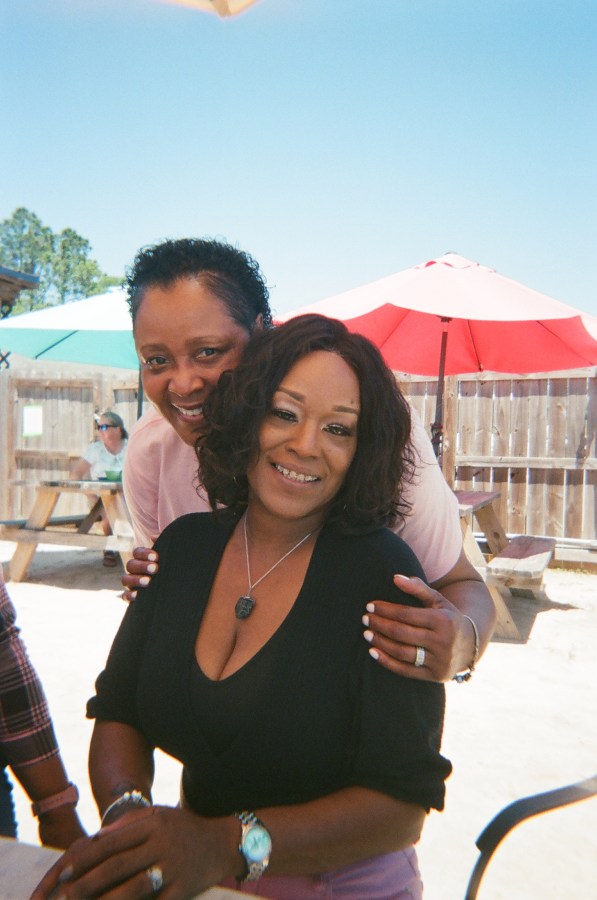
photo by Brydie O’Connor
“It’s a multi-faceted issue, of course. But one of the main reasons has to be gentrification. I think it’s less of an issue in the Midwest and parts of the South,” said Erica Rose, one of the Lesbian Bar Project’s directors. “Gentrification wipes out marginalized communities. There’s a major wealth gap, and a lot [of LBTQ business owners] just can’t keep up with the rising rent in gentrified cities.” A pay gap still exists between women and men, a fact that increases for LGBTQ+ individuals. Thus, our opportunities to open and maintain businesses are not always plentiful, gentrification aside. LGBTQ+ clientele bases are also smaller than their cis-heterosexual counterparts, making it that much more difficult to make ends meet depending on the queer population size. Rising rents, both residential and retail, often end with the ostracization and removal of marginalized housing opportunities and businesses. While New York City houses one of the largest populations of LGBTQ+ people in the United States, it’s also one of the most gentrified cities in the country. It makes sense that only three of the estimated 25,000 bar and nightlife establishments in New York City are lesbian-owned and centered. New York City follows San Francisco and precedes Los Angeles on the list of most gentrified cities, two of the other most LGBTQ+ inhabited cities in the U.S.; the former houses one lesbian-owned bar, and the latter has none. When marginalized communities are pushed out of cities, or forced into financial struggle to remain there, their businesses suffer or cease to exist. The communities they serve also suffer.
The owners of Herz, Rachel and Sheila Smallman, are originally from Mississippi but traveled around different cities in the South to find the perfect location to open a lesbian bar. “We were thrown out of a gay bar in New Orleans,” Rachel Smallman said. “For being women. We were shocked and hurt, but it also helped solidify what we already knew, that we had to open a bar ourselves.”

contributed by Lesbian Bar Project
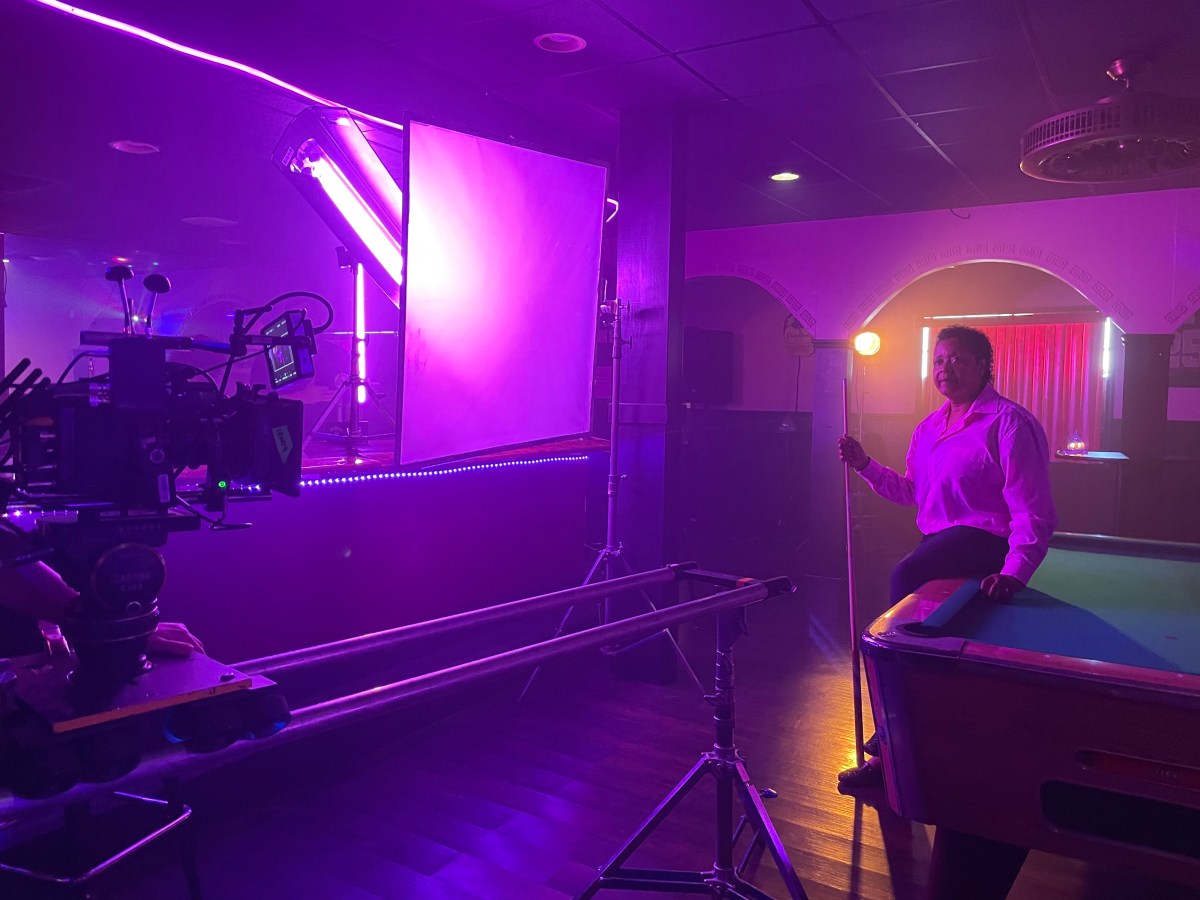
contributed by Lesbian Bar Project
Established in 2019, Herz’s building once held a straight dive bar. Between a perfectly vacant building, a dream and a loan, the Smallmans opened Herz, the only inclusive, lesbian-centered and owned bar in the state. Because it’s still in its infancy, it’s hard to determine how the bar will fare against gentrification, especially as it’s located in the 80%-white neighborhood of Skyland Park. However, gentrification remains an issue in cities most prone to significant population, job, and economic growth. Mobile’s population has been on a steady decline the last few decades, and its median income is around $25,000.
But a lack of full-gentrification aside, Mobile still struck me as a particularly unusual city to house one of the last lesbian-owned bars. Alabama has been coined one of the worst states for LGBTQ+ people due to its discriminatory laws and practices. Its recent anti-trans bills are nothing short of targeted and violent, and the state has been cited for numerous LGBTQ+ marriage license denials. “[Herz is] dedicated to inclusivity,” Rachel said. “It’s something that deeply matters to us. These trans children, so many of them are homeless, so many of them don’t have safety. We want to provide that space.”
Herz is not just providing a safe space for patrons; it’s actively seeking to uplift and further the voices and missions of LGBTQ+ activists, so that conditions for LGBTQ+ Alabamians improve. Kimberly McKeand is an out LGBTQ+ woman running for City Council in District 2 of Mobile. Signs toting her campaign slogan, Out for McKeand, were all over Herz earlier this year when the bar hosted a political event for her.
“It’s different, the thought process of people around here,” said Rachel Smallman. “I’m from Mississippi, but it’s different in Alabama. They thought [Herz] was a strip club, and then they found out it was a lesbian bar owned by two Black women. They weren’t ready for us.”
The difficulty inherent in two Black lesbians owning a business for LGBTQ+ people certainly played a role in Rachel and Sheila being the first to make such a move in Alabama. Though, with 21 known lesbian-owned bars left in the United States, the reasons why there aren’t more of these spaces are clearly evident beyond Alabama’s borders.
“I think, as women, we’ve been told for so long what we are and are not capable of, and what we can and cannot accomplish,” Rachel said. “It’s harder to take chances, but once you do, you realize what’s possible.”
There’s an estimated 400 to 1,000 bars in the United States that cater to gay men; three of them are in Mobile, Alabama. The overall economic achievement of cis gay men, a product of a patriarchal system even when considering sexuality-based societal oppression, has allowed them to own and operate businesses at a higher rate. And even as gender roles are challenged and dismantled, women’s same-sex partnerships are more than twice as likely to involve raising children, a fact that could certainly affect not only bar ownership, but patronage. Regardless of marriage, parenting, or access to funds, however, women have been taught for millennia that their goals, aspirations, and dreams should be small, reasonable, family-based or minimal; LBTQ women and nonbinary individuals often have these same roles forced upon them, amidst trying to battle cis-heteronormativity. Dismantling these notions can be a constant struggle, one that would impede not only odds, but desires, to open up a bar catering to the LGBTQ+ community.
“With the passing of gay marriage and more widespread tolerance – I won’t say acceptance – we’ve had some general assimilation,” Rose said. “And it’s great that the assimilation has provided us with safety, but along with it, we erase what makes queer spaces so comfortable and safe. Straight bars are still not catered specifically to [our community]. If we lose our bars, heteronormative culture prevails.” Rose’s comments touch on something integral to the conversation: Our elders tirelessly fought for our ability to move around the world with a sense of safety. Within that, though, the necessity for queer-centered spaces has diminished. That is not to say the desire has diminished, though. “Before we opened Herz, I had never been to a lesbian-centered bar,” Rachel said. “It’s so different, and we need more spaces like it. We deserve to have a place where we’re at the forefront.”
While I understood a bit more about why Herz was opened, I still wanted to know: what’s keeping Herz open?
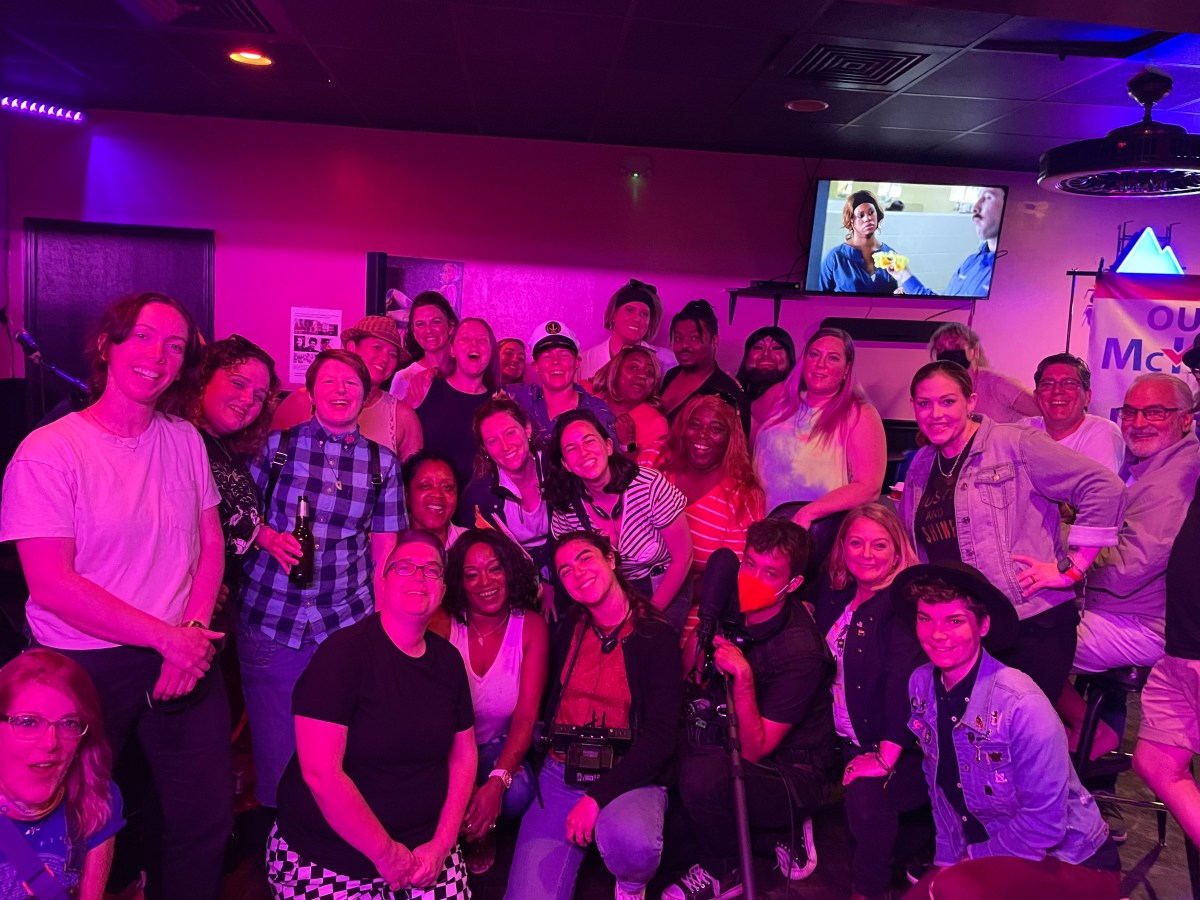
contributed by Lesbian Bar Project
“Community,” Rachel said. Even though the Smallmans were certain about the necessity and their desire in opening an inclusive, lesbian bar, they were still pleasantly surprised by their growing number of customers. “We had no idea how needed it was until we did it,” Rachel said. Herz quickly became the spot to go, a place holding an energy of acceptance, celebration, and joy that’s almost palpable. Starting at 4pm, Herz’s patrons nearly float through the door for after-work drinks, dates, birthday parties, celebrations, and political speeches.
The LGBTQ+ community has a distinct way of showing up. We’ve been deprived of safety, so we provide it. We’ve been denied space, so we create it. We’ve been cast out, so we open our arms. Quickly, a bar can provide the familial love some of us need and all of us deserve.
“Herz is made special by the people who come here. A lot of us don’t have family,” Rachel said. “But when you’re here, you’re family. We make certain of it. We’re built on it.”
The Lesbian Bar Project Raises Over $100,000 to Protect 15 of Our Last Lesbian Bars
“I remember a space I never knew existed,” says comedian, actor and butch lesbian icon Lea DeLaria (“Orange is the New Black”). “A space rooted in love, and history.”
Her narration plays over a ninety-second public service announcement made up of both archival photos and videos, and recent footage, released last month by a campaign called the Lesbian Bar Project. Neon lights dance across the grinning faces of bar patrons through the decades as they embrace one another, and themselves, in rooms and streets so full of joy that it’s palpable even through the screen.
“I remember the lost spaces,” says DeLaria, as the PSA pays tribute to the scores of lesbian bars that have been shuttered over the years—places like The Palms in West Hollywood, Lexington Club in San Francisco, and Kooky’s, Bonnie & Clyde, Ariel, and too many others in New York City to name.
Since the 1980s, the number of lesbian bars across the United States has been in decline. At one point there were an estimated 200 nationwide, but bars catering to women, and those for queer people of color, are closing at rates up to 20% higher than even other gay bars. At the start of 2020, there were just sixteen lesbian bars left —and in a circumstance becoming increasingly familiar to small business owners across the country, one has already been forced by pandemic-related financial strain to close its doors.
Lesbian nightlife always has been, and always will be, tenacious and ever-evolving. Many themed parties have sprung up in recent years, more versatile and flexible than bars, and dazzling in their own right. Nonetheless, the absence of more permanent spaces, and the history they hold, is deeply felt.
One such space is the Stud, San Francisco’s oldest gay bar. The Stud was founded in 1966 and was known not only for its vibrant atmosphere and iconic drag nights, but also for the enduring community it has been home to. Over the decades, including during the White Night Riots of 1979, and throughout the AIDS epidemic, people have gathered on the sticky floor of the Stud to party, to grieve, and to organize.
The Stud has changed hands and locations more than once, and when rising rent made its future uncertain in 2016, a collective of LGBTQ artists and performers came forward to rescue the space and form the first nightclub co-op in the country. This June, however, with lockdown dragging on and the building expenses mounting, the collective was forced to announce the club’s closing. The Stud had a proper 2020 send-off, in the form of a virtual drag show, and the collective has already begun searching for a new venue. For the time being, though, the Stud is yet another queer space relegated to history.
The Lesbian Bar Project is hoping to deliver the bars that still remain from a similar fate. The group’s public service announcement, co-directed by filmmakers Erica Rose and Elina Street, is part of phase one in their plan to preserve the sapphic splendor of lesbian bars for future generations.
For their purposes, the Lesbian Bar projects defines a lesbian bar as one that prioritizes “creating space for people of marginalized genders; including women, non-binary folks, and trans men,” a mission that’s as inclusive of modern crowds as it is true to the storied history of lesbian bars and those who have frequented them. Over the years, these spaces have been havens of acceptance and community, in particular when compared with the at times overwhelming whiteness and cisness of bars more geared toward a clientele of gay men.
They have also served as hubs of political organization. In this vein, the group’s PSA seeks to remind viewers of the spirit of activism and protest that is intrinsic to the lesbian community, and the LGBTQ community as a whole. “I remember that pride began as a riot,” says DeLaria, and protest footage rolls, including a clip from this past summer’s 15,000-strong Black Trans Lives Matter rally in Brooklyn, NY.
“Losing just one more of these cherished spaces has devastating consequences for queer people in this country,” says Rose.
As Street describes, the goal of the project is to not only highlight the bars and “cherish the memories of the lost spaces,” but to, “project a future of hope and sustainability within our community.”
In the United States, most small businesses are owned by men—bars, even more so. There’s something lovely and right about Rose and Street, two queer women in the traditionally male-dominated industry of filmmaking, working to bolster these equally rare spaces.
The project’s fundraising website launched on October 28th, in conjunction with Jägermeister as part of their #SaveTheNight initiative to support nightlife through the pandemic, and non-profit arts service organization Fractured Atlas. The project is produced by Lily Ali-Oshatz and Charles Hayes IV, and executive produced by DeLaria, and The Katz Company.
The Lesbian Bar Project, striving to preserve many facets of queer life, also hosted virtual events throughout the month-long fundraising campaign. These included a roundtable discussion, in partnership with Rockland County Pride Center, featuring Roxane Gay and Rosie O’Donnell alongside narrator DeLaria; and a virtual version of the comedy show and podcast Dyking Out, which included Leo Sheng, Sydnee Washington, Ali Clayton, Emma Willmann, Cameron Esposito, Rita Brent, and Mary Lambert.
And there’s more in store. Those gearing up for the dark, socially-isolated binge-watching season ahead will be glad to hear that the next phase of the project, currently under production, involves plans for an episodic docuseries seeking to explore the history and cultural significance of lesbian bars in the United States. Rose said of the project, “I want to use the power of filmmaking to illuminate the rich history…and provide an opportunity for Lesbian Bars to tell their stories.”
And if you’re eager to learn more about the rich present of the 15 venues still open, the Lesbian Bar Project website includes further information about each of the remaining lesbian bars, including a map that shows them scattered across the country like sparse beacons, and photos and statements from their owners.
Rose and Street, both in New York, are longtime supporters of their own local lesbian bar, Cubbyhole. “I like to say that Cubbyhole knew I was gay before I did,” says Rose.
Lisa Menichino, owner of Cubbyhole, shares that, “3/16/2020, due to the pandemic, was the first time we closed in 27 years. We cannot allow ourselves to become an invisible minority,” Menchino goes on. “We must continue to have a presence. We have to find a way to survive.”
Between October 28th and November 25th, the Lesbian Bar Project raised $117,504.50 toward that goal of survival.
“We are elated, and the amount raised definitely exceeded our expectations,” say Rose and Street. “The goal was not only to raise money and give immediate financial support, but to garner visibility for these vital institutions that are disappearing at a staggering rate.”
And in keeping with the proud tradition of dyke nightlife, the bars are already rising to the occasion. “Lisa Cannistraci of Henrietta Hudson is reimagining her space and turning it into what she calls a ‘European Café’ experience,” shared Rose and Street. “Many are galvanizing the support received from the campaign to do their own virtual events, like Jo McDaniel of A League of Her Own D.C. who plans to host conversations with local queer activists and artists as part of an on-going series.”
The great thing about virtual events? You can attend them from anywhere. It’s impressive, but not at all surprising when you consider the history these bars come from. With the funds raised by the project, the bars will be able to not only maintain, but expand the communities that depend upon them, and give them their core. As Rose and Street put it, “The women behind these bars are hustlers and innovators.”
Dykes Rule the Night
‘Strictly no unaccompanied men. A lesbian venue for ladies and their guests,’ reads the sign outside She Soho, the only lesbian bar in London. It’s unusual for a queer space to have a door policy like this. It sounds slightly archaic – ‘Ladies bar, serving men only when they are accompanied by a female escort,’ read the sign on one of New York’s first lesbian bars Café des Beaux Arts, which opened in 1913. This explicit gendering on the door makes the prospect of entry for non-binary, gender-nonconforming, trans men, and trans women less appealing. Though in actuality the space is open to all queer identities, including trans men, and of course sees trans women as women; the prospect of gender judgement, makes She Soho sound like the antithesis of a queer bar.
Having worked on the door at She Soho, which is on Old Compton Street, a bar strip in central London filled with blurry-eyed drunks staggering between bars and kebab shops – it took no time to get it. As tipsy guys repeatedly tried to come in because they “love women,” I had to turn around to double-check that the door sign didn’t in fact say, ‘a room full of available women, please join us.’ Though of course, they’d be mightily disappointed if they ever did get inside, it’s the enigma of the restricted space. “I honestly don’t know what they think they’re going to find down there: lesbian oil baths?” one of She Soho’s managers, Tina Ledger said. Alongside this, groups of women nudged each other towards the bar, as if they’re high school kids and being a ‘lezzer’ is an insult, and guys frantically elbowed their girlfriend’s attention to the venue, as if they’re Indiana Jones and they’ve finally found the lost kingdom of potential threesomes. In a location like this – loaded with lit and horny binge-drinkers – She’s door people have to morph into gender police to preserve the space. This inevitably puts some queer people off.
![]()
She Soho aside, there’s fairly unanimous thinking in British & American dyke bar communities that lesbian bars are queer bars owned by women. If they are not owned by women, as is the case with London’s She Soho and Washington D.C.’s A League of Her Own (both are owned by gay guys who simultaneously run gay bars in the area), then all the managers are lesbians and the venue explicitly prioritises queer women. Gary Henshaw, who owns She Soho and gay bar KU, “really sees the importance of a women’s venue,” manager Tina told me, “he completely respects our door policy and our decision making – he never comes here, and staff wonder why – it is literally just because he respects our door policy so much.”
For 32 years Babe’s of Carytown, a cavernous lesbian bar (they literally have a full-size volleyball court out back) in Richmond, Virginia, has been serving the state’s queer community. “We’re a lesbian bar, a lesbian-owned bar,” said Diana, who’s been working at Babe’s since it opened. “Just over the years, it’s become everyone’s bar. It’s kinda cool in today’s world to have everybody here, in one place, getting along. It seems like there’s so much strife on the streets, at least in here you’ve got boys, girls, gays, straights, Blacks, whites, who what who whatever, can come in, have a good time and be themselves,” she said.
Meanwhile, at 23-year-old My Sister’s Room in Atlanta, Georgia, on a cold Sunday evening in November, a family ate chicken wings while bopping to Kanye West’s “Gold Digger”; a group of college lesbians lined up on their knees to receive poured glugs of Rumple-Minze; a leather power dyke couple sipped IPAs on an intimate date; and a group of gender-queer folks in leopard print watched a raucous drag show.
Similar scenes of community integration can be found at lesbian bars Cubbyhole, Ginger’s and Henrietta Hudson in New York, A League of Her Own in Washington D.C., Lipstick Lounge in Nashville, Gossip Grill in San Diego and Wildrose in San Diego. I spoke with Lila Thirkield, who ran San Francisco’s lauded lesbian haunt Lexington Club for eighteen years until it closed in 2015 about the distinction between a lesbian and a queer bar. “At the Lexington Club, our tagline used to be, ‘your friendly neighbourhood dyke bar,’ but we actually changed it to your ‘friendly neighbourhood queer bar,’ five to ten years before it closed. So was the Lexington club a queer bar?” Lila said, schooling me gently. “Yeah, it was, with a lesbian core,” I said. “So what really, identity-wise, is the difference? We had trans guys working at The Lex; I’m extremely in-between in my gender identity and I owned it. It was hella queer women but there were a lot of trans folks, gay men hung out; I don’t understand what the difference is,” she said.
![]()
The person pouring your drinks, the people on the door, those on a date, congregating in groups, fecklessly making out in the corner and ultimately making money from the space, will tend to be queer women, but there’ll be joined by a whole host of LGBTQIA+ folks and allies, all guests of the lesbian community. Lesbian bars in 2019 are generally emphatic about their ‘queer’ branding. ‘A bar for humans,’ is the tagline of Nashville’s Lipstick Lounge; My Sister’s Room in Atlanta dubs itself “the longest running lesbian-queer bar in America’s south-east”. In Seattle, Wildrose is “a place for women… and all are welcome.” This is partially a desire to be realistic about queer identities. Lesbian bar owners have some of the most uncomplicated opinions on lesbianism, queerness and gender I’ve come across. Through years in queer spaces they know the transience of their own, their community’s and their staff’s identities. Their bars were always intended to be community spaces; offering safety, sanctuary and reasonably priced beer to anyone who might need it. On top of this, there’s an economic need to expand their potential customer base; lesbians are a very small minority, catering to zero-point of the population is an immensely difficult business model to sustain.
Scrolling through gay and queer bars in London, there is no mention, on any of their websites of ‘everybody’ or ‘open;’ active inclusion isn’t something they need to impress. Why lesbian bars need to go that extra mile to assert their queerness is anyone’s guess. The fact that gay men, generally speaking, earn more, drink more and spend more than women, means they are able to fill their spaces without expanding their customer base. The idea that lesbians don’t go out and like to U-Haul – a notion that doesn’t apply to the majority of dykes I know, be they 21 or 61 years old. Similarly, the rise of Tinder, Lex, Bumble and Hinge; writing a quippy bio has surpassed giving the eye across a bar. Or maybe it’s an awareness amongst conscious allies of the dwindling number of lesbian bars worldwide, making them reluctant to take up space in a venue not designed for them.
Despite the very queer and laissez-faire attitude of most lesbian bar owners, there’s also still an assumption that lesbian spaces are more weighted, binary and thorny than gay bars. There are perceptions of ‘the lesbian bar’ as a more restricted or exclusive space, memories of separatist movements in the US in the 70s and 80s, and unfortunate assumptions of TERFiness. I’ve had to convince non-binary mates of mine to come and see how queer most lesbian bars are. I’ve got an “oh fun” from straight friends when I’ve offered a night of karaoke at a gay or queer bar, and an “are you sure?” or “am I allowed?” at lesbian bars. Gay bars are assumed to be open to all – though if we’re honest, lots are undeniably (and unapologetically) dominated by gay men – while a lesbian bar is regarded as reserved, separate, less good and, if I were to get a bit Simone de Beauvoir on it, Other. These are lingering sentiments about lesbian bars that, no matter how firmly the words ‘everybody’ or ‘queer’ are articulated, prove difficult to shake.
When I asked Christa, who bought the Lipstick Lounge in Nashville, Tennessee 17 years ago, if she was aware of any other lesbian bars or bar owners in Nashville, she said she didn’t know of any, and then pointed out that, “the thing with lesbian bars, lesbian-owned bars, once you put that ‘lesbian’ label on there, it’s unfortunate but it’s the reality, how many lesbian bars are open right now?,” she asked.
Not many, is the answer. Of the 1357 LGBTQ bars in the world in 2017, only 36 were lesbian bars, down from 56 in 2014, according to gay-friendly travel guide Damron. There are even fewer now. Lesbian travel bloggers, Dopes on the Road, counted 33 in May this year, in the few months since then, two of these (Pink Hole in South Korea and Shela Tomboy’s Club in Thailand) are now red-flagged as ‘Permanently closed’ on Google.
As has been widely reported, lots of the most iconic, long-established and superbly-named lesbian institutions of the last few decades have closed, often for financial reasons; community dyke bars are rarely able to withstand gentrification’s guillotine. New York’s Clit Club closed in 2002, Athens’ Fairy Tale went in 2005, New Orleans’s Rubyfruit Jungle peaced out in 2012, Sisters in Philadelphia left us in 2013, Phase 1 in Washington D.C. was 2016, La Moza in Bogotá, 2018.
![]()
“If I could have kept it open forever, I would have,” said The Lex’s Lila. The bar closed in 2015 thanks to a “landlord who totally screwed me over, and a lot of displacement that was happening in the city,” she said. When she first announced The Lex’s closure – news that shattered San Francisco’s queer community; people wept, others got tattoos of the bar’s entry stamp, many are still in mourning – Lila posted on Facebook: ‘We tried new concepts, different ways of doing things, but we were struggling. When a business caters to about 5% of the population, it has tremendous impact when 1% of them leave. When 3% or 4% of them can no longer afford to live in the neighborhood, or the City, it makes the business model unsustainable.’ Lila, like lots of the queer community who lived in San Francisco in the 1990s, was gradually priced out of the area, moving to Oakland or further afield.
Meanwhile in London, Elaine McKenzie, owned Glass Bar, a stand-alone Grade-II listed beaut of a lesbian hangout in central London, for thirteen years, until it closed in 2008. “The landlord tripled the rent and back-dated it,” Elaine told me over a pint in the hetero-pub that stands in Glass Bar’s shell. “They were redeveloping the area, they didn’t want my sort here, what they wanted was what you have now,” she said, surveying the venue, “a blank, generic outlet that is open to all, they didn’t want something that was exclusive, didn’t see the value or need to have something that promotes women’s needs, somewhere that is a safe space.” The need to capitalise on space, and acquire the highest profits from the most number of people led to Elaine’s brick-and-mortar departure from central London. If lesbian bars, for the most part, are queer bars run by women, this makes them a very interesting case study. While they are imagined to be of niche gay interest, they are in fact a model for women-owned small businesses – though the conversation is rarely framed like this.
“How many even female bar owners are there?,” Lila asked pointedly. Online there’s evidence of women making waves in the hospitality industry but bar owners are often sprinkled in with bartenders, supervisors and managers presumably because there simply aren’t enough women behind the spaces. “We need to have the conversation around what it’s like for women to be the owners of spaces and have the capital, mentorship, ability and training in the way that our society is set up,” said Lila. It is now as it was hundreds of years ago, wealthy men own the land; wealthy men decide what businesses operate on their land; wealthy men choose other wealthy men to make the businesses function as they should. Community-minded lesbians are quite far removed from this equation.
I asked Lila if she’d be up for stepping back in the ring and opening The Lex Round II. “The US has changed a lot,” she said, “San Francisco has changed a lot, there’s a huge economic component, it’s happening in major urban areas the world over; it’s very difficult to have space right now if you’re in a marginalised group of any kind or if you’re a small business – when I opened The Lexington Club the economics of opening a bar were vastly different to how they are now. Even if you adjust for inflation, it’s just not the same.” Glass Bar’s Elaine likewise said, “realistically speaking its nigh-impossible, rents in central London start in the hundreds of thousands and I don’t have that lying around in loose change.”
So the older generation aren’t game, it’s the younger generation’s turn to step up, but how many prospective millennial dyke bar owners are there out there? “You have to be a proper business person and be ready to do things like ask promoters to bring their numbers up and compromise on things, make the hard decisions, make the hard calls, do professional and corporate events that you may not really like and be really prepared to play with capitalism. Some people just don’t want to do that,” said GIN, a DJ who’s a key player in the London queer scene, responsible for the creation and development of multiple intentional spaces for QTPOC+ in London. For the majority of young people in urban capitals – all those hustles, side-hustles and hours of our lives exchanged in order to simply pay rent – the prospect of tying yourself to a property, a bar in a good, lucrative location (like getting a mortgage on a nice apartment in the Lower East Side) is frankly, a laughing matter.
![]()
So what now, we hang up our dog collars and party beanies for good? We go pyjama shopping while our nocturnal playgrounds crumble before our eyes? No, we do what we’ve always done, whether in a space designated for us or not – we keep the party going.
For decades bars and parties have lived in symbiosis in dyke nightlife. In the first book-length study of a mid-century bar community in Buffalo New York, Boots of Leather, Slippers of Gold by Kennedy and Davis, lesbians used a combination of speakeasies, bars, backrooms, after-hours clubs and parties as places to form identities, friendships and relationships throughout the 20th Century.
Working class lesbians of the 1930s, 40s and 50s apparently acted upon an ‘irrepressible urge to be with others of their kind, to pursue sexual liaisons and have a good time.’ Those cut off from bars – for various reasons: privacy, safety, economics, police raids and closures – took the party elsewhere, often into their houses. Working class white women started off in bars in the 1930s and 1940s, while women of colour and white middle class women hosted parties. This fluctuated and changed; the community became more racially mixed, different people experiencing dyke nightlife in different ways but throughout time, the lesbian community thrived through their reliance on a network of self-sufficient house parties, gay bars and open-minded straight establishments. Working overtly and covertly alongside gays and straights, men and women, cops and mafia-bosses, we carved out spaces to call our own.
Though dedicated brick-and-mortar lesbian bars are increasingly hard to come by today, lesbian parties are popping up all over the place. In London, for example, on top of our one lesbian bar (She Soho, the enigmatic man-magnet) we have around 20 monthly, tri-annual and weekly dyke parties.
The current upsurge sparked Daisy Jones, Vice’s managing editor, to declare 2019 a renaissance in queer women’s nightlife. There’s a dyke-centred punk night called Dyke in the Pit, a night called Murder On Zidane’s Floor for lesbian footballers, a queer womxn’s strip party called Juice Box Events and Butch, Please! a night of butch lesbian appreciation. “There is something for everyone now and it’s nice, refreshing, eye-opening and exciting,” said Michelle Manetti, the woman behind Fèmmme Fraîche, east London’s most renowned and longest-continuously running queer women’s club night. “We don’t have that many queer spaces and one lesbian bar, but I don’t think we need them because we have all these queer things taking over spaces. With all these very niche nights, it is about catering to a handful of people, there’s never going to be any profit in that,” she said, “so we run nights specifically for the love of it, as opposed to, I want to make money from this.”
Lila likewise concurs that parties are a place in nightlife “where there can be a lot of real experimentation in a way that you can’t do with a permanent space. They can be temporary, last for 20 years or six months, and speak to something that’s very timely, something going on in that moment. You don’t have to have the capital and the business know-how. It’s really intense to run a bar that’s open everyday, there’s financial responsibility, employees, taxes; it’s not the same – but that’s great because it allows you to be able to do things and try things. If you lose, you lose a couple of hundred bucks, not putting things on the line by having these businesses and signing ten-year leases. There’s less pressure and because of that, there’s a blossoming of things that’s really important, everyone in the community benefits from that,” she said.
![]()
Parties have proliferated at an impressive rate of late – this is part pragmatism, part liberation from economic demands, and part the way it has always been. Lesbian parties however don’t happen in a vacuum; they frequently rely on the support of queer venues. Dalston Superstore, the epicentre of queer nightlife in London, hosts more monthly lesbian club nights that anywhere else in the city. Michelle’s Fèmmme Fraîche, Female Trouble (a party of dyke-drag, politics and lesbian in-jokes), Nite Dykez (a lesbian and POC-priority party) and Fanny Packer (a big lezzie collab party) are on the current roster, though they venue’s hosted multiple other excellently-named lez fests (e.g. Lemon Juice and Clam Jam) in the past.
Providing a place for lemon lickers and clam jammers to party isn’t an act of good will to lesbian kind. Dyke parties are an immensely powerful force; our promoters are coming in with serious cultural capital and notoriety within the community. Michelle Manetti is a globally renowned DJ, building her reputation year by year, she’s simultaneously run her House night Fèmmme Fraîche. For four years once a month on a Saturday, Dalston Superstore is choc-a-bloc with BDE, in a night that’s all about “creating a platform” for women and non-binary artists, performers and DJs. Alongside this, on monthly Sundays, Michelle hosts Fraîche Fruit, a free DJ workshop for women and non-binary people. Likewise, GIN and Mica Coco who run House, Funk, Afrobeat party Nite Dykez, also founded DJ collective ResisDance, while GIN manages EartH (a sizable music venue in east London), and has just launched an event called Sex & Rage, for sex workers, educators and activists. Lastly, Celeste Guiness runs Female Trouble, also works in the music industry, is in a band called deep tan and is a defiant trans rights activist.
These promoters are dynamic, community-grounded power dykes, who are using their talents and reputation to consciously create spaces for our community. The difference between now and 100 years ago, is that we have online visibility and presence, impressive careers, collectives, intention behind our nights (POC priority, elevating women/nb DJs, supporting trans people), evolving safer space policies, huge followings, massive music collections, and technical know-how. Dyke space-creators have cultural clout and cultural muscle like we’ve never had before.
We therefore have no trouble filling non-queer venues too. Big Dyke Energy, a queer techno party dropped, seemingly from the sky, earlier this year. On their first event they effortlessly sold out a 300-capacity warehouse in South East London, and raved outrageously until sunrise. They also placed great emphasis on accessibility, trained all their staff on queer inclusivity and pronouns, and had their safer space policy written in brail by the bar.
Similarly, this fall, Nadine Ahmed, the lesbian founder of Pxssy Palace (an event that started life as a house party and is now widely regarded as the most lit QTPOC+ party in London), was approached alongside Naeem Davis (from collective BBZ) by Absolute Vodka and Boiler Room to host Lesbiennale London’s first lesbian arts festival. As non-binary POC they wanted to expand, unpack and explore lesbianism from the margins. Lesbiennale was a free three-day event, there was very little press coverage, but it stream-rolled to success through Instagram. The erotic reading sold out, the screening was nicely busy and the east London warehouse party that closed the festival saw a line of hundreds snaking round the block.
![]()
Dyke promoters and DJs are flourishing, and of course using their nights as places to play with music, fashions, gender, sexuality and pleasure, but also places to experiment with safety, inclusion, accessibility, consent and prioritisation. With the rise of dyke nightlife comes an evolution in queer club culture. It’s a blessing that dykes can no longer be contained in set bars and permanent spaces. We’re building vast, powerful communities on and offline. And through this, should we so desire, we can create physical spaces for ourselves again – or so was the case in San Francisco.
After The Lex’s closure in spring 2015, San Francisco was dyke-bar-less until December three years later when Jolene Linsangan opened her eponymous queer bar, Jolene’s, which she co-runs with Shannon Amitin, a trans man. Having spent ten years organising lesbian events, Jolene had become a real dyke nightlife activist and cornerstone of the community. Mention the word ‘nightlife’ to any queer person in San Francisco and they’ll ask if you know Jolene. Whether hosting parties for dating app HER or running U-Haul, her Friday night roving party for ‘girls who like girls,’ Jolene had been turning up, creating space and really feeling the lack of permanent venues.
“I needed a consistent space for women’s night on a Friday and a general queer space the rest of the week,” she said, and people fully shipped her mission. Prominent SF queers (drag queens, Women’s March organisers, National Centre for Lesbian Rights staff, queer politicians) helped with city permitting procedures (in the end, the landlord, so down with their vision, gave Jolene’s a “below-market” five-year lease as opposed to the usual ten years), squads of queers came in to help with graphic design, renovations and last-minute handiwork. Thanks to her countless hours in the thick of the community, Jolene’s reputation and connections enabled her to harness the power of her queer community. Jolene’s is now one of the sleekest, sexiest, grandest queer bars in the world right now. The words ‘You Are Safe Here’ are neon-lit at the entrance; queers sip cocktails, play pool, eat brunch in the day. Come nightfall, there are trans, lez, kink and Latinx nights, the baseline rumbles through superb speakers and queers dance with pure joy and reckless abandon. “Every day is the dream,” Jolene said, perched at her bar as crowds filtered in for U-Haul, “seeing people walk in and smile and enjoy their time. Girls kissing each other with no one bothering them. That’s a dream.”
I spoke to Lila about what she makes of Jolene’s, her city’s new lesbian bar. “It’s interesting, when the Lex closed, everyone was writing all these articles about ‘the last lesbian bar in San Francisco’,” she said imitating an excited sports broadcaster. “Everyone was saying that and I was like, hold up, this wasn’t the last lesbian bar, because actually the last lesbian bar, Amelia’s closed seven years before The Lexington Club opened. For seven years there was no lesbian bar and then when the Lexington opened there was just a new one where there hadn’t been one before. This is going to happen again, there is no last lesbian bar, you need to understand the history, there already was, in 1991, Amelia’s and then we came and we closed, and then it was three years and Jolene’s came. Something is always going to happen, we’re still fucking here, man,” said Lila.
Lesbian nightlife death will never be a thing, not when there’s such might, endurance, variety and talent in our scene. For the last 100 years lesbians have created spaces – permanent, temporary, daily and monthly – where we can congregate in peace, comfort and hedonism. It’s just a matter of time before the next Elaine, next Lila, next Jolene harnesses the power of dyke communities – built online, in bars, at parties, in all kinds of venues – and uses this force to create another permanent home for dykes of the night.⚡
Edited by Rachel
![]()
Queer Women and Leather: A Culture Clash That Has Nothing to Do With Veganism
The Eagle LA, a gay leather bar on Santa Monica in Silverlake, has two gender-neutral restrooms: one is single-occupancy with a locking door, and one is open-format with a toilet in the back, no stall door, and a trough for communal pissing. And for watching people piss. And getting pissed on, if that’s your thing. Piss play is part of leather bar culture. So why do queer women have such a problem with it?
The Eagle is usually patronized by men — hairy bears, chubby cubs, Leather Daddies and their boys — and hosts testosterone-fueled monthly parties with names like Lumberjacked and Meat Rack. But it also occasionally hosts queer women’s nights, as many of our bars have been shuttered and we now turn to roaming monthly events promoted on Instagram and attended by those in the know. And the bathroom politics that come with queer women taking over leather bars give me pause. At one such party a few weeks ago — a fundraiser for Dyke Day LA, the city’s free alternative to increasingly corporate Pride — attendees barricaded the door to the communal restroom, allowing only one person in at a time. When I asked why, they cited privacy. If you’re not into communal pissing, the desire for privacy may sound perfectly reasonable, and there is a single-occupant restroom to provide it. But the communal piss trough in the leather bar is central to leather culture, and in patronizing these spaces, their culture should be respected.
The leather bar is a darker, seedier alternative to the mainstream gay club. They’re populated mostly by men, they’re a place to cruise for sex, and they’re explicitly anti-mainstream, struggling to keep their connections to BDSM cultures and traditions alive. One such tradition is the hanky code. Developed as a sly way to connect for sex in the 1970s, when many in the community remained closeted, the hanky code provides a way to know what someone is into based on the color and position of the handkerchief tucked into their back pocket. A yellow hanky, for instance, indicates that the wearer is interested in pissing on others (left pocket), or wants to be pissed on (right pocket). The leather bar is a place to forge community around these shared fetishes and sexual subcultures, and to free oneself from shame about it.
While the range of men’s bodies you will find in a leather bar is more diverse than the mainstream gay club — gay “bear” culture celebrates big bellies and body hair — leather bars also bring to life Tom of Finland’s fantasies of chiseled butts and biceps. These ideals have a tendency to incubate misogyny and stringent forms of body policing. Hyper-masculine gay leather culture developed in the mid-twentieth century as a reaction to accusations that gay men were naturally effeminate, and there are still men in the scene who feel that these spaces only belong to manly men. This history explains, but doesn’t justify, the ways that queer women, femmes of all genders, and trans people have had to work hard to carve out spaces for themselves in the queer leather community.
Barricading the door of a communal restroom exemplifies a clash between one form of queer culture that prioritizes privacy and sensitivity around bodies and bathrooms, and another that centralizes radical acts of public exhibition. An understanding of the leather community can help us co-exist, share spaces, and celebrate all of the different ways to live queer lives. Just like straight, cis people often need guidelines to help them navigate queer spaces in a respectful manner, queers too can be outsiders to certain subcultures, and need to educate ourselves in order to respectfully inhabit those spaces without trying to alter them to fit personal politics and preferences.
Here are five guidelines that queers who are new to the leather scene can follow, in order to have a conscious, respectful convergence with leather culture and leather bars.
- Don’t gawk at the kinky people doing kinky things. Voyeurism is active participation in a scene, so if you’re going to play the part of the voyeur, you need to ask for consent — without interrupting to do so. Remember that not everyone is doing a scene as an exhibition, even if they’re in a public space. If you’re casually catching glimpses of the hot bondage scene in the corner, that’s perfectly fine: it’s the benefit of being in a space that allows for play. Most people can intuit the difference between casual observation and active voyeurism, but err on the side of caution and keep your distance.
-
If you see things that shock you, step outside to collect yourself. Not everyone has seen a hook suspension, and not everyone wants to see a hook suspension. If you absolutely cannot be in a space where BDSM play might happen without getting squeamish or grabbing all your friends to gather around and audibly wonder, “WTF?,” maybe the leather bar isn’t the space for you. Know your own comfort levels. Don’t yuck someone else’s yum. And above all, don’t try to change the rules of the space to suit your personal comfort. Don’t go into a gay leather space and complain about the gay male porn. There are plenty of bars you can patronize that don’t show hardcore fucking: don’t ruin the sex radicalism of the leather bar for those who do enjoy it.
-
You have to ask for consent, even if a person is wearing fetish clothing or is kinky. Working lesbian events as a professional dominatrix, I’ve had women approach and grope me, even go in for a spontaneous, unwanted make-out session, all without consent. When I called out their bad behavior, they claimed they thought I was perverted so it was okay. I am a proud pervert, and I also have boundaries. When you ask for consent, be prepared to graciously accept “no” for an answer. “No” is not a rejection of you: it’s an opportunity for you to find someone else who wants to say “yes.”
-
Don’t photograph the kinksters. Even if you don’t intend to post the photos on social media, you don’t get to take home someone else’s expression of sexuality as a souvenir. Being photographed when you’re trying to get your kink on makes you feel like a zoo animal on display for someone else’s pleasure, which really puts a damper on your own. If you do have permission to take a photo of leather folks engaging in a scene, you must still ask for consent to post that photo online.
-
If you are still unsure how to conduct yourself in the leather bar, ask someone who looks like they do. The leather crowd is the faction of the gay community that often adorns assless leather chaps, haunting fundamentalist Christian imaginings of everything that is dangerous about gay pride parades. They’re heroes who are easy to spot. If you see someone who looks like they are part of the scene, ask them questions. Some events, such as Cruise in LA, are parties specifically designed for leather queers and more “vanilla” types to mix and mingle. If you’re curious about the scene, try to attend these kinds of low-stakes events in your city and ask questions. It all comes down to keeping an open mind.
In his book Public Sex, kinky queer writer Pat Califia asks that we queers “shelter one another’s desires, even those that are strange or degrading.” I second Califia. The bathroom issue that prevented leather queers from pursuing their desires for sex radicalism in the leather bar is different — in type and in scale — than the bathroom issues that conservative politicians have used to terrorize trans people. But in these times, we must all shelter one another. We must understand and appreciate the diversity of our communities, and protect them, from outsiders and from ourselves.
Day in the Life: Lisa Cannistraci, Activist and Lesbian Bar Owner
This past week I had the pleasure of spending the day with Lisa Cannistraci, co-owner of the longest running lesbian bar in the country – Henrietta Hudson. She not only handles the day-to-day in the bar, but also sits on community boards and is an avid activist for the community. She describes herself as “a life-long activist who happens to be a bar owner. I have been fortunate to use Henrietta Hudson as a platform for social change to fight injustice and will do so as long as I live and breathe.”
“I grew up in Park Slope Brooklyn during the very radical 1960s. I believe this shaped my activist nature. My middle class upbringing and Brooklyn street edge provided me the tools to be a fighter. I knew when I opened Henrietta Hudson it would remain open for a very long time. We are now the longest running lesbian bar in the country and perhaps the world.”
She jump starts her day at 6am with payroll, scheduling, walking the dogs, and replying to emails.
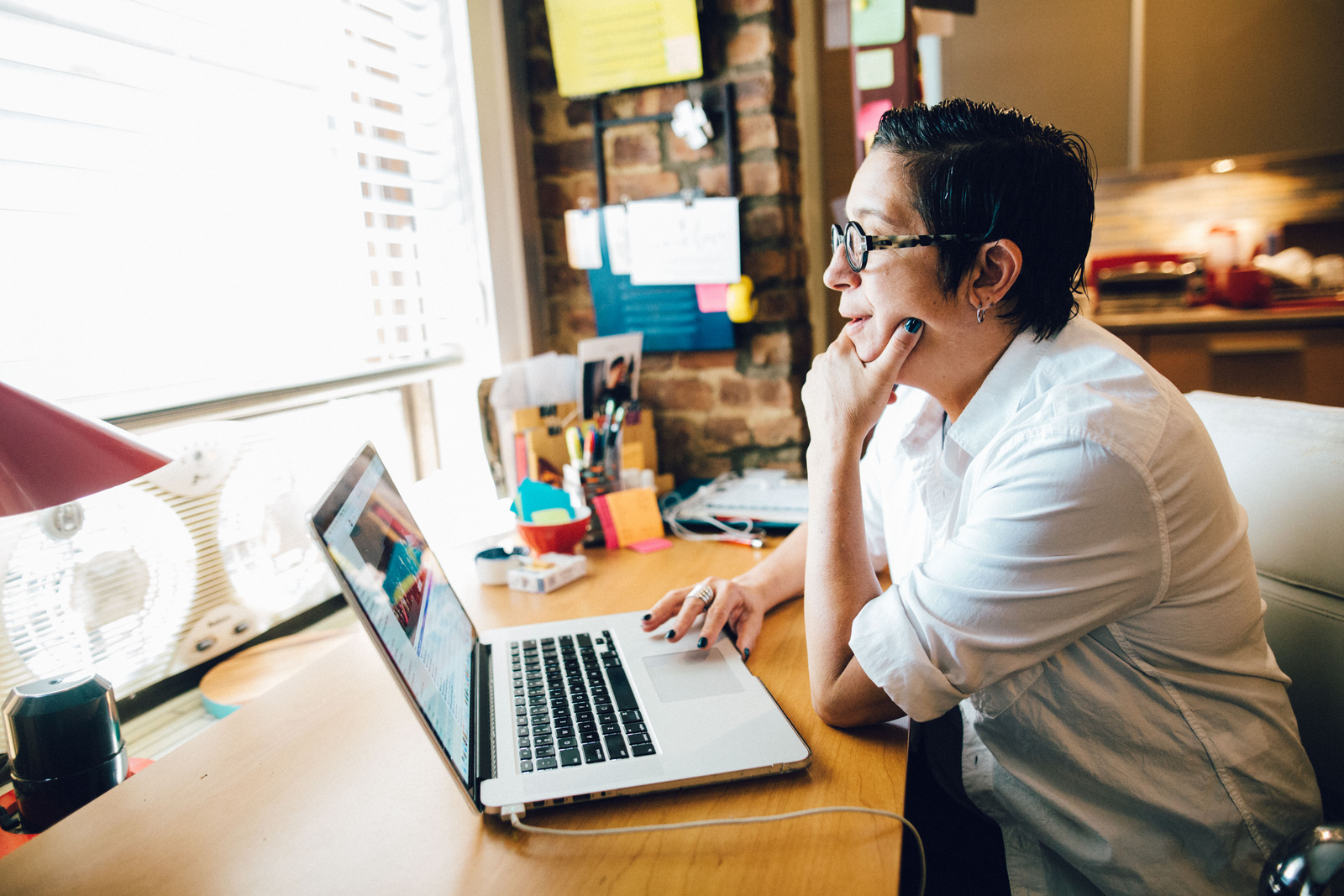
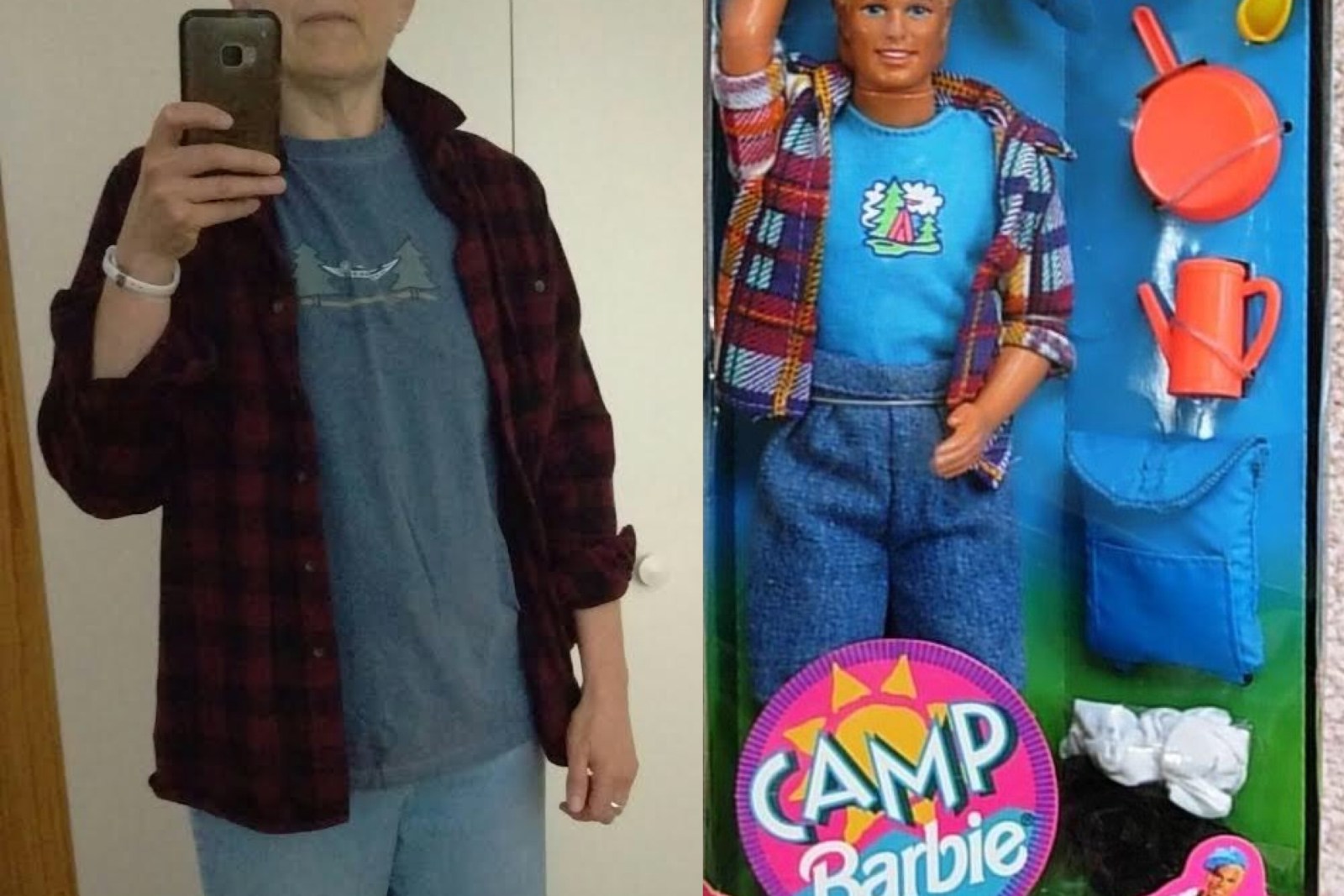
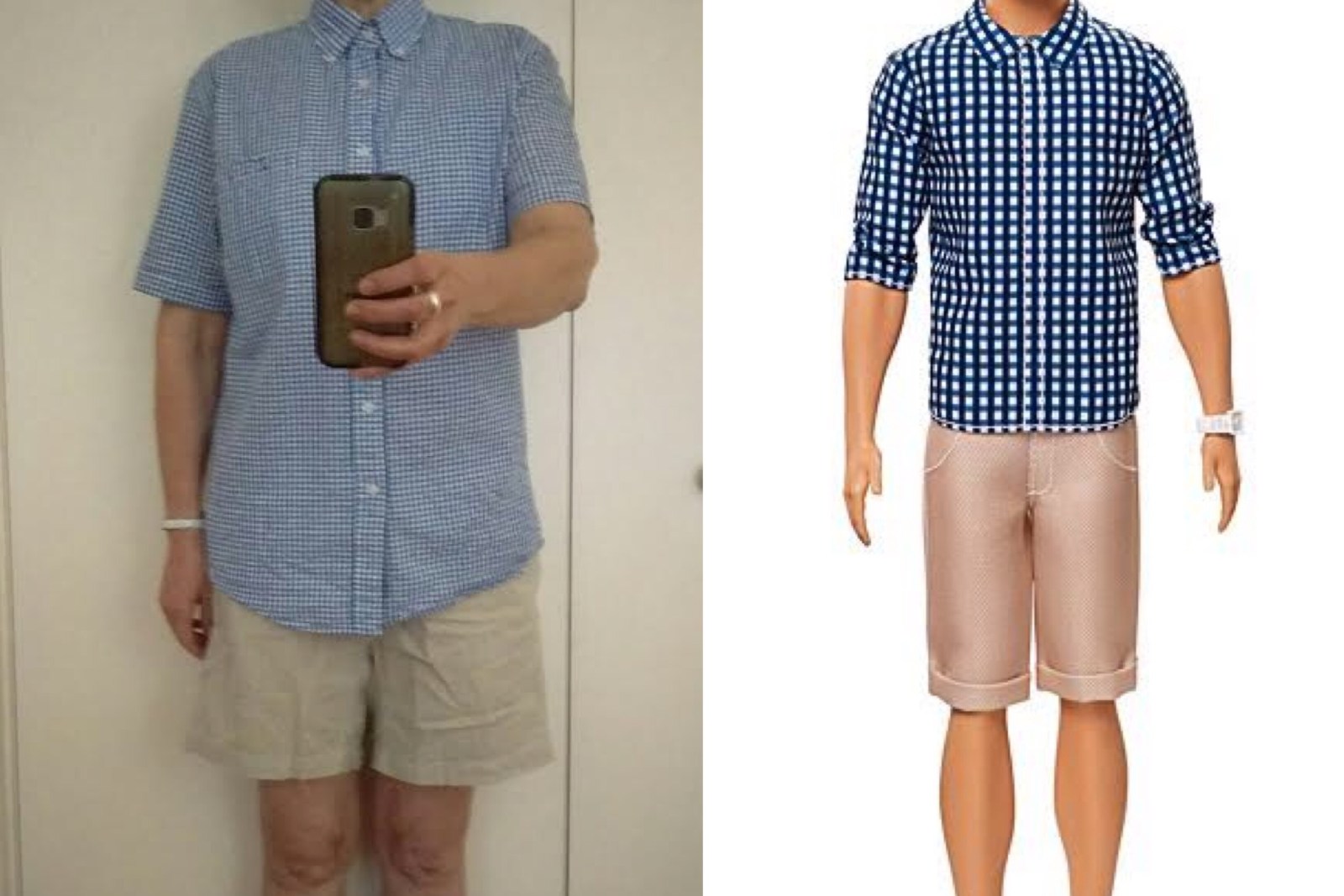
“It was never on my radar to open a bar. I was studying towards a clinical psychology degree when Minnie Rivera approached me to open the space that once housed the original Cubby Hole. I had been a bartender there from March of 1985 until it closed in 1990. One dinner led to a lease signing and well, that was 26 years ago. It was really my customers that urged me to reopen the old space. I’ve been at this space since March of 1985, bringing me to 32 years here!”
Midday she heads down to the bar to check inventory and make sure everything is ready for the evening.
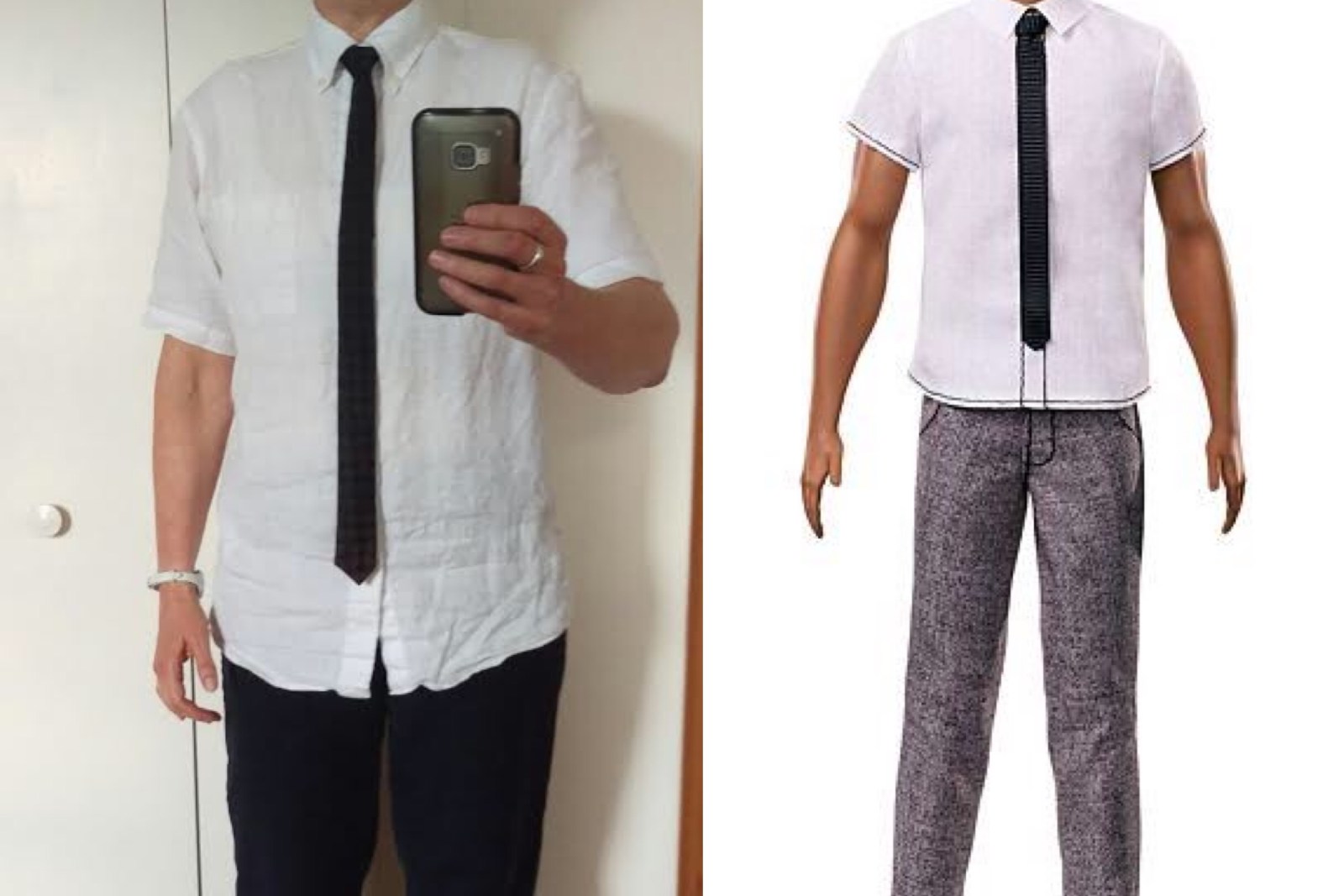
“When I opened the bar in 1991 we had a jukebox. Yeah that’s about it. Back then folks were not so intent on being in fabulous spaces. They just wanted a safe space to congregate. Today we have to create an experience with Vegas caliber burlesque from Rox Republic, super star DJ’s from all over the planet including Dj Gunn Sweden, DJ Daniela Sea of The L Word, DJ Whitney Day LA, DJ Kamikace Vienna, DJ Nicole of Nina Sky, DJ Lady Chellez NY, DJ Amber Valentine NY, DJ Rosy Q NY, DJ Tikka Masala NY. The list goes on and on…..”
Why are these spaces important?
Where do I begin? With the current political climate of hate and intolerance these spaces are more important than ever. I was the sitting Vice President of Marriage Equality USA when DOMA was struck down. Ironically my activism hurt my business. When Marriage Equality became the law of the land, lesbians in particular started assimilating and instead of going to a lesbian bar they would meet up at their local pub. This exponentially reduced traffic to the bar and I speculated it would. This forced me to up my game and make the bar more enticing and interesting with a more engaged staff who loved what they were doing. This phenomena prompted me to reinvent the space with super fun weekly parties and more special events that would satisfy niches within the community. It was a daunting task but has been very successful.
How has the scene changed over the past 25 years?
Well in 1991 the scene was very divided between cultures and sexes, however I never subscribed to that. Henrietta Hudson has always been an inclusive space for all including trans folks, gay men, etc. and I am super proud that we are known for our diversity.
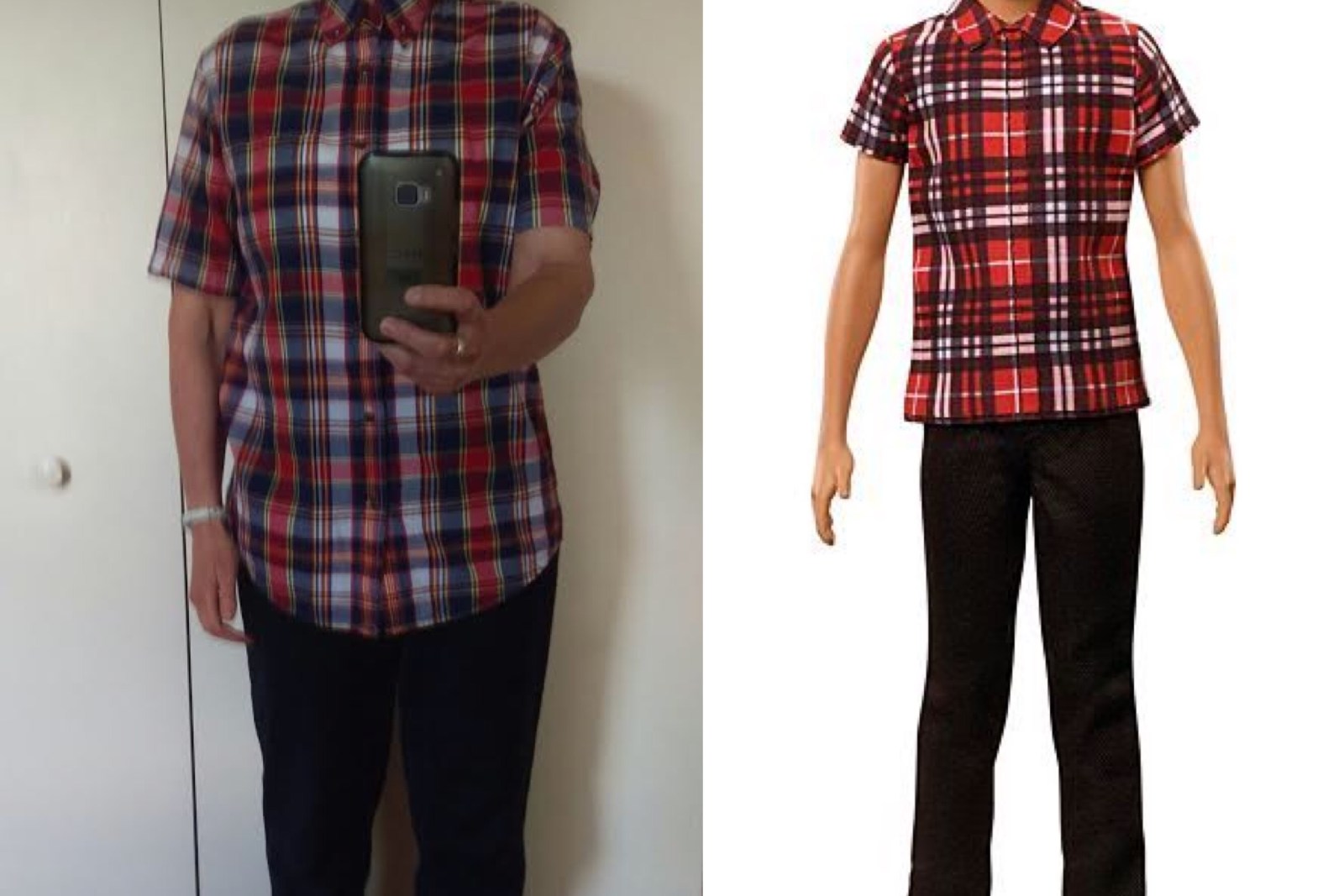
How is your space different from other spaces?
We are and always have been a bar with a conscience. We cared about social issues before it was cool to do so. We also attract and maintain a very diverse crowd. Of this I am very proud.
With girl-centered bars closing across the country how have you survived?
Well it’s not the sexiest answer but simply keeping an eye on things and really watching the bottom line. From going and getting all dry goods for the bar from a “cash and carry” to asking the staff every night to send me a pic of the thermostat at closing to insure the AC is turned off. We have a sophisticated liquor dispensing system along with a precise inventory accounting. Also knowing when something is not working and having the guts to change it.
And then I got an exclusive tour of the basement which is pretty cool.
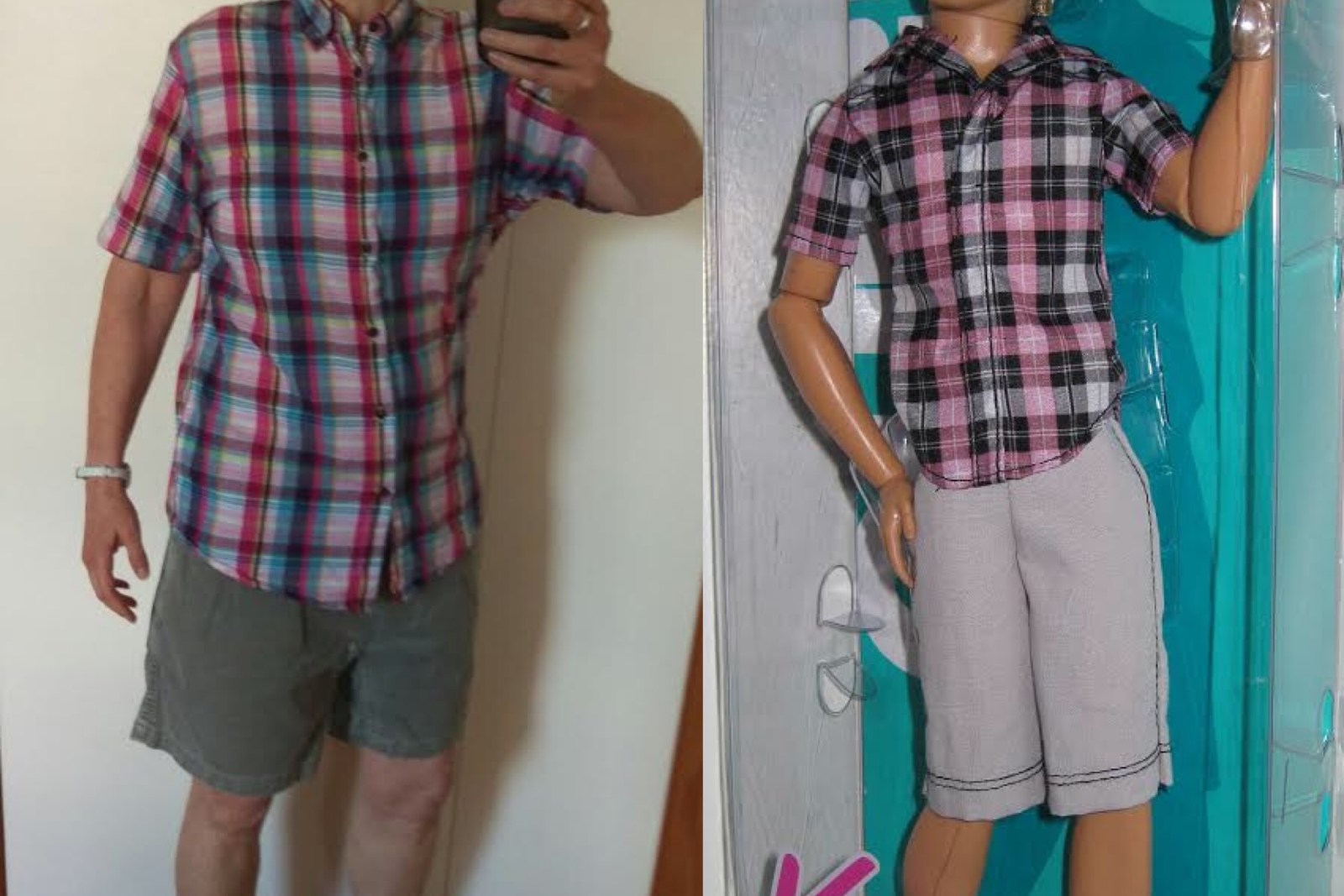
Soda room
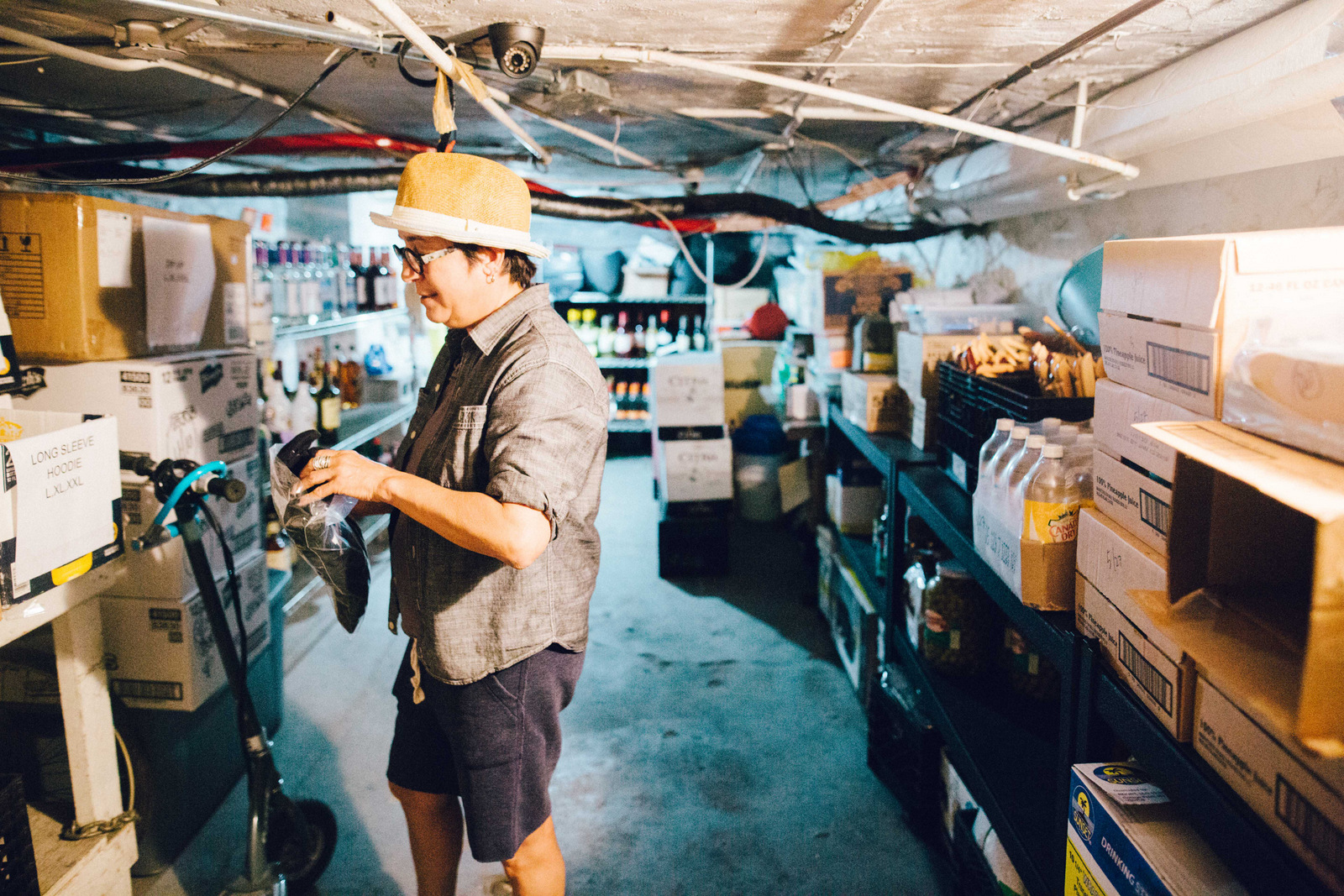
Liquor room
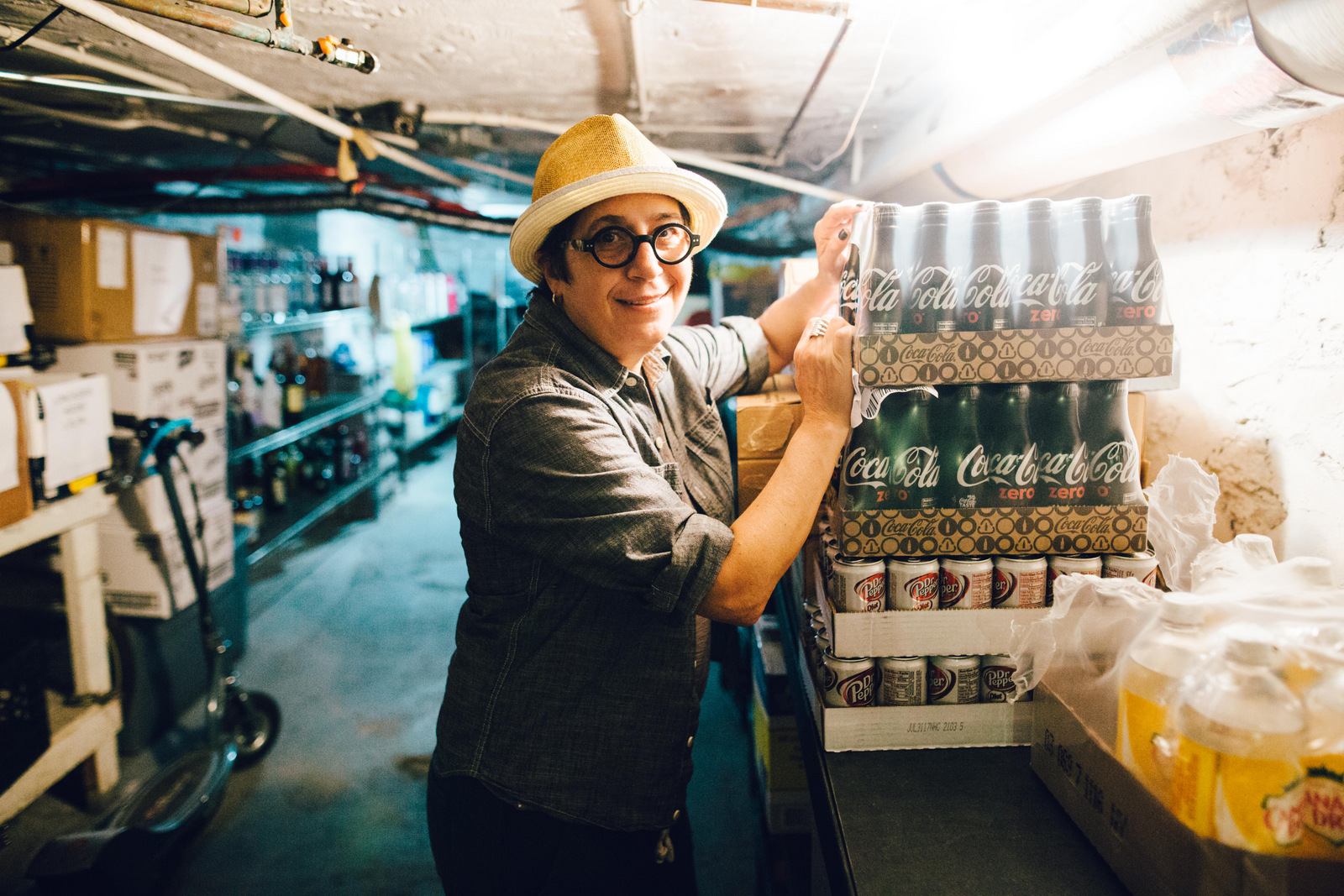
Lisa’s personal soda stash
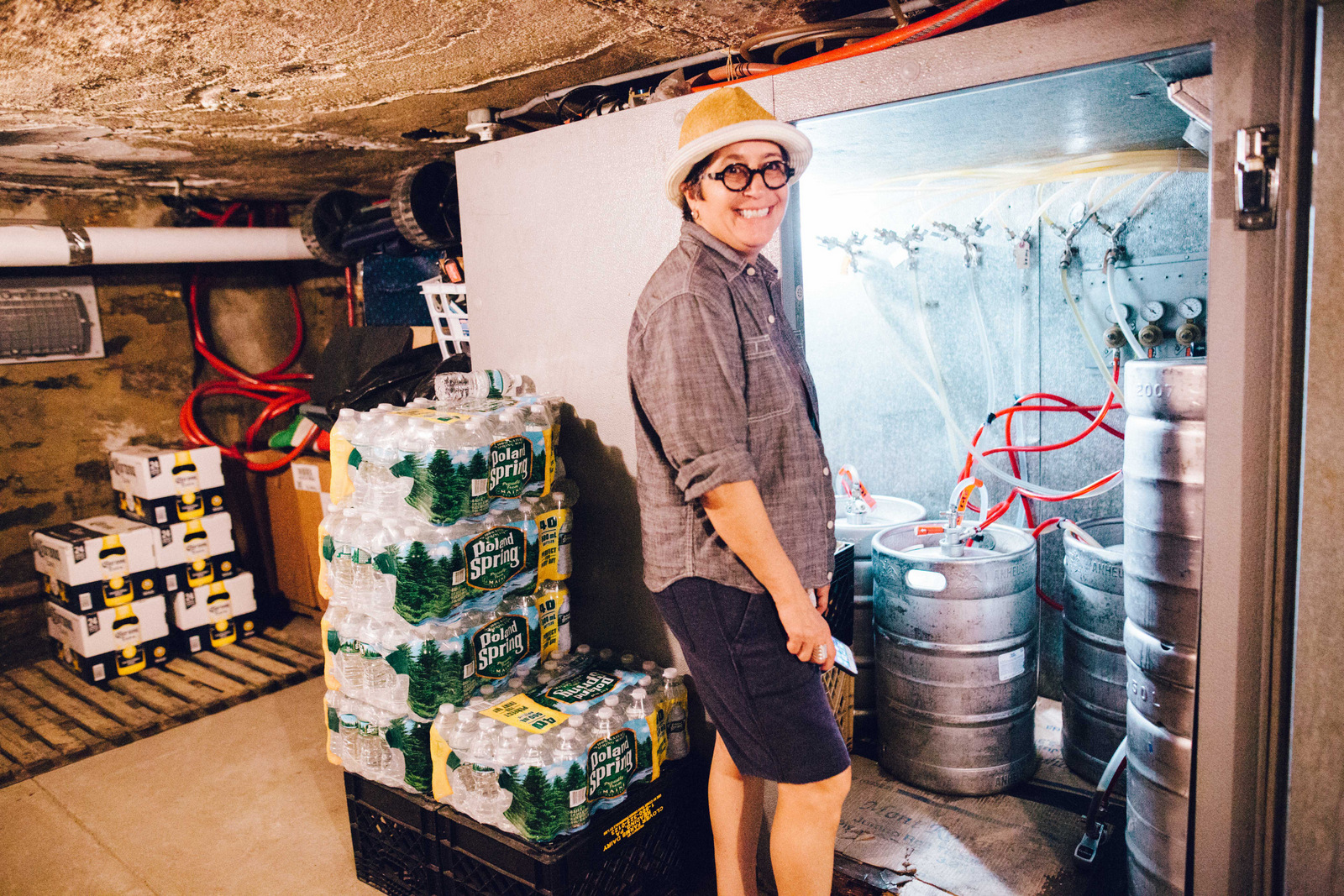
Beer and keg room
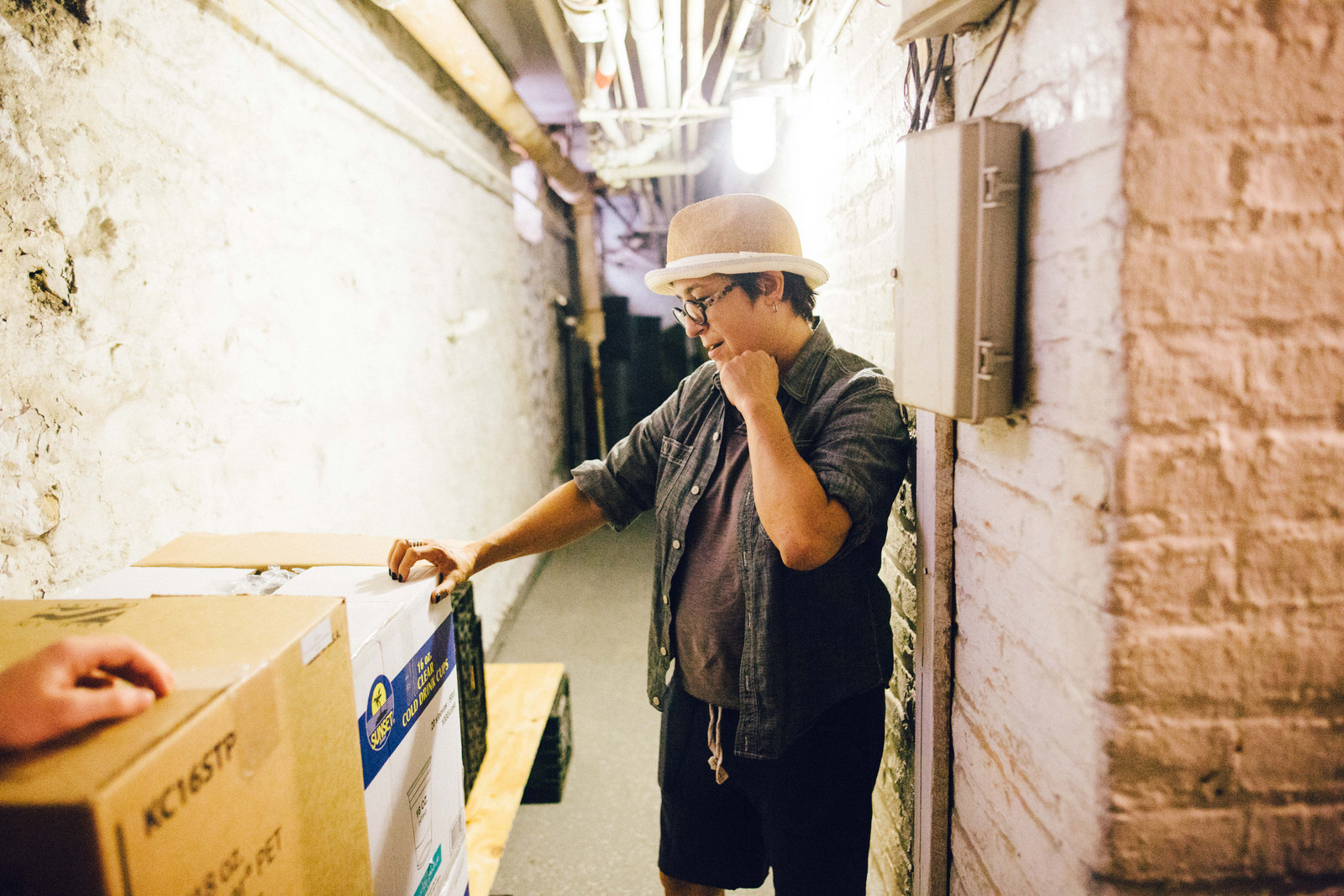
Locating a missing solo cup supply
On the day I was with her she was working on the largest event for women during NY Pride, Siren. This event is largely made possible because of her community ties. She transforms Pier 15, which is essentially a concrete slab on the East River, into an open air nightclub. For one evening it becomes a safe space for the community.
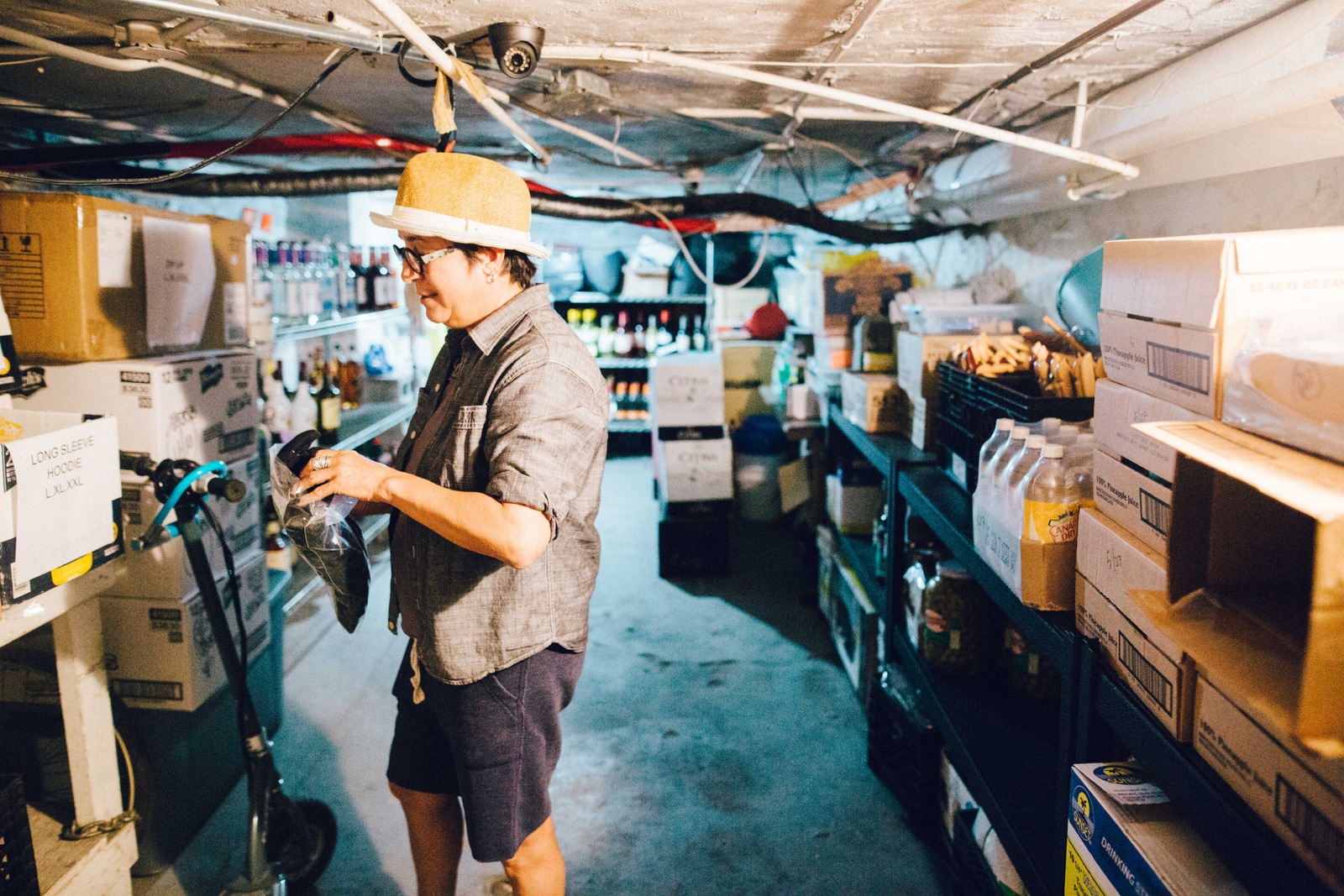
Her evenings are filled with community board, fundraisers, and events like the One Year Memorial for Orlando at Stonewall. She used her space as the staging for the start of the march.
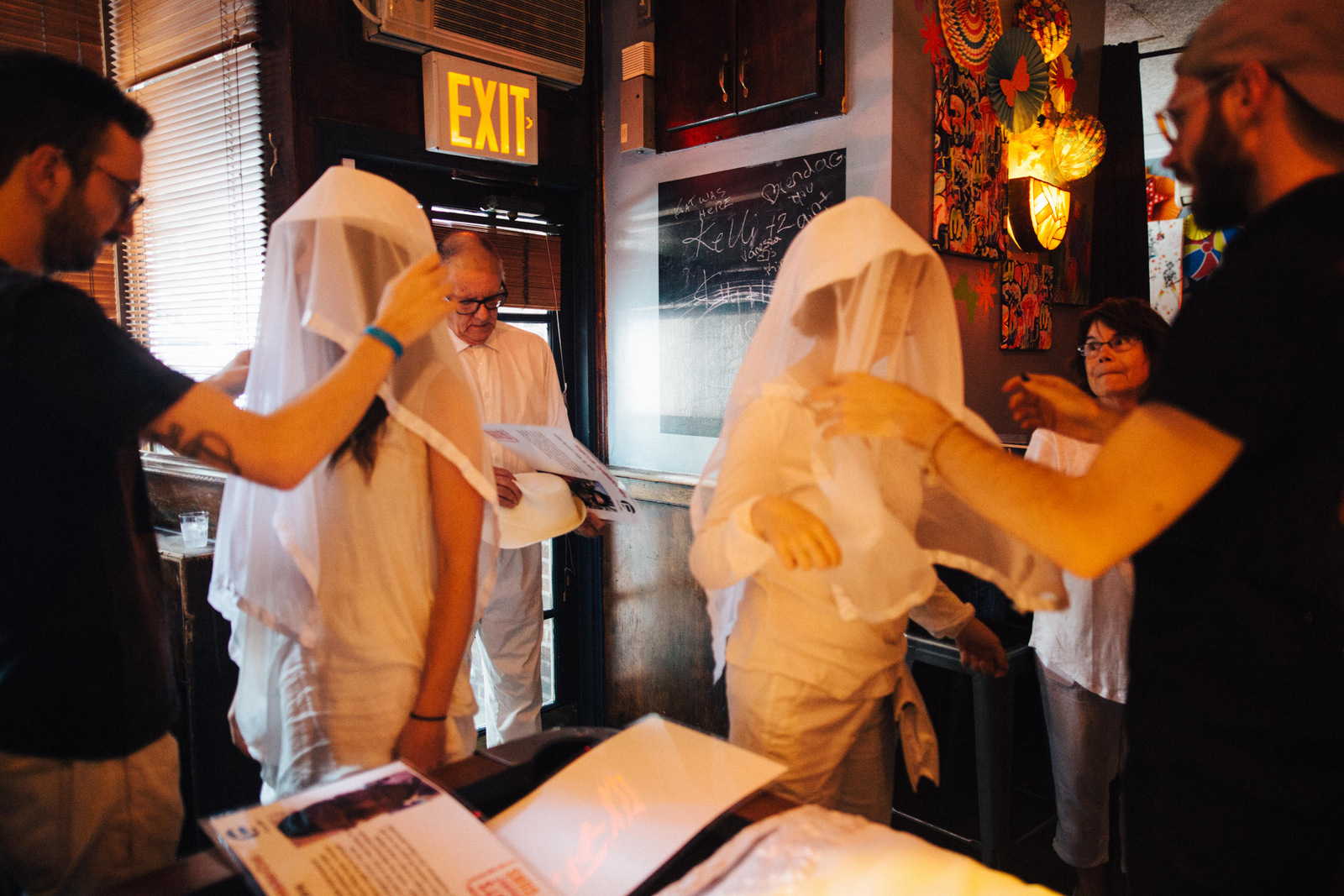
Participants getting ready
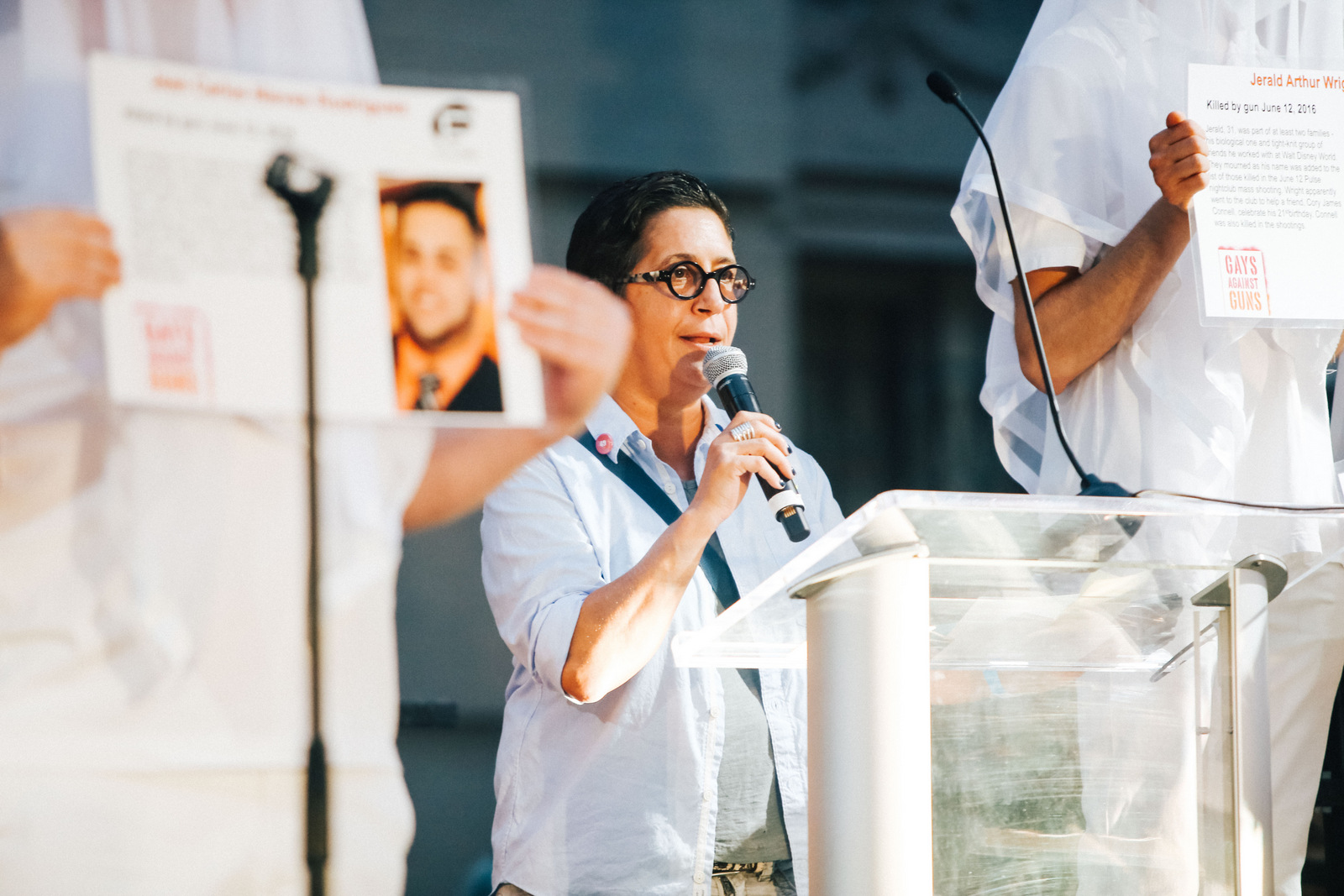
Lisa honoring victims of the Pulse massacre
So is this a typical day?
Okay, well, you’ve spent a bit of time with me and have seen first-hand how action-packed things can be. (Side note: this is so true. The phone didn’t stop ringing with questions like where do we put the table to a coca-cola order needing to arrive on time to a community leader asking for help.) I am an ardent activist and that’s what gets me out of bed in the morning. That said, I may be immersed in Henrietta stuff like booking talent, planning special events, working with not for profits and always engaged in the community to see what needs attention.
If you find yourself in NYC check out Henrietta Hudson and if you’re there on Pride Saturday 6/24 check out Siren! This year a portion of proceeds will benefit Planned Parenthood.
Lesbian Bar Names of the Past, Ranked
shout out Lost Womyn’s Space
For years, the lesbian bar as we know it has been going quietly and gently into that good night. She’s watched from the sidelines with an unfortunate font choice and if nothing else thought-provoking color scheme as trends have gone the way of shared spaces, monthly girl parties and queer nights. Left in her wake is a rich, century-long history of queer women carving out spaces for themselves, as well as a language of sorts. Perhaps you’ve heard of Lesbian Bar Name.
Its makeup is simple yet distinctive. Usually, there’s a confectionary/mystical/utopian/othering component, words reminiscent of a Microsoft Office Powerpoint transitional title, references to cats/girls/plumage/fire, mentions of the mouth area, reinterpretations of the way some words incorporate “x”s and “z”s, homages to act of lounging, or is straight up just an older woman’s name.
Let’s honor the lesbian bar and Lesbian Bar Name here today with lesbian bar names of the past ranked by Lesbian Bar Name.
55. Crescent Tavern (Seattle, Washington)
54. Third Dimension (Manila, Philippines)
53. The Flame (San Diego, California)
52. Charlene’s (New Orleans, Louisiana)
51. Tiger Lounge (New Orleans, Louisiana)
50. Fairy Tale (Athens, Greece)
49. Kicked Back (Amarillo, Texas)
48. Outskirts (Toledo, Ohio)
47. Ruby Red’s (Sydney, Australia)
46. Chances Bar (Houston, Texas)
45. Cloud Nine Lounge (Davie, Florida)
44. Connections (Omaha, Nebraska)
43. Gateways Club (London, England)
42. Escape (Madrid, Spain)
41. Chrome Cat (Lansing, Michigan)
40. Gaby & Mo’s (Austin, Texas)
39. Attitude’s (St. Louis, Missouri)
38. Cat’s (Baton Rouge, Louisiana)
37. Never Never Land (Shreveport, Louisiana)
36. Lava Bar (Boston, Massachusetts)
35. Sugar Shack (Milwaukee, Wisconsin)
34. Colette’s (Tucson, Arizona)
33. Chez Moune (Collette’s cat btw) (Paris, France)
32. Candy Bar (London, England)
31. Pandora’s Box (New York City, New York)
30. Prism (Alberta, Canada)
29. Peg’s Place (San Francisco, California)
28. Lace on the Avenue (Washington, D.C.)
27. Billie Jean’s (Kansas City, Missouri)
26. Sports Page (Atlanta, GA)
25. Visions (Durham, North Carolina)
24. The Hideaway (St. Petersburg, Florida)
23. Our Hideaway (Chicopee, Massachusetts)
22. Cherry Pie Nightclub (Miami, Florida)
21. Fannies (Milwaukee, Wisconsin)
20. Exhale (Albuquerque, New Mexico)
19. The Fish Bowl (Baton Rouge, Louisiana)
18. Club Pink (Detroit, Michigan)
17. Cowgirl’s Oasis (Fort Worth, Texas)
16. Zgirl Club (formerly Misty’s) (Phoenix, Arizona)
15. Eden (Denver, Colorado)
14. Eden Lounge (Dallas, Texas)
13. Pi Bar (Minneapolis, Minnesota)
12. Paradise Club (Los Angeles, California)
11. Sisters Nightclub (Philadelphia, Pennsylvania)
10. Sisters Bar (Portland, Maine)
9. Herizon (Binghamton, New York)
8. ChiQ Bar (Petersburg, Florida)
7. Chixx (Omaha, Nebraska)
6. Girlsroom (New York City)
5. Girlbar (Chicago, Illonois)
4. Lipstick24 (Austin, Texas)
3. Meow Mix (New York City, New York)
2. Kitty Kat Klub (St. Louis, Missouri)
1. Lick Club (Vancouver, British Columbia)
What’s the Point of Lesbian Parties?
They suck. Everyone knows it. The women are cliquey, the music is bad or no one shows up and you feel like an idiot for going. It makes sense. Lesbians are a hermetic category of human being. The few times we leave our apartments, we tend to choose intimate dinners over loud, stressful parties that go into 4 a.m.
Having grown up watching reruns of Cheers, I wanted what Norm, Diane and Cliff had, except with gay girls. I moved to Brooklyn with high hopes about queer nightlife. I’d been to Big Chicks (Chicago), Mary’s (Atlanta) and Como’s (Detroit) but it wasn’t enough. I wanted the big, sprawling New York kind of party where people do drugs in the bathroom, drag queens get tipped in double digits and the spoiled children of celebrities show up in weird outfits. I knew about Cubby Hole and Henrietta Hudson but the 24/7 lesbian bar has become a relic of another era, when lesbian separatism was cool and high heels were the devil. Visiting these bars now, they’re either empty or filled with gay men. I guess with our increased acceptance, the lesbian “community” is dispersing, or maybe we’re just too busy fulfilling our stereotype as anti-social cat people.
Then, like any young queer, I found The Woods.
It sounds like the start of a fairy tale, except The Woods doesn’t lead to witches that boil children. It leads to neo-feminist witches who can read your horoscope, make kombucha and tattoo your pinkie. They’re pretty hot.
The Woods is a straight bar in Williamsburg, Brooklyn and on Wednesday nights it’s colonized by queers. The party is known as “Misster” but no one calls it that. It’s just “The Woods” as in, “I can’t believe we’re still going to The Woods.” It’s been going on for four years and people love to complain about it but not me. The Woods is the sort of place that reminds you why lesbian parties matter.
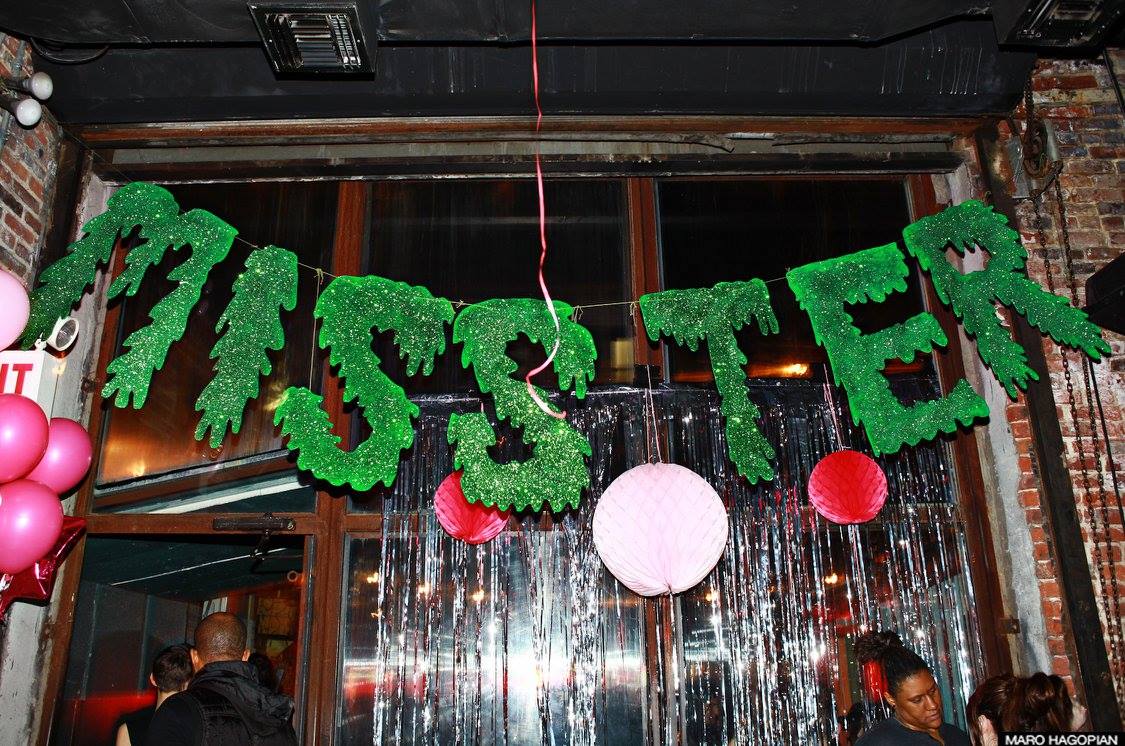
Photo Copyright Maro Hagopian
Your first time is exciting and scary because everyone is cute and they seem to know each other. The room is woman-positive and not meat-markety and you want to ask out everyone you see. This is the lesbian heaven you’ve spent your life searching for. Then you go again and again and again and it doesn’t change. It becomes like church where you don’t always want to go but if you do, you leave feeling better than you did before. Plus your friends are there and they asked you to come.
Like church, The Woods follows a specific pattern. Women arrive in packs and the time of arrival matters — 9 p.m. is early, 11 p.m. is better, midnight is best. If it’s cold, they wear beanies and if it’s not, they still wear beanies. They also wear baseball hats, snapbacks and fedoras. This is because lesbians love hats. Why? I don’t know.
The only man at The Woods that matters is the bouncer. He’s a ten-foot tall bald man and regardless of weather, he stands outside and slides IDs. I’m well over 21 and I still get nervous every time he does it, convinced he’s about to expose parking tickets or SAT scores.
Since The Woods has a reputation as a bar where any guy can pick up a girl, straight men always show up expecting the usual mating ground. The bouncer is wise enough to warn them, “You know this is a gay night, right?” Reluctant to appear dumb, the men nod and walk inside, where they are given the attention of prunes. Too embarrassed to admit defeat, they usually stay and become bored, irritable or excessively drunk. The patriarchy never looked so pathetic.
Upon entering, experienced lesbians walk straight to the back. That’s the social nucleus of The Woods. It’s where tribes of women gather at picnic tables and scope out the room through calculated, sideways glances. There is something deadly about the way women look at each other. It’s appraisal, comparison and competition rolled into one. But if you look hard enough, there’s vulnerability too. Beneath those beanies, we’re sensitive creatures seeking warmth, acceptance and maybe a date for Friday night.
While the predator-prey dynamic reigns in the back, the inside is the dorky birthday party where everybody’s dancing to Destiny’s Child. Women pile their coats in leaning towers and dance as close as they can to DJ Amber Valentine, the holy priestess of the queer parties in Brooklyn. Wearing neon tops and blue lipstick, she plays a triumphant combination of diva remixes and ‘90s pop. She DJs all around New York but Misster is the only party where she takes requests (if people are nice). She’s the one who throws the party and she really does make it fun and accessible to anyone who comes. When she steps away from the turntables, she’s upbeat but intimidating; she’s cooler than you and she always will be.
They say heaven is walking into a place where everyone you ever loved is waiting for you with their arms open. On the best nights, that’s what The Woods feels like. You show up expecting a few friends and suddenly, all your favorite people are there and they’re all happy to see you. It doesn’t matter what you talk about. What matters is the feeling you get when it’s late, you’re surrounded by friends and Rihanna is playing from every corner of the room.
Sure, the music never changes, the conversations are shallow and some women can be mean, but we go because the lesbian party is the only place where our sexuality is the least interesting thing about us. In real life, we’re always the lesbian: the woman whose nails aren’t manicured; who doesn’t go to Soul Cycle; who’s never thought about her wedding. But at The Woods we’re a sculptor, a yogi, a gymnast, I don’t know—whatever people are these days. That’s why we keep going back, and maybe we always will.
Lesbian Bars I Definitely Made Up But Probably Exist
Illustrations by Rory Midhani
Slice
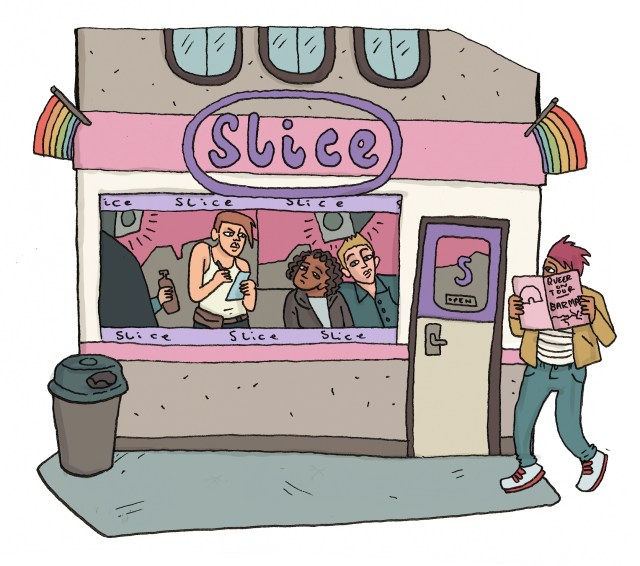
Slice is the number one search result on Google when you move to a new city and look up “lesbian bars (your city).” Slice’s aesthetic is a little bit like stepping into a lava lamp. Lots of pink and purple hues, and furniture is maybe floating? The music is so loud that the bartenders are already furious at you for even trying to order a drink. You won’t be getting the additional water you ordered, and shame on you for coming here tonight.
Liquor Boxx

Here’s a moment in my life that continues to break me spiritually: I’m driving with my mom — a virtuous woman — and we’re stopped behind a truck at a light with a sticker that reads “Liquor Box.” This light? This light is so long. So long that both of us take the time to let our eyes wonder, train them on the sticker, ponder it silently, and unsatisfied with how our internal monologues are interpreting its meaning, begin to repeat it to each other, out loud. “Liquor box,” my mom says with the cadence of pouring a cup of tea. “Liquor box,” I say, unsure both of the word “liquor” and “box.” “Liquor box.” “Liquor box.” “Liquor boxxxx,” my mom hums. My sister-in-law is in the back seat, internally screaming. My mom and I both, “liquor box” one more time, and this one hits for me — and while I will never know, based on the landing I assume for my mom as well — right around the “box” part. The only sound in the car that remains is the clicking of the blinker. This bar is a little like that!
Bar Batch
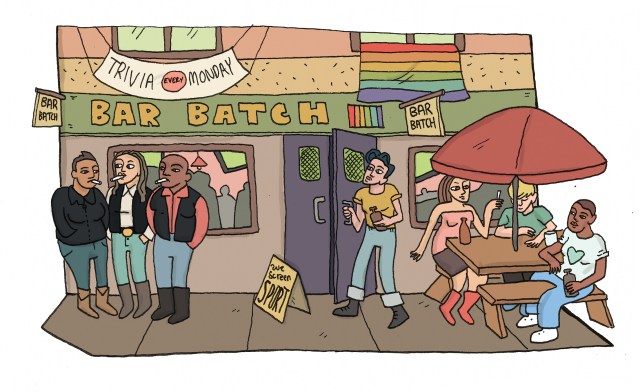
Hey, is the the plural of a butch a batch? It seems like a fun word for a fun group. Bar Batch is where you go when you want to watch 13 different TV screens at the same time, drink appropriately priced drinks, and attempt an almost impossible night of trivia. Bartenders and servers call you “baby” and it feels right.
The Lounge Lounge
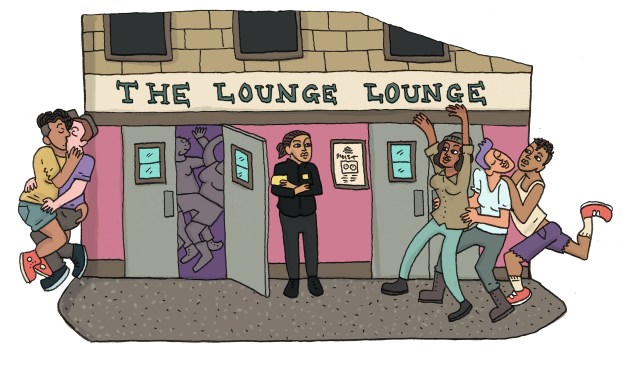
I don’t know what it is about lounges that validate the gay experience, but we do love a lounge. There’s one here in Nashville called — of course — The Lipstick Lounge, and there’s a permit there that makes it illegal to dance if both feet aren’t on the ground. Good thing I already dance with the Lord in my heart! The Lounge Lounge allows dancing of all kinds and it even has a room upstairs that’ll turn a blind eye to whatever you might do upstairs at a bar!
Yearn
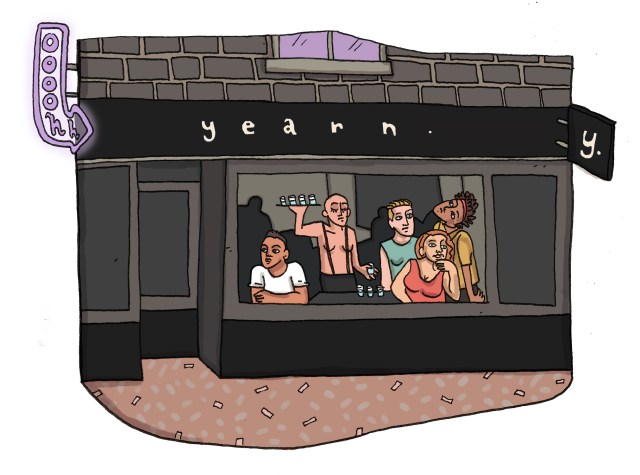
Yearn is honestly a little too much. Yearn is the bar equivalent of Marina’s voice on Jenny’s voicemail that one time when she’s like, “Jenny. I was just… thinking about you.” Marina! Just trying to get a couple drinks here. Yearn has a bunch of sex music on, the same music you might hear in a Hilton after hours lobby, and yet no one is dancing or talking. Even friends that came together are just silently sitting around a table.
Moist
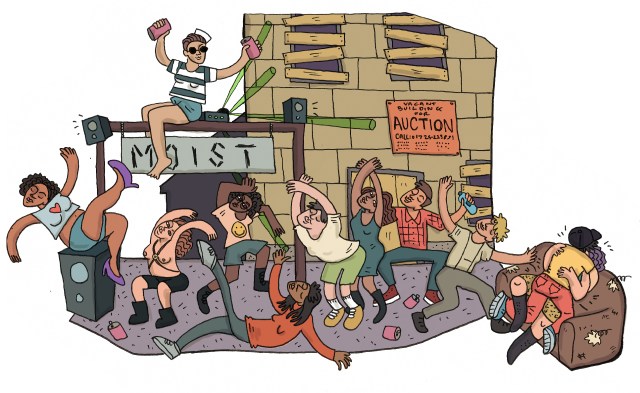
Moist has become the most popular queer night even though literally every single person besides me hates their name. These tongue in cheek go-getters leave no triangle design unturned. Triangles are everywhere. Do other shapes exist? Interesting thought, but no. The location changes each month and progressively building codes become less and less an issue. Eventually there’s one Moist event where you look around and you realize you’ve all broken into a vacant home.
Now you too can make your lesbian bar dreams come true with this paper play set! Print it out and create your own.
Last Call: Stories from New Orleans’ Disappearing Dyke Bar Scene
I call Alda Talley my dyke fairy godmother. She is a self proclaimed “executive domestic goddess,” a small-town Southern lesbian who has spent her life fighting oppression through the art of hospitality. Alda and her partner Mary Capps frequently host younger queers at their home in Mississippi, where we laugh, eat and peruse their incredible feminist book collection.
Alda is the first person who told me about the New Orleans dyke bar scene. She came out in the 1970s, never having heard the word “lesbian,” and found herself at a bar called Charlene’s. “We would just drive by and watch from a distance,” she told me. “We did that several times before we got out of the car. We just stood a little way away on the sidewalk and practiced being lesbians at a bar.”
Charlene’s was one of over a dozen dyke bars in a scene that flourished in the 1970s and ’80s. Alda tended bar there in the late ’80s and welcomed in the baby dykes who came after her. “It did not always go peacefully,” she told me, “but it was never boring.”
Dyke bars during this period were spaces for identity formation, community building, political organizing, and celebration. All around the country these spaces are disappearing, or are already gone.
For the past two years I have been part of an effort to preserve the stories of New Orleans’ dyke bars and to recreate some of their magic through live performance, community events and digital media. Our collective, Last Call, has interviewed queer elders and hosted listening parties and live performances. On March 22 we released the first episode of our podcast series. Here are a few of the stories we’ve heard along the way.
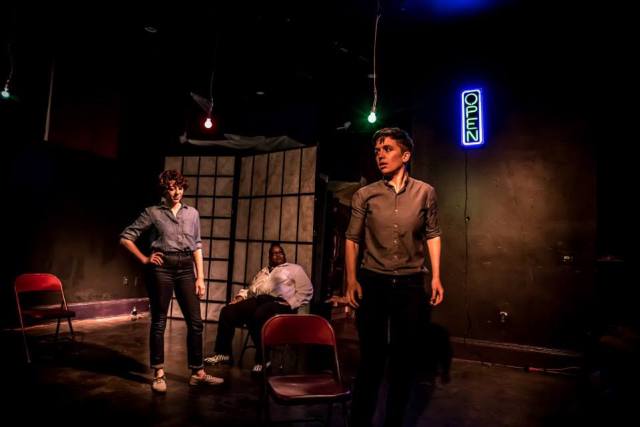
Erica Langhoff, Moxie G. Rogue and Hannah Pepper-Cunningham in a Last Call performance
directed by Bonnie Gabel. Photo by Melisa Cardona.
Places to find love, or at least a lover
Before there was OK Cupid, one of the best places to pick up a lesbian lover was in a lesbian bar. When Liz Simon got out of a bad five-year relationship with a closeted woman, the first place her friends took her was Alice Brady’s bar on Rampart Street. “You deserve it!” they told her, “You’re getting your just desserts.”
Brady was one of the first lesbian bar owners in New Orleans, and her establishment moved between three different locations in the French Quarter over the years. Mary Capps remembers her bar as being attractive, a step up from a dive bar, with a great pool table. Brady was butch, but she always wore a skirt to avoid confrontation with law enforcement or homophobes. In the ’60s and early ’70s Brady was known for having strict rules. “No dancing, no touching, no kissing, no nothing,” Mary remembers. The rules were meant to keep the cops out in an era when raids of gay bars were still common, and two women dancing together could be arrested on charges of lewd behavior. “Everyone got evicted almost every night from the bar,” according to Mary, “You know, the rules!”
The rules didn’t stop Liz from taking a shining to an attractive young woman with a quick wit and Bette Davis eyes. Egged on by her friends, Liz approached her and struck up a conversation. “You know I’m new to the bar scene in New Orleans,” she said, “and I just saw you and noticed you and thought you were really cute and wanted to come over and talk to you.” They danced and danced, becoming increasingly flirtatious. “I think this is getting beyond the barroom floor,” the young woman said. Liz invited her home and they had a “jolly good night of it.”
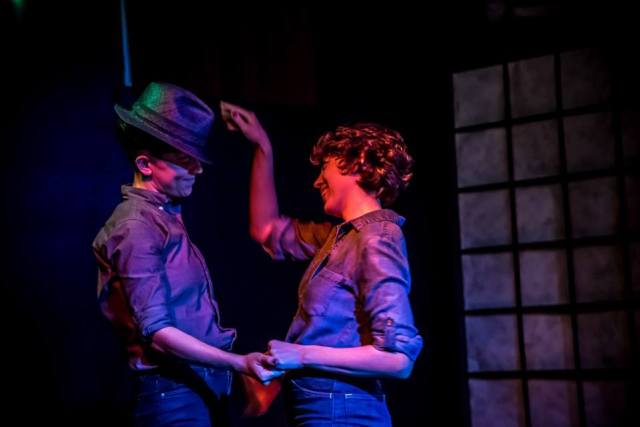
Hannah Pepper Cunningham and Erica Langhoff. Photo by Melisa Cardona.
Liz remembers being on a high that night at Brady’s: “I felt free. It didn’t really matter to me whether I went home with anybody. It didn’t matter to me whether I talked to anybody. It was that I was going out as an out lesbian.”
Places to be free
Liz wasn’t the only person who felt free at the bars. The word “free” came up 40 times in our interviews. Hovering between private and public space, bars afforded lesbians the opportunity to flirt openly, dance and socialize with other women without as much fear of arrest or harassment as they experienced on the street. According to Mardi Youngblood, Halloween and Mardi Gras were the only times when it felt safe to be out, visibly, in public. The rest of the year, bars were a haven and an oasis.
Paula Kilbourne worked for the Jefferson Parish Sheriff’s Department in the 1980s and dreaded the possibility of being outed. “I worked Monday through Friday and wore that mask and those clothes that didn’t really fit me,” she remembers, “But on Friday nights and Saturday nights, I could be me. I could put on my blue jeans, put on my boots and I could go out and look as butch as I wanted to look. The bar saved me. It was my freedom.”
When Paula saw a drag queen hanging out at the bar at Charlene’s one night, it messed with her head. It was the first time in her life that Paula had ever seen a drag queen and she couldn’t help looking, although she tried not to stare. “How does it work?” she wondered, impressed. She imagined this fabulous drag queen being out all the time, whereas she would leave the bar and put on a skirt to go to work and pass for straight. She couldn’t sleep that night as she kept turning the image over in her head.
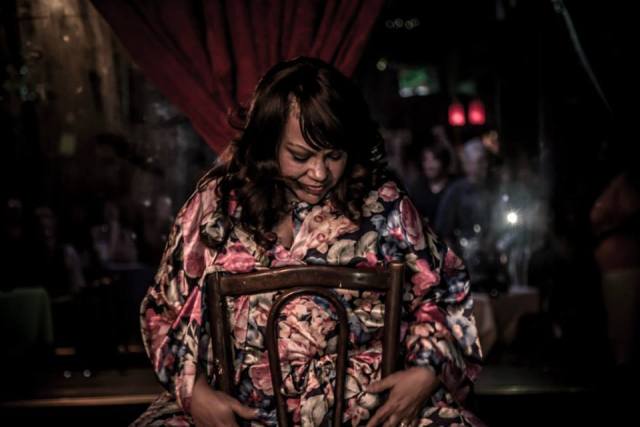
Donna Bechet-Kilbourne, one of our interviewees, performing in a benefit for Last Call.
Photo by Melisa Cardona.
Places to be powerful
Diana Panera remembers the 1970s as a “heady period of our power.” A feminist and anti-racist organizer, Diana took part in planning New Orleans’ first Take Back the Night march which drew thousands of people into the streets to protest violence against women. Diana was a member of WWAR (White Women Against Racism) and WAVAW (Women Against Violence Against Women), a group that trained women to be security marshals during the Take Back the Night march. When meetings let out, the conversations would continue over drinks at Charlene’s.
Diana identified as straight at the time, but she was happy to go to a lesbian bar. She always felt safe there. “Are you sure this is okay?” her friend Mary Capps would ask. Diana felt comfortable surrounded by women, and she was literally surrounded. Her friends would circle around to protect her from sapphic advances, but she would break away from the group. “They couldn’t surround me while I was dancing.” Soon enough Diana herself came out as a lesbian.
Bars play a central role in the history of gay liberation movements, most famously the Stonewall Inn in New York City. When people get together socially, they become aware of shared struggles and form group identity that can translate into powerful base building.
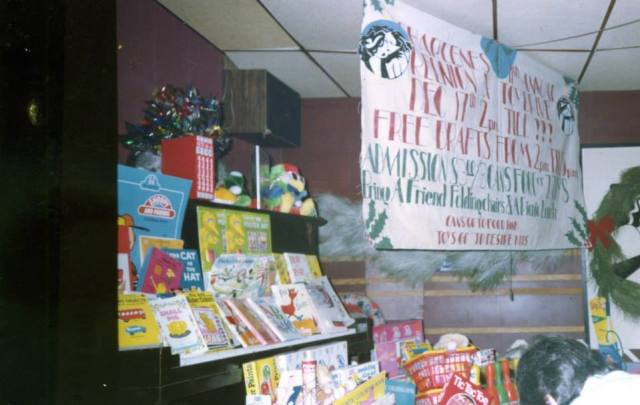
Charlene’s annual toy drive. Photo courtesy of Dianne Schneider.
Charlene Schneider, who owned the bar where Alda worked, capitalized on the collective identity of her customers to form political alliances. She would invite local candidates into the bar who were supportive of gay rights and she would hold toy drives around Christmas for constituents in the districts of politicians she favored. Sometimes she would take the mic at the bar and lecture the crowd, at length, about issues affecting the community.
Liz Simon remembers Charlene being radicalized by her experience at the March on Washington for Lesbian and Gay Rights in 1979. “There was only about 100,000 of us, but they emptied all the federal buildings within two miles of the Washington monument so that nobody would be there to see us and so that we would have no coverage.” After the march Charlene started hosting meetings for LAGPAC, the Louisiana Lesbian and Gay Political Action Caucus, at her bar.
Imperfect places
Dyke bars could be a safe haven, but they were not immune to dynamics of racism, classism and transphobia. The same interpersonal and structural forms of oppression that shape heterosexual society still applied in the bars, sometimes blatantly and sometimes in more subtle ways. As Fikri points out, oppressive structures and behaviors have not been eradicated from queer spaces and need to be central in our understanding of “safety” and “freedom.”
Donna Bechet-Kilbourne remembers going to white bars with friends who were white: “Sometimes I would feel like I was the token black person there. And a lot of times white women would come up to me and ask me my opinion because I was representing the race for them.” Micro-aggressions like this stung, and made white spaces less welcoming for women of color. “We needed some place to go,” remembers Leslie Martinez. In the 1980s she opened a bar called Les Pierres with her partner Juanita Pierre. To their knowledge it was the first black lesbian owned bar in the city, and it was always packed.
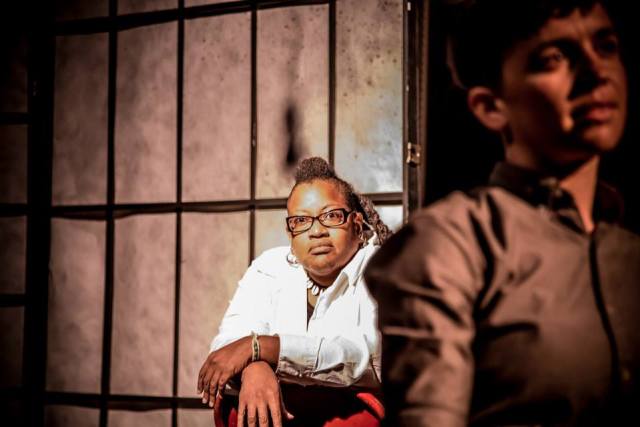
Moxie G. Rogue and Hannah Pepper Cunningham. Photo by Melisa Cardona.
In her years as a bartender, Alda noticed more affluent lesbians, from suburban River Ridge, staying away from the bars. “The higher the class they were, the less likely they were to be at Charlene’s, or any of the bars at all.” These “River Ridge dykes,” who were more likely to live on their own in spacious homes and apartments, socialized at private house parties. “The lower the socioeconomic class of women, the more likely they were to be in the bars, because that’s where they could go and nurse one beer all night,” Alda told me.
Crystal Little, a lesbian trans woman, was openly rejected at Charlene’s in the ’90s. She was an active member of the LGBT Community Center and would go into the bar to drop off flyers for events. “I was known but I was also known as a trans woman,” she told me. “We were not welcome. You might have one drink and then the bartender might suggest that you go somewhere else. ‘Cuz we were not real women.” Crystal found a more welcoming environment at Rubyfruit Jungle, a lesbian club that didn’t “give a damn” about who came in the doors.
Back in the closet
Juanita and Leslie ran Les Pierres for almost a decade before they lost their lease on the building. They put their bar supplies in storage but lost everything in a burglary, making their prospects for re-opening impossible. Charlene’s closed in 1999, due to financial struggles, after 22 years of operation. Today there are plenty of gay men’s bars in New Orleans and a handful of pop-up parties that cater to queer and trans folks, but no lesbian bars.
All around the country lesbian bars are shutting their doors, or are already gone. Robin’s article for Autostraddle about the closing of the Lex in San Francisco attributes the disappearance of lesbian bars to gentrification, and even monogamy. Rising rents make local businesses unsustainable and when couples settle down they stop frequenting bars as much. Here in New Orleans interviewees have suggested that increasing acceptance of queerness has made bars less necessary as a safe haven. But as some forms of queerness become more mainstream, who gets left behind?
“It makes me very sad that I do not have a place to hang out,” Liz told me. “You know, it’s kind of like back in the closet again.” Many of the women we spoke with have active social lives; others are deeply lonely and isolated. One interviewee, a former bartender who recalled connecting women in need with free services from other customers, found herself homeless and living well below the poverty line at the time of our interview.
According to Juanita, the priorities of our community are out of whack. “I don’t want anybody to get it wrong and think that I am against gay people getting married,” she told me. “I’m not against it. It’s just not my forte. If you want me to get up and walk for free medical services, I’m there. Those are things that are needed. We have nothing for the gay women. And I don’t like it. Not because I’m gonna get old and gay. Because I’m already old and gay. But they got some of us that needs a little bit more than what we’re giving to one another.”
Last Call celebrates the stories of our elders while also acknowledging that they are still among us. The people who paved the way for us to be out and proud, whose lived experiences gave birth to the queer politics that shapes our identities, often live right around the corner. Many of them are active on social media and might just be a few clicks away from connecting with us. Others don’t use computers or don’t have internet access. Without physical spaces to find each other, how are we to learn from their triumphs and mistakes?
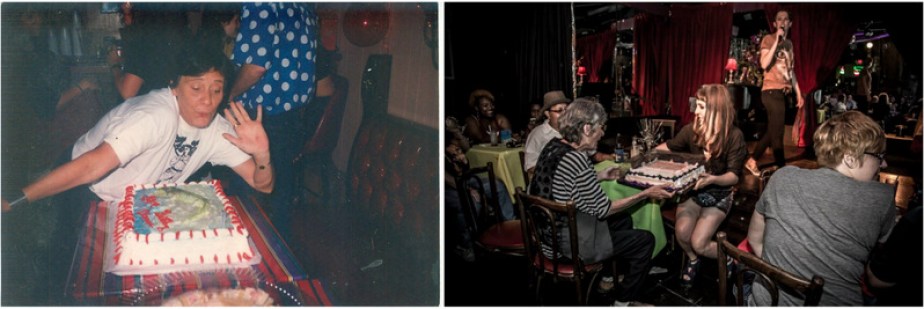
L: Dianne Schneider on a busy night at her sister Charlene’s bar. Photo courtesy of Dianne Schneider.
R: Rachel Lee presenting a birthday cake to Dianne Schneider during a Last Call benefit held in the space that used to be Charlene’s. It is no longer a lesbian bar. Photo by Melisa Cardona.
An invitation to listen
The Last Call podcast weaves together the stories of our elders with conversations and questions that we still grapple with today. We focus on a different topic each month: race, gender identity, police brutality, activism. The first episode is an aural collage of coming out stories from five people who frequented dyke bars in New Orleans with an original score by my co-producers Free Feral and Peter Bowling. Their words are funny, tender, and wise. Please join us in listening.
Last Call is grateful for the support of Alternate ROOTS, a network of artists dedicated to undoing oppression in the South. You can listen to our podcast here and follow the project on Facebook or on our website.
Gay, Interrupted: On Navigating Gaybourhoods As A Queer Brown Woman
“Helloooo,” he lowers his eyelids flirtatiously and giggles, drunkenly clinging onto his partner. Having a markedly low tolerance for street harassment, I am immediately put on edge. I relax a little into the realisation that my friend and I — a trans man and an androgynous lesbian, both small-ish Asians — could easily be mistaken for two gay men ourselves.
Then another voice calls out, “Ni hao!”
I pause. Did he really just say that? How did he, why did he— do I really look Chinese? (Coming from a background of being erased in Chinese-majority environments, that particular remark stung just that little bit more. If we’re going to be dishing out drive-by racism here, my preferred slur is “terrorist.”) Does that even matter? Am I being oversensitive, or overthinking this?
Are we not supposed to be here?
They laugh.
“Fuck you!” I respond, a bit too belatedly.
We’re walking back to our hostel through Manchester’s Gay Village, having just talked about exactly this over dinner: white cis gay men dominating queer spaces. White cis gay men making us feel unsafe and unwelcome; white cis gay men stumbling uncomfortably close to us while yelling “ni hao!” under street signs that warn against the consequences of homophobic hate speech.
A friend shares that the first time she visited a bar in the Village, a drag queen was telling a joke about Chinese folks. Her unanticipated entrance invited an awkward pause, her physical presence selfishly disrupting the previously easy laughter of the audience. That is exactly what navigating gay districts as a queer brown woman often makes you feel like: an interruption.
The first thing you’ll notice about the Village is that it’s really pretty. Being accustomed to the damp grime, broken glass and rowdy crowds of London’s Soho, I’d add unexpectedly pretty. Flowers line the streets that in turn straddle a calm, picturesque canal, the kind that seems like it must have been made to be strolled along and never anything as crude as channelling flows of water. Plastered next to pastel-coloured posters promoting an upcoming trans festival are large, bold signs warning that hate crimes are taken seriously by the Manchester Metropolitan Police. Looking down on all of them are rainbow-coloured street signs declaring, “Smile! You’re on CCTV.”
The place where we had dinner, the Richmond Tea Rooms, is the pinnacle of this. Owned by two men, its over-the-top decor queers the British fetishisation of tea and temperance that tearooms and their associated rituals symbolise. We sat in Alice in Wonderland-themed seats overwhelmed by plush cushions with Heather, who lived nearby and whom we had just met in London a couple of days earlier at an Autostraddle meet-up. She told us that the Village’s main drawback is that it still doesn’t feel safe at night so the flowers and police warnings were part of a recent attempt to “clean up” the area.
There’s an argument for policing trans-, bi- and homophobic violence, of course: according to Stonewall’s 2013 Gay British Crime Survey, 1 in 6 LGB people in the UK had been the victim of a homophobic hate crime or incident in the past 3 years. Stonewall in England & Wales does not (yet) represent the trans community, but trans people, especially trans women and sex workers, are disproportionately subject to harassment, violence and murder on the streets. The nation’s only memorial commemorating the victims of transphobic hate crimes was set up in the Village in 2013… and vandalised just days after.
What’s less clear is whether there’s as strong a case for the police to be doing it. Urban gay neighbourhoods, whether in Manchester, London or elsewhere, almost always arose from the fear of queerphobic violence, sociopolitical disenfranchisement, and the criminalisation of sex and sex work — all of this frequently at the hands of the police. All of this still frequently happens at the hands of the police, so it’s worth asking: are the pride flags decorating blue uniforms today a sign of the times or simply of short-term memory?
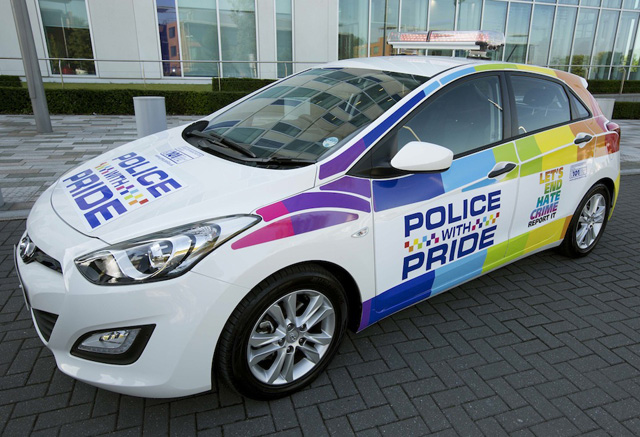
If we slap a rainbow on it can we call it even on decades of violence now?
via motors.co.uk
Criminal justice system reform is slowly working its way into the LGBTQ activist consciousness, but not without its hiccups. At a Dyke March in 2013, a well-known queer feminist added anti-police chants to the event’s usual rally cries as we marched through the heart of central London. Responding to those who grumbled about her going off-message (including a police officer who nudged a march participant near me and asked quietly, “What did we do?”), she later added on Twitter that if we couldn’t see how all police were scum, we weren’t thinking intersectionally enough. Fair. Maybe.
Here’s the thing though: if she had been thinking “intersectionally” enough, she would have known that had the policewomen been sufficiently provoked, it is not her, a white woman, who would have been hauled off to jail and kept there. It is not her, a British citizen, who would have been asked to leave the country. It is not her name and her face which would have made headlines the next day. Corralled between police officers with the authority to arrest us and white anarchists with little personally at stake if they did, my enthusiasm about participating in a public queer event for the first time gave way to unease and insecurity. It’s important to recognise that we do not want to invite the mechanisms of state violence and surveillance into our spaces and onto the most vulnerable members of our communities, but surely the solution can’t lie in offering up their bodies to make a political point.
Earlier that day Jeremy and I had been reading through TripAdvisor reviews, taking perverse pleasure (as we queers do) in the hurt feelings of straight people who cried oppression when their hens do in the Village were ruined by, you know, actual gay folks. “If people think homophobia is bad, go and see first hand the hetrophobia (sic) on display at G-A-Y!!” declares one. Another grumbles about “staff watching normal straights all the time” (emphasis mine), while my personal favourite makes a gloriously revealing typo in stating, “as a straight person I feel prejudiced on occasions.”
“If a typically ‘straight’ venue treated people like this they’d be sued for discrimination! However I don’t let it bother me (because it really doesn’t) and continue my night elsewhere.” (I imagine the unwritten part of the review goes, “Specifically, in front of my computer, writing a lengthy online diatribe about things that totally didn’t bother me at all.”)
“Sort it out, we all want to be in a prejudice free world.”
Yeah. Don’t we all. These reviews got across the point loud and clear that straight folks really, really do not enjoy being left out of G-A-Y, perhaps similar to how queer people do not like being excluded from healthy family environments, the right to self-determination and expression, employment and education opportunities, media and political representation, and life itself.
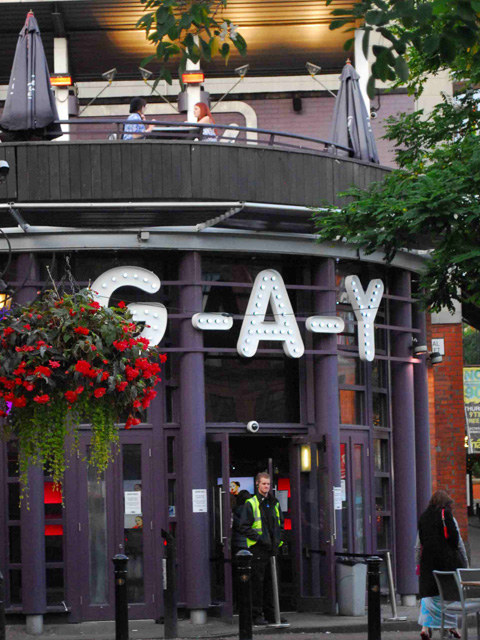
You’d think the name would have tipped them off, but nope.
via John Coxon Photography
Unfortunately I struggle to empathise with the stresses of having to find a night scene friendly to heterosexuals even after going through pages and pages of similarly worded reviews, but one comment that really gave me pause was one that was meant to be a positive endorsement of the Village:
“It is a popular destination for Hen parties and they’re welcome in most bars […] and you will spot a drag queen or two whilst wandering from bar to bar!”
You will spot a drag queen or two. Maybe if you’re lucky!
Signalling another massive shift from the days of sex in the bushes (well, the days of more sex in the bushes), gay districts are now tourist attractions promoted by city councils on glossy brochures and rainbow-themed (of course!) webpages. Part of this is because of the massive urban rejuvenation efforts that have transformed gaybourhoods worldwide in the past few decades, whether from funder-backed urban redevelopment projects or the steady gentrification of white, middle-class gays, making them safe, alluring destinations for the curious wanderer looking for an “alternative” night out. Yet part of this — the part that is not anything new, and definitely not anywhere near progressive — is because queer people have always been seen as tourist attractions. It’s just that now we’re more easily and acceptably consumed in moderate, measured doses within designated areas.
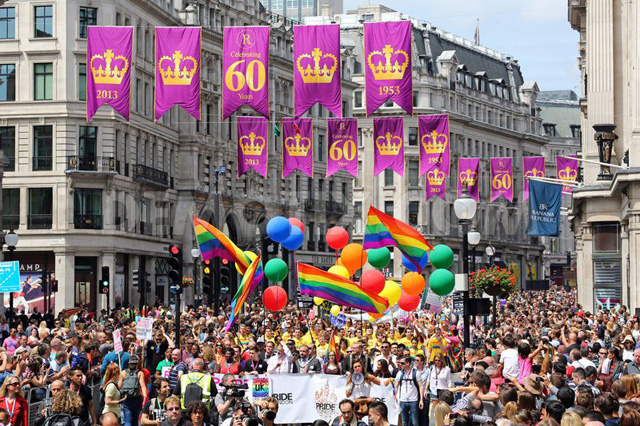
Liberation™, brought to you by Barclays. (You might even spot a drag queen or two!)
via Dos Manzanas
In going from private closet to public spectacle, shady neighbourhood to international attraction, have we really reclaimed pride from shame or played into dynamics of commodification and assimilationism to our detriment? There’s no easy way to talk about The Man here when the mainstreaming of gay culture has, for many, made it possible to survive and even thrive. Gay’s the Word might never be the radical socialist space it once could have been, but neither does it invite the suspicion and sabotage it once did. Pride marches are now sponsored by big corporations with dodgy politics and even worse labour practices, but they also inspire vulnerable queer youth to imagine futures that aren’t crushing dead-ends. Playing straight, playing for straights — at-risk queers have long learnt how to make heterosexuality and capitalism work for them to survive. But let’s also not kid ourselves in thinking that the respectability politics that underlie the progress of the LGBTQ “community” has uniformly made it better for all, when sex workers and saunas are swept away to make space for parties and wedding proposals. Gay districts are safer, more open and more profitable than ever before, but for whom?
As I’m trying to get a grasp on what gay districts stand for and how we should preserve this, it’s funny enough to think of straight tourists being side-eyed by butch bouncers but decidedly less amusing when I think back to how at a London Autostraddle meet-up in 2012 our tiny assemblage of queer women was rejected entry into a bar in Soho. The bouncers weren’t convinced we were gay, even though we probably collectively had more piercings than hair on the left sides of our heads. Do we have to perform gay to be allowed to be gay in public? How do we do this, when “looking gay” is inherently coloured by class, race and gender? Queer women and men alike have adopted variations on the “working class” attires of flannel shirts and combat boots as queer uniforms, for instance, but it’s hard to say if a queer Sun-reading Mancunian man would pass G-A-Y’s bouncers’ tests as easily as a young skinny boy in a deep V-neck t-shirt. Muslim women participating in gay pride marches get called “suicide bombers,” while white women in rainbow niqabs are applauded for their courage in bringing to light the struggles of poor, third world brown queers. And that one time our ragtag group of mostly ladyqueers got turned down in Soho is just one of many incidents of queer women’s sexualities being disbelieved, trivialised and invisibilised. Endless media and activist discussions of homophobia and sexism — on “fag hags,” on bachelorette parties in gay bars, on gay men feeling entitled to touching women’s bodies — take as their opposing players gay men and straight women, ignoring the queer and trans women whose bodies make up the battleground.
The gendered dynamics of gay spaces extend far beyond the policing of “looking gay” at bar entrances, of course, whether we’re talking about the gender divide between the Castro and Oakland because of economic disparities between gay men and women, or feminist and lesbian spaces (particularly bookstores) and the organisations behind them being chronically underfunded and frequently the butts of jokes in gay media, including in everyone’s latest favourite tearjerker, Pride. (Don’t get me wrong, it is an excellent film that I strongly recommend. Yet it unfortunately also follows in a long-established tradition of trivialising queer women’s needs for their own spaces.) The year that I arrived in London, First Out Café, the city’s first daytime gay venue, closed. The year that I left, Candy Bar, the biggest (and only wheelchair-accessible) lesbian bar, followed suit. This isn’t unique to London, as many other spaces that cater primarily cater to queer women and other folks struggle to survive while gay men’s clubs and bars thrive. As Carmen writes from DC, “It’s not possible for us to know, just yet, how our community will change now that we don’t have a central place to house it.”
I know intimately the promise and allure of gay districts, even as someone whose fullest extent of engagement with “the scene” is often just standing awkwardly in a corner sipping a mocktail while friends unsuccessfully implore me to dance. As an 18-year-old in London, newly arrived from a home very far away, my first night in the basement of Ku Bar — on the one night they have designated for women — was eye-opening. I was intimidated by the alcohol, loud music and physical intimacy, but I’d never been in a room with that many queer people before and it was affirming in a way I didn’t even know I needed it to be. Particularly memorable for me was a moment when a middle-aged Chinese lady whose business wear resembled that of the homophobic principal of my junior college casually walked past, wineglass in hand.
Neither are gay districts necessarily now devoid of hope for me. In my last week in London I finally caught Soho’s annual Village Fête, which gave space to community groups, queer performers, and the odd and brilliantly endearing waiters’ race, in which waiters well, race, along Old Compton Street balancing a wine bottle and glass on a tray. Instead of the Metropolitan Police, the Fête was cared for by the Lesbian & Gay Foundation’s Angels in pink fluorescent vests, who were borrowed from Manchester’s Gay Village and whose first job was to listen to whatever people needed to say and to provide support where necessary, whether it was directions, a safe ride home, or yes, a police call.
Still, that first time I left that gay bar in Soho, I was mainly afraid of running into people I knew from back home. (Like Manchester, the gay district in London is right next to the city’s Chinatown, which doesn’t do much to assuage the fears of closeted queer Asians like I was then.) I didn’t know then to be wary, instead, of those I’d just shared the small, dark basement with. I hadn’t expected then that the vast majority of racism and sexism I’d experience in my three years in London — whether it was yelled at me on the streets or calmly, condescendingly expressed in meetings about the rightful “priorities” of the LGBTQ movement — would be from other queer people.
Gay districts are constructed as havens, as sanctuaries, as places where expression and identity can freely tumble forward in messy, drunken messes. But this glosses over the realities of those of us who are policed for not being gay enough or for being too queer, for dressing wrong, for looking wrong, for being wrong; this doesn’t confront the complexities of police and policing at the intersections of queerphobia, racism, sexism and classism. This picture simply moves on past the interruptions that unruly bodies present, the disruptions to social norms that gave rise to gaybourhoods in the first place. This picture prioritises comfort over challenge, compromising the promise of safety and welcome that these neighbourhoods are supposed to stand for for those of us who aren’t white cis gay men. Who are the “gays” for whom gay districts are built (around)? Who gets to decide?
Are we not supposed to be here?
The State of the Lesbian Bar: Portland Sees Popups Replace the E Room
In Autostraddle’s The State of the Lesbian Bar, we’re taking a look at lesbian bars around the country as the possibility of extinction looms ever closer.
Nobody I knew, from the Bay area or not, loved the Lexington over any other bar. But when we heard it was closing last month a collective sigh weaved its way through the queer internet and the feeling of sadness permeated the west coast. Conflicted as we may be, we really feel the loss of our lesbian bars as they continue to be picked off one by one due to gentrification, domestication, assimilation etc.
It happened here in stages, a half-hearted semi-loss that happens while you aren’t really looking until it becomes just one more thing that has changed Portland to the point of unrecognizability.
The Egyptian Club, affectionately known as the E Room, opened in 1995 at the corner of 37th and Division. There were no monthly dance parties bursting at the seams and taking up prime real estate at a major club on a Saturday night like there are today. Owner Kim Davis recalled this time when “people threw eggs at the building and assaulted the women bouncers outside the door.” I wasn’t old enough to go to bars yet, but I was here and going to a gay dance club for the all ages set called The City, which was fraught with its own perils.
In between 1995 and when I returned to Portland in 2004 it’s difficult to discern if there were any other lesbian bars open at the time. Lesbians in their 30s and 40s talk about a bar called Choices, but it was either closed or on the wane in popularity by the time I moved back. There were still several gay bars, that all-ages nightclub was still around, though with a different name in a different location, and there was a coffeeshop that unofficially catered to the gay lady. But the E Room was the only PDX lesbian bar I ever knew, and that holds true for most current local dykes.
Fast forward to 2010 when I’d been back in Portland for six years writing about the local queer community in some capacity, mostly with a blog I started at OregonLive.com and then took independent in 2009 called qPDX. The queer scene in Portland was mixed and scattered and always drama-filled but it was busy, it was full of action, and there was never a lack of events. For over five years I wrote extensive weekend picks posts every Thursday. It was, and is, a major destination for queer women. It’s evident in our Queer Girl City Guide from a couple years ago, where the Egyptian gets only a quick shout out before moving on to a long list of queer-friendly bars.
I wasn’t a regular at the E Room, but I knew plenty of folks who were, and I would certainly drag myself down to the southeast part of town when there was an important event. Like our earlier post about the Lexington mentioned, folks weren’t the friendliest.
Maybe it was because I had a rocky relationship with some of the bartenders’ BFFs/exes, but I don’t think I was the only one that felt uneasy there, even as someone for whom the space was supposed to be safe and comfortable. The 3 room bar was huge, cavernous and dark, with no windows and no natural light. When smoking was banned in bars in 2008 they had a huge cleanup to wipe the nicotine stains from the walls, but it was still dirty. The surly bouncer scowled not just at men or straight people when they entered, but all of us ladies trying to make the space our own. The bartenders weren’t much nicer. The patrons, too, were cliquey. You were either an E Room regular or you were some other queer from some other part of town infiltrating the SE Portland dive. I was part of the queer exodus to North Portland so I was part of this excluded group. A review by Long time PDX lessie on one of my favorite local bar listings, BarFly, puts it bluntly, if not eloquently, with this sentiment I often heard echoed:
The only reason this place has remained open is because IT IS the only lesbian bar in town. If someone were to open a club that wasn’t as dirty, smoky, nasty, and trampy, ER would go down in flames. Ask anyone and they say, “I don’t really like the ER, but it’s the only place to go.” Check out the place on nights of monthly parties. It’s dead. Yes, the staff is friendly…well most the staff-the old timers, the young baby-dykes…they think their $h!t don’t stink.
I, along with a slew of others, hope and pray that a newer, better, cleaner, nice smelling club comes along…..
So I, and many of my peers, had mixed emotions when they began their descent into oblivion.
It began with a betrayal.
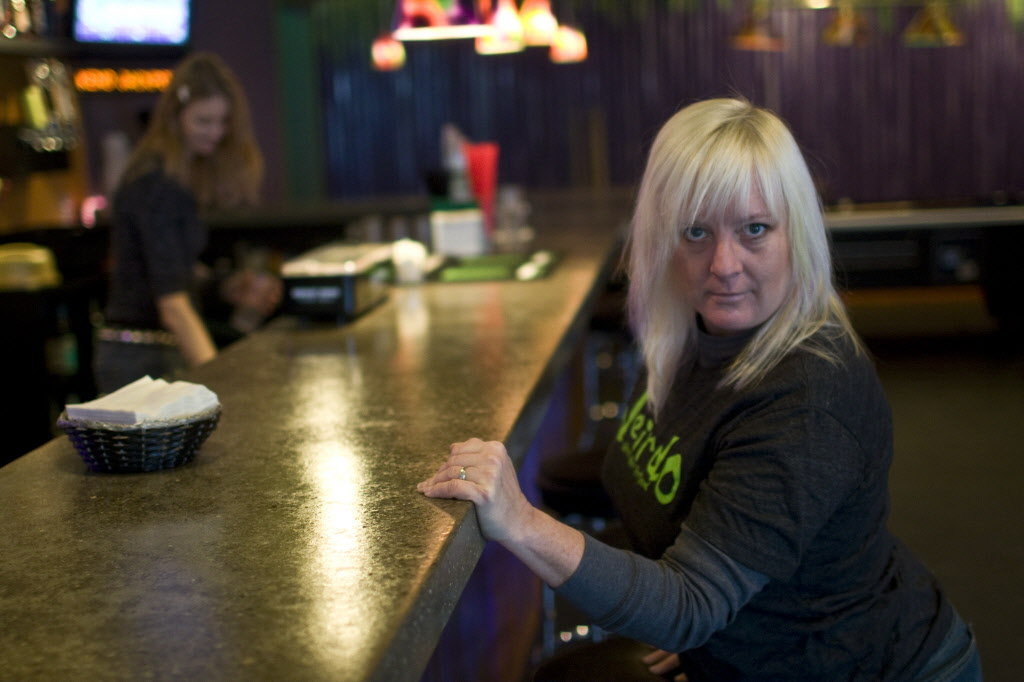
E Room owner Kim Davis. Photo by Jamie Francis / The Oregonian
In the Fall of 2009 rumors began that the E Room would close. For months every event there was the “final” or “last” one. People pleaded with them to accept help in the form of a “Save the E Room” fundraiser. So when the news finally became official and it turned out that they were simply rebranding as The Weird Bar it came as an even bigger blow. The premise that this new venue was for anyone that considered themselves a little “weird” but was “normal-friendly” felt uncomfortable at best and, in a way, a “weird” take on the notion of reclaiming the word queer. They at once insulted their own community while simultaneously alienating them in the name of “inclusivity.” Further explanation of the process did little to help the situation. In a press release Davis explained:
When we first announced the closing we weren’t sure what direction we were headed, we just knew we could not keep doing what we are doing. We were meeting with a developer, and were also involved in conversations with private parties and a business broker. We were weighing all of our options. If our economy was in better shape we wouldn’t have had to make these tough decisions. It seems that so many of our customers are laid off, or have very little work, and this has been very evident over the last couple of years. Please know that we did not come to this decision lightly.
After much deliberation, we came up with a concept which is not completely complete yet. But, we made the decision to go with an all-inclusive venue (not to be confused with a straight venue). But…what to call it? This bar has such a weird layout. It’s such a weird bar. Hey! That’s the name! Weird Bar! We could have some weird drinks, weird promotions…all sorts of weird stuff and nothing would ever have to make sense again! We believe that all people are “weird” in one way or another…our uniqueness is what makes us special…makes us human. So, we would like to invite you to the grand opening of “Weird Bar”, on October 16. Weird Bar will be an all-inclusive space where anyone can be themselves, whatever form of “queerness” that may entail.
Celebrating differences. Enjoying common ground.
Aside from feeling somewhat disingenuous, it was also one of the most poorly written pieces of PR I had ever read, and went to the heart of their inability to successfully strategize as a business or grow with the community. Local fellow queer business owner and activist Stacy Bias responded with this heartfelt message:
I feel “weird” about the only lesbian bar closing and opening up again with the same ownership as straight bar. I get that it’s a niche market that you felt couldn’t sustain you, but there were other options that would have allowed you to be as loyal to your clientele as they have been to you over the years. Regardless, if you knew that you were opening up a new bar in the same space — a new bar that your loyal clientele would feel less at home in, that should have been transparent from the start. It’s like taking an ice cream cone away from your daughter and giving it to your son — when he’s already holding an ice cream cone in his other hand. Straight folks have every other bar in Portland. When the e-room closes, dykes have no focused space left at all.
…they’re throwing the dykes under the bus by not openly declaring their loyalty any longer to the queer community and catering to the so-called “normal” crowd (with, ironically, a bar called “weird.”) Having a conversation with the community about it, saying they’re struggling and need to open it up, being open about the process and giving folks a chance to have their feelings about it would have been a much better choice. It’s a business, yes, but by virtue of being a community gathering place for as long as it has, it isn’t just a business because of the emotional impact it has on the people who have had a safe place to go for so long and might not have it any longer…
We all hated the E Room but, as bad as it was, we were sad to see it go because it was all we had. Once it began operating as the Weird Bar there was really nothing left for us there. All the things we hated — uninviting space, watery drinks — were still there, while the only reason to go, that is was a dedicated dyke bar, was gone. In less than a year, the Weird Bar was closed for good.
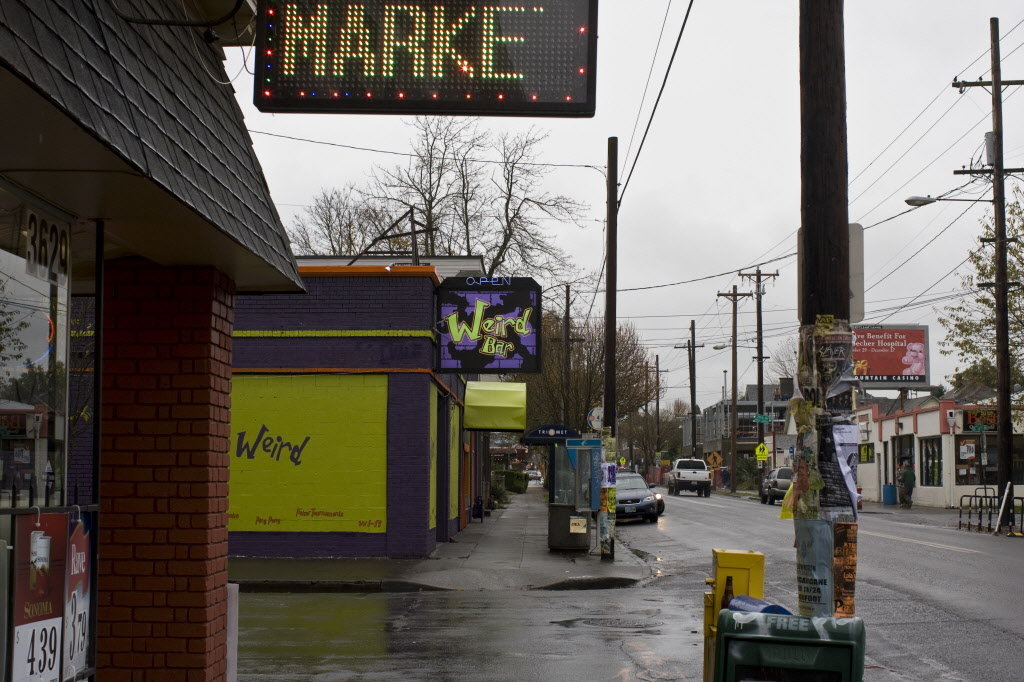
The E Room reopened as The Weird Bar. Photo by Jamie Francis / The Oregonian
Now, arguably, it is not all we have. On any given day my tired post-30 year old self can turn down numerous invites to this queer party, that gay rock show, a lesbian sing-a-long or a transmasculine artist’s opening show. But there is no lesbian bar. Sure, there’s the Florida Room, North Portland’s de facto dyke hangout that we all pretend to make fun of but run into each other at every week nonetheless. It’s welcoming enough to a diverse queer and genderqueer crowd, along with the rest of hipster PDX. But it is not queer owned and it is not named as a queer space on any level.
Is that important? Perhaps not. When I ask that question of the youngest queers often the immediate response I get is no. They feel accepted in this town and are happy to frequent any bar with a good happy hour menu because they are likely not to be the only queers there.
“Not having a named space helps keep things fresh,” says one such young queer woman, Sarah Hardy. “My dad and [his trans friend] were in town recently and went to Embers [a longstanding gay bar complete with rainbow facade] and it was terrible.” They were unimpressed with the creepy and distinctly non-trans-friendly 80s/90s vibe.
This is an atmosphere and aesthetic that the E Room ascribed to. If they had been better designers, hired younger consultants, could it have become a place where the next generation wanted to hang out? If, instead of rebranding as being more inclusive to a “straight community,” could they have rebranded to reach a wider queer audience, thereby becoming a part of the rapidly changing Southeast Division corridor instead of falling victim to it?
Gentrification aside, this is another reason younger queers seem unenthusiastic about protecting lesbian bars. A transmasculine community member points out that naming a space is necessarily exclusionary and that, for a community invested in intersectionality and multi-faceted identities, this seems counterproductive.
And yet, others do feel like marginalized communities deserve named spaces, even as that definition does and must expand. These queers, often in their late 20s and 30s, do readily admit to a sadness at the death of the lesbian bar… at least without a more open queer bar replacement. And there is an argument to be made that marginalized communities still need named spaces. As much as lesbian bars should, and have, opened their doors to trans clientele and those throughout the gender spectrum, sexism and cissexism are still very much a part of the LGBT community as a whole. Can making a named space for the feminine and/or for women be a stance against such sexism? Local party promoter, DJ and commentator Katey Pants points out that, “…authenticity and desirability is placed in what is masculine in all communities. Thus, things that are not masculine of center and/or fag spaces are seen as stupid, joke worthy, uncouth, silly, jokes, pathetic, etc.” She goes on to say that few people ID as dykes/lesbians anymore, and though she has mixed feelings about those words herself, she is clearly concerned about femme silencing.
Any replacement for a dying breed of bar would look very different. If you’re not willing to grow with the community, accept and cater to trans people, people of color and have a staff that reflects the patrons, you are doomed to die off. But though so many have talked about their visions for a new queer bartopia no one has yet been able to make it a reality. Is this due to lack of business savvy, lack of capital or just plain old Portland apathy? It’s hard to say. One friend even suggested that the owners of the Lexington open up shop here seeing as the real estate is so much cheaper and isn’t every other Californian buying up Oregon real estate anyway? It might as well be us (if we define us as LGBT and not as Oregonians that is).
What about those California, east coast, southern, midwestern and other transplants anyway? As a Portland native, it’s easy for me to feel plugged in to all the queer events taking place. But since the demise of local queer publications (almost in tandem with our bars) it can be hard to keep track of these rotating spaces if you’re less familiar with the party promoters, DJs, event planners etc. And if you’re from out of town, forget about it; no queer parties appear in that Lonely Planet, hip and up-to-date as it may be for a travel guide.
Interestingly, this conversation took place at an event called “Temporary Lesbian Bar” which is the closest thing I’ve seen to a successful recent named queer women’s space in PDX. Started by musician Katy Davidson, TLB is a fairly intimate affair with board games, pizza and conversation as well as a tiny dance floor. “Though the event is clearly not limited to lesbians alone, it feels powerful to set aside a space to encourage women to commune. I purposely keep the volume of the music at a level in which it is loud enough to dance, but also quiet enough to converse,” she says before going on to talk about using to term “lesbian” both ironically and as a tip of the hat to our elders. For even more real irony, actually quite sad, she expounds on women’s spaces saying, “I’m inspired by the longevity of the Lexington Club in San Francisco, for example. Purely from a personal standpoint… Let’s face it, we live in a world now where lines are becoming more and more blurred. In spite of this, women are still oppressed in our country, even in the most seemingly innocuous of ways. Women should have a space! It doesn’t have to be exclusive, but I believe women should be encouraged to interact together in meaningful ways.”
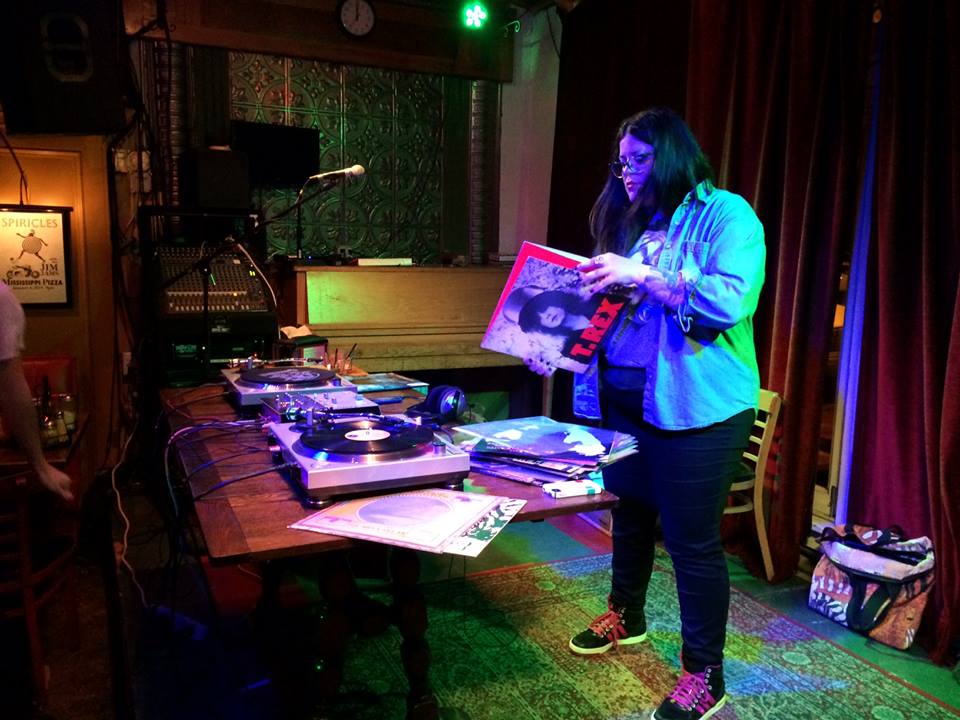
The makeshift DJ booth at Temporary Lesbian Bar
TLB has fulfilled this need in a very successful way that feels more like a neighborhood bar than other events, and I understand the sentiment that perhaps an everyday establishment is unsustainable even if I, personally, wish I had a place to go whenever I want rather than having to wait for a very specific 4 hour window once a month on Saturday evening. Certainly, it seems, anecdotally, that queers in Portland spend enough money on food and drink that we could hold together a bar/cafe/restaurant if we really rallied behind it. But maybe it owes more to an increasing cultural inability to concentrate, a kind of collective attention deficit, that the lesbian bar can only survive in popup form. Even lesbians in their 40s such as Caryn Brooks seem to think the move is a good one. “I think it’s actually more vibrant now than it was when there was a lesbian bar,” she notes. “It’s nimble, able to respond to geography and demographics. There’s no going back.”
But nimble also implies a level of instability, inconstancy to me, a comfort that I might miss, even as I sit here with 20 Chrome tabs open and the television on. And then there’s the anxiety that comes from not being able to keep up, unsure if you saw the right Facebook invite and needing to go to every event just so you won’t have FOMO (Fear of Missing Out) if you can’t get out at the exact time everyone else is.
Even if you are in the know and ready to party, you might not want to wait until 10pm on a Saturday to feel like you are among your people. Taylor Hatmaker, former Autostraddle Tech Editor, doesn’t like that everything has shifted to a “get fucked up one night a week at this special party” model and would welcome a place where you can get a drink or a cup of tea at any time. A bar may revolve around alcohol to some extent, but not every dive is necessarily a major event (which most besides TLB seem to bill themselves as) where there is added social pressure and a concentrated air of consumption that is distinctly not your local queer Cheers. Also, that place where everybody knows your name is more likely to be queer owned than a normally straight club whose goal is to be make money off of drunk queers jumping toward frenzied bartenders in search of their third double over giving back to the community by hosting a youth resource center fundraising drag show. As terrible as the decor may have been, these were things the E Room did.
Here’s where I’m going to let myself get a little nostalgic, at least the kind of nostalgia that comes from things you weren’t there for, like how I always complain that I’m sad I missed the 70s because they sounded, like, so rad (according to my aunt, my mother and the Lesbian Herstory Archives). Because we, as individuals, may not have a particular connection to a particular lesbian bar that has gone under doesn’t mean that the death of the lesbian bar, in general, isn’t a tragedy. Clearly, I had my own issues with the E Room. I thought it was dirty; I thought the bartenders were mean; I was appalled by the website and the corresponding paint job. Straddlers have had similar thoughts about the Lex. But there is a whole history of the lesbian bar that we have already missed and, in writing this article, I have discovered some of that, and with it a whole new sadness.
The LGBT history of Portland, Oregon is rich and surprisingly old for such a “young” city. A 1999 documentation of a Gay Portland Walking Tour introduces us to the vast number of bars that catered to the gay and lesbian population throughout the 20th Century. Clearly bars have helped build community. Highlights include The Milwaukee Tavern (1535 W Burnside though address since renumbered) which was “fingered” in the 1964 vice reports of Chief of Police McNamara as being a lesbian hangout:
The reports noted that it was frequented almost entirely by women who “dress like men, act like men, and are believed to be from areas outside Portland.” Owner Edna Jordal was a widow at the time of the Portland City Council hearings in December 1964. She had worked previously at the Transfusion Inn, a notorious lesbian dive located on Southwest Front almost at water level. The only employees at the Milwaukee Tavern were women. One, the manager, was identified in the records as “Miss Lewis” who had “served eight years in the service with an honorable discharge,” and the other a young woman of 22 who moonlighted in the evenings following her day job at Meier & Frank.
Then there was the The Buick Café (1239 SW Washington) a little place to grab some nosh downtown that late 40s/early 50s Police Department’s Women’s Protective Division claimed by frequented by lesbians who took up space at the Music Hall, a nightclub on 10th and Stark. A precinct report stated that this group tried to pick up ladies at the club and, upon failure, moved to the cafe (not a bad tactic if you ask me) adding, “these women were recently ousted from San Francisco for their actions and are, apparently, confirmed lesbians.” So even then the California exodus to Oregon was a thing.
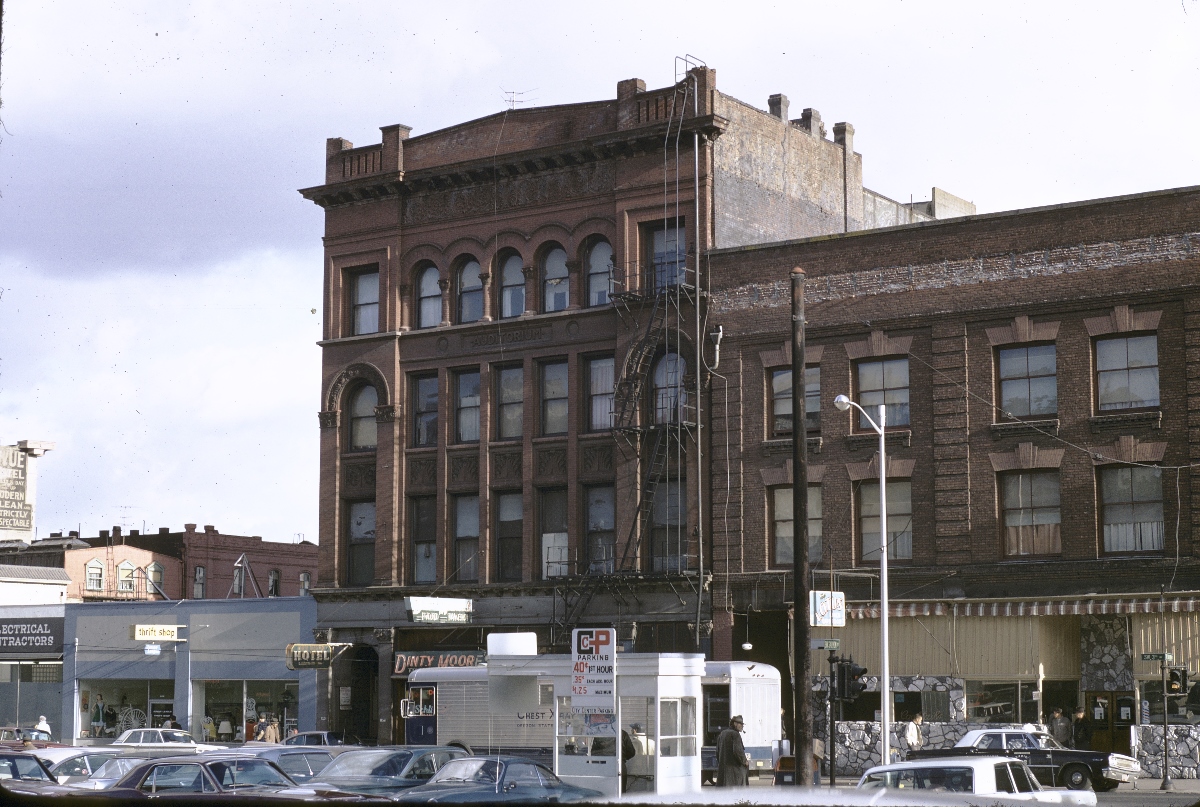
Dinty Moore’s, a lesbian bar in the 1970s, c. 1967
In an amazing web/mobile app local history project called the PDX Social History Guide I discovered a treatise on lesbian spaces by Portland State University Professor Ann Mussey. Aside from her stories about collective living experiments, which hopefully I’ll get to in another article some day because I once thought I’d do a PhD on the subject, she also discusses early lesbian bars such as Magic Gardens and Dinty Moore’s.
They were important to her because there weren’t other public places where women could dance, hold hands, flirt, but even then she says it wasn’t the only thing happening. There were their own quasi-public collectives and get-togethers. Women have always wanted more than bars. But we still want bars. And the way Murray describes the Dinty Moore dive, with it’s wood paneled walls and piles of liquor bottles reflected in the giant mirror, is a place I wish I could have seen. And though she readily admits that some might have, rightly, called her a “class tourist,” her community was also necessarily invested in creating mixed class spaces.
Then there was Magic Gardens, which was owned by a woman and tended by gay twins. Even then, these spaces didn’t last. Magic Gardens turned into a strip club, and though it was not, as it was to Mussey’s naïve young mind, a strip club specifically for women, it has maintained itself as one of the most female-friendly, worker-managed strip clubs in our erotic dance fueled city. Now even this form of the business is going under, as it is set to close at the end of this year.
Mussey also talks of the Rising Moon, which was owned by lesbians, and which had issues with racial tension and a leafleting campaign by lesbians of color who believed they had been unfairly targeted in carding. She speaks of the Tasha’s, The Ramp, 316 and others which were all short-lived and imperfect. So there has never been just the right place for all queer women to sing Kum-Ba-Yah together, but we have continued to desire a place to be, have worked toward a space to be together even in our differences. So what happens when these places, as problematic as they may have been, disappear altogether?
In some ways, nothing. We continue to have places to gather in both physical and virtual spaces and, goddess knows, we never have a lack of things to say. Conversations around queer women’s topics, which are vast and contain multitudes, happen everywhere all the time. But one of these should, perhaps, be a mourning of our loss of lesbian space, the lesbian bar, and what that means. Certainly we should be documenting it, and projects like the the Unknown Play Project are doing just that. Even as we struggle to move forward with new understandings of queer women and how we want to congregate and collect there is a powerful history that can feel missing. This juxtaposition of past and future has been felt in a lot of ways recently; I am thinking here of our recent roundtable on the passing of Leslie Feinberg, whose stories sited the bar as a place of beginning, understanding, butch/lesbian/trans/genderqueer life. We can grieve for what it stood for while simultaneously moving on.
As long as we keep making our own spaces.
Let’s Hash It Out: How Do You Feel About Men and Straight People Going To Lesbian Bars?
The jokey Vapid Fluff piece we published on Tuesday containing excerpts from negative Yelp reviews about lesbian bars by straight people and men has sparked debate on the “not-queers in queer spaces” situation offsite (specifically on reddit) and it seemed like it’d be worthwhile to hash it out here, too. I don’t know that there’s any subjective or objective truth to be found here, especially when what it means for it to be “okay” for non-queers (straight people and men) to occupy queer spaces is so vague to begin with.
Personally, the first bars I ever went to were gay male bars. I was underage and straight-identified a lot of the time, but they let me in! Whether I was accompanying my co-workers to Happy Hour in one of Hell’s Kitchen’s many gay dives after a hellish lunch shift at The Olive Garden, tagging along with my gay best friend to subdued upscale bars decorated like country clubs or dancing all night at Posh; I wet my feet in so many spaces that weren’t made for me.
But when I entered these spaces, my expectations of service were low. I didn’t expect the bartender to pay attention to me, the doorman to greet me with a smile, or really for anybody besides the people I’d come with to be nice to me. I was a guest in their space. Sure, it feels shitty to wait longer than everybody else for a drink, but it didn’t feel unjust. I certainly wouldn’t have run home and told Yelp about it like I did when that bitch in Berkeley fucked up my eyebrows. I was there with men who’d been beaten up in school for being gay, who’d been kicked out of their homes, who feared kissing their boyfriends in public, who were ignored by bartenders at straight bars. I deferred.
The majority of non-queers who enter queer bars probably have a similar state of mind — every straight person I’ve ever been in a queer space with has. But the Yelp reviews I pulled from for that post were specifically from people who felt some profound injustice was being served when they weren’t the center of attention at a lesbian bar. People who felt that a straight guy and his straight girlfriend not being a butch bartender’s #1 priority was “reverse discrimination” in action. The language used by those who felt wronged— language that often critiqued the lesbian’s body size, apparel, or gender presentation — said much more about why these people had a bad time than the complaint itself did.
So, we went over some of the most popular arguments we’ve heard on both sides, which we’ll present to you here. This isn’t all-encompassing or complete, it’s just a starter set of ideas for you to chew on.
FOR: Who Else Can I Go To The Bar With?
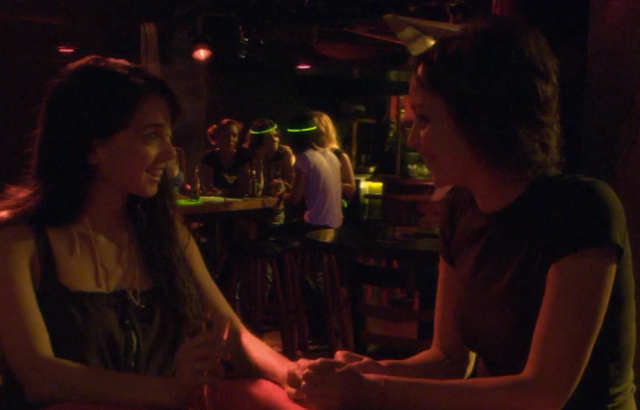
Jenny brings Annette to Twat The Night
Many brand-new gays and some longstanding gays have two options: go to a queer bar with a straight girl or a gay man, or don’t go at all. The brave best friends who volunteer to accompany us on these formative journeys into the wilderness shouldn’t be disrespected.
But… The strongest argument against this practice is that lesbian bars should be one place on earth where nobody has to worry that the girl they’re eyeing is straight. That girl might not eye you back or like you back and she may not be single and she may reject you but at least you won’t walk away feeling gross and stigmatized for being gay. (So, if you’re gonna bring your straight best friend to a bar, make sure she’s not somebody who’s not gonna be an asshole if they’re hit on politely by another girl!)
AGAINST: You Only Like Us Now ‘Cause It’s Safe and Trendy

You seem to love me now, but did you love me when I was down and out did you still have love for me straight girl
Would the straight people happily attending our bars in 2014 have jostled for admission in 2004? In 1994? In 1984? In 1944? There’s a storied history of non-oppressed populations playing oppression tourism, casually dropping in on this fun exotic underworld for their own amusement and then returning to their safe, non-oppressed lives afterwards. We fought hard for these spaces — once the only places where we could be ourselves — only to have them invaded by outsiders as soon as the stigma and legal threat faded.
A bisexual friend told me, “I always feel like straight people (of whatever gender) going to gay bars when they have not been explicitly invited by a gay person are like really proud of how down with gay people they are, like they’re very proud of it and assume that it is a space that is also for them because of how progressive they are! They go to Pride parades!”
But… Would every lesbian at the lesbian bar have jostled for admission in 2004? In 1994? In 1984? We can decry straight people for only stopping in now that it’s both legal and culturally acceptable… but it’s not just them who feel more comfortable attending lesbian bars now, it’s also us. Many of us weren’t brave enough to go until it was safe and trendy.
But but… The lesbians who were brave enough to go to the lesbian bars in 1994 probably have a right to be annoyed by fair-weather friends. Furthermore, actual queers uncomfortable with being seen in a queer space would’ve been putting a lot more on the line to attend one back then than a straight person, so comparing our hesitance to theirs might not be giving ourselves enough credit.
FOR: But some of my friends are straight and/or men!
So, you’ve got six friends. Three are gay and three are straight and you all wanna go out together and have fun. Do you go to the gay bar or the straight bar? I don’t know the answer to this question. I think probably I would suggest that we all come back to my place, get stoned, play Scattergories and eat Pumpkin Spice Oreos.
AGAINST: We have so few spaces just for us, please just let us have this one space, please, because like the whole world is your space and you can kiss wherever and we can only kiss here so please don’t
“Not to generalize, but there are better straight bars. Why would you even want to go to a lesbian bar?” A lesbian friend told me. “Whatever drink special or ambiance a person could claim to be looking for in a lesbian bar could easily be found in a straight bar down the street. There is just no fucking reason for guys to be there.”
Similarly, as in the Instagram screenshot I included in the Yelp reviews post, I’m baffled by heterosexual couples who visit queer bars without any queer friends and proceed to make out at the bar. It’s one thing to come with your gay friends to have a good time, but if you’re a straight person there on a romantic date with your monogamous straight partner… WHY? Just why?!!?
But… With so many lesbian bars shutting down, how much can anybody say our community is valuing this one precious space? And who, exactly, is the space for? Is it for all queers? At The Lex in San Francisco four years ago, my friends weren’t allowed in the playing-pool rotation because they weren’t part of the clique dominating the bar that night, you know? Sometimes when I read straight people complaining that they get the evil eye or the cold shoulder from queer patrons I wanna say, “Queer people get those same looks!” “Nobody talks to me either!”
FOR: Maybe once upon a time you too were the “straight girl” at the lesbian bar
Just being real.
AGAINST: Lots of straight cis men cannot handle themselves in a lesbian bar or come for all the wrong reasons
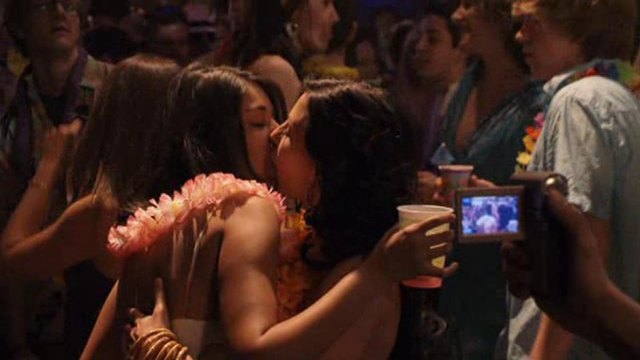
Don’t bring bro-bar culture into a girl bar, this isn’t a live show! “I’ve had several experiences at gay bars where me and my girlfriend and my friends have been hit on my straight men,” a queer friend told me, “And it’s the worst because they think we’re straight and I’m like, bro, I’m dancing with my girlfriend — and then they hit on us even more! It’s gross.”
A bisexual woman pointed out that “I feel like guys go for the same reason that a guy came to and then followed me around a music festival called LADYFEST for like two hours; because they realize there is a much higher ratio of women to men than at other venues and don’t really care that the nature of the venue makes it extremely unlikely that those women want to fuck you because who cares whether women actually WANT to have sex with you, right, as long as you want to have sex with them, like why would that even be a factor.”
She also mentioned, “I had a very traumatic experience because one of my first dates and I went to this gay bar, and we were sort of looking forward to it, and 80% of the people in there were straight, and it was so depressing. We were like ‘Well I guess this is a safe place for us to PDA, or safer than the outside world, but it feels like we have an audience and it’s gross.’ Like straight couples just sitting at tables looking at all the people around them, like spectating.”
But… Not all men?
FOR: It’s Reverse Discrimination!
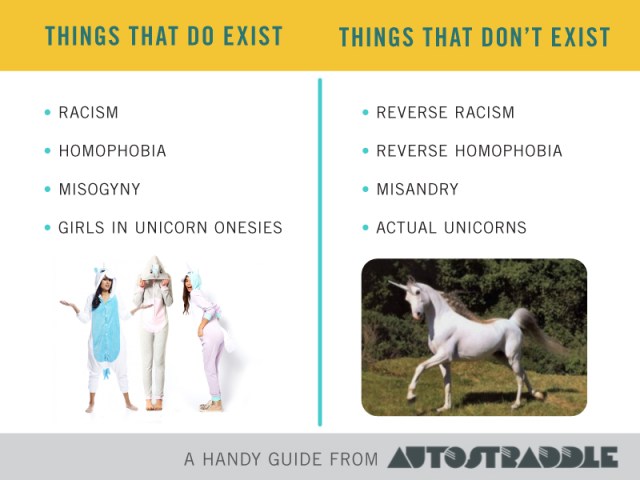
You’re welcome
We wouldn’t want to be unwelcome in straight bars, so why are we making straight people feel unwelcome? AREN’T WE RAGING HYPOCRITES?!!! WHAT ABOUT EQUALITY? OR EQUITY, FOR THAT MATTER?!!!
But….
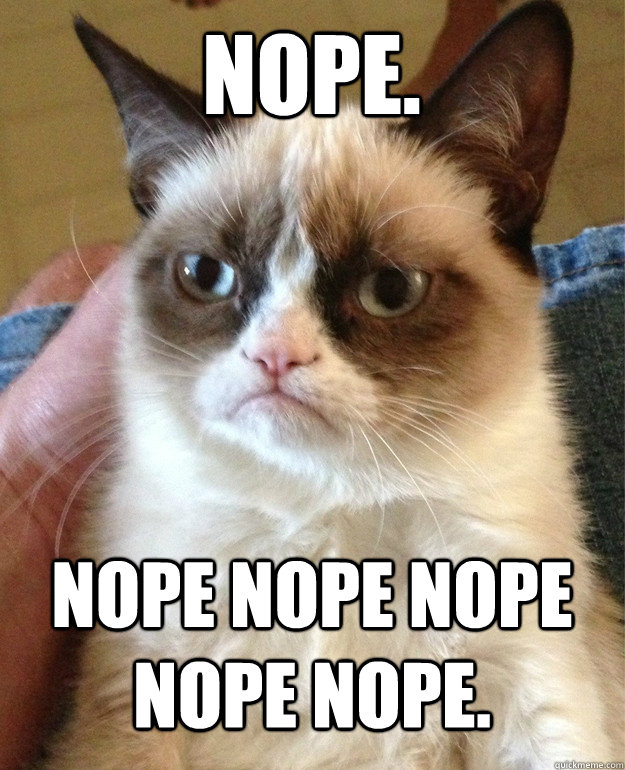
Reverse homophobia isn’t a thing. That’s not how it works. Also it’s worth mentioning that queers and trans people are still kicked out of your bars and are sometimes killed or attacked because they attended your bars.
But… How does the matrix of oppression play out when the heterosexuals seeking admission are of color, or when it’s a gay man who wants in? There’s a relatively strong history of queer spaces being a safe space not just for queer people, but for people of color who feel equally disenfranchised in spaces primarily aimed at white straight cis men.
If it is our collective oppression that enables us to feel comfortable excluding straight people, then we have to acknowledge the limits of that oppression. A cis white lesbian at the queer bar might wanna think twice before sneering at a straight woman of color or a feminine gay man… but this argument still doesn’t make any room for straight cis white guys all up in our space.
AGAINST: We need a safe space for our gender presentations
When we talk about queer bars and parties we usually talk about bars and parties in large diverse cities like San Francisco and New York, but we forget that in rural or conservative areas of the country, a queer bar can actually be the only safe space available, period. A masculine-of-center friend told me that queer bars are the only place she feels like she can breathe easy. She doesn’t fear dirty looks or physical violence from men, which she has experienced in spades all her life, or like they want to compete with her for women. It’s also a rare space where she can go to the bathroom without being informed that the men’s room is right over there! Similarly, femme lesbians often report lesbian bars being the only space where their gender presentation doesn’t get automatically read as “straight” and where she’s free from harassment, intimidation, unwanted sexual attention and even sexual assault from straight guys.
The negative yelp reviews are revelatory in this instance, because the gender presentation policing and derision of masculine or fat women by those reviewers is pretty merciless. An allegedly lesbian bouncer is described as a “Drew Carey lookalike” who needs to “lose some weight.” Unfriendly patrons are accused of being “jealous because [the male reviewer has] fuller facial hair.” Bartenders who won’t crack a smile when a man is apparently aggressively “complimenting” her are, we’re told, revealing “their crack as their Dickies sag.” The kinds of guys who think those thoughts are exactly the kinds of guys who inspire unsmiling bartenders, hostile bouncers and unfriendly patrons.
But… Even at lesbian bars, we’re not always safe from being policed for our gender presentation or other aspects of our identities. At Henrietta Hudson’s, my two friends and I — all of us in skirts and tank tops — were asked if we were actually gay, and not believed when we insisted that we were because we “looked straight.” Many lesbian trans women have testified in the comments that they don’t feel welcome in lesbian bars themselves, and lots of Yelp reviews cited queer bars as being unwelcoming to any woman of color, which is epically fucked up. Also, femme straight women could use a break from harassment, intimidation and unwanted sexual attention as well.
FOR: It’s mean to be mean to people, period.
Why bring more negativity into the world? You could get really upset at these perceived intruders… or you could just hang out and have a good time.
But… Some people are actual assholes! Which is why so much of this just comes down to respecting the space. The truth is that there are a lot of not-queer humans who attend queer bars with the understanding that the space is not for them, and they should defer to its intended clientele, and everything goes just fine.
So tell us what you think! What arguments or arguments-against-arguments did we miss? We’re hopeful that we can have a nice friendly conversation on this topic without snark or defensiveness or wild accusations of bad faith. HAVE AT IT, GRRRRRRLS
Listling Without Commentary: 26 Excerpts From Negative Yelp Reviews Of Lesbian Bars By Men and Straight People
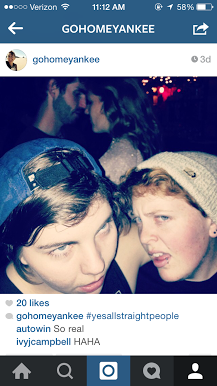
relevant image from our trip to The Lex last weekend
A few weeks ago, we all had a nice time reading excerpts from 1-star Yelp reviews of lesbian bars from actual queer women. But lesbians aren’t the only humans with feelings about their lesbian bars — there are some straights and gay men with a few choice words to share as well. (This list could’ve easily been 26 accusations of “hypocritical” stances on equality or reminders that “discrimination goes both ways” from people horrified that there might ever be a space that doesn’t immediately prioritize their needs.) Everybody has mixed feelings about mixed crowds at lesbian bars, and the reviews are mixed, too — for every straight and/or male hater, there’s another who loves the place despite not being its target audience! Every night, in some lesbian bar somewhere around the world, a straight woman or a man is having a really nice time with his gay lady pals. It’s true! But there are also some straight women and men who can’t handle the adventure and instead wrote these reviews on Yelp. (Also, #23 isn’t actually a negative review, I just thought it was funny.)
If you think lesbians hate lesbian bars, just listen to these folks!
Everything below has been ripped mercilessly out of context.
1. “The staff act like they don’t want you there — or maybe it’s my penis they don’t want there.”
2. “To The Drew Carey lookalike Lesbian bouncer: be nice to people, especially to customers. You never know who will write a review and call you out on your rudeness. Oh and for your own health reasons: lose some weight or adjust your attitude. Nobody likes a Mean Fat Person. You can’t be both!”
3. “One star for interesting “go-go” dancers.”
4. “When my friend used the men’s restroom he discovered that someone had written above the urinal “you are not welcome here.” Really?”
5. “I intentionally let some stranger beat me at pool because 1. this girl was sporting a mullet and 2. I think she was carrying a knife.”
6. “Why do I keep finding myself at [gay bar]?! Oh yeah… my friend has to score some blow.”
7. “Well, after building this place up in my mind for years and begging countless females to let me tag along, last Friday I finally got to experience [bar]. It was so anti-climatic to realize it is just a neighborhood bar that happens to be very woman-identified.”
8. “I have a feeling as to why we were rushed out: we weren’t lesbians.”
9. “Can you imagine what kind of uproar these women would have caused if the roles were reversed and they were refused entrance into a straight business? LOL! They’d probably call all the local news stations!”
10. “The door dyke was SO rude and sour that I’m a little scurred of her — even though I’m over 6′ and she’s probably a foot shorter.”
11. “Most of the “ladies ” here are haters. So much for a supportive, all-inclusive gay community. Perhaps they were jealous because I have fuller facial hair.”
12. “No matter how much you tip or compliment the bartenders, you cannot get them to crack a smile. You may, however, see their crack as their Dickies sag or when they bend over to grab a beer.”
13. “The place is so dingy, grimy, and gross that I seriously believe monsters are going to come flying out of the bathroom at any moment and swoop down on all the dudes and chop our heads off.”
14. “I had met the owner a dozen times but either she never remembered my name or pretended not to. This was obviously because I was a guy.”
15. “The place smelled like onions.”
16. “I tried making conversations with a couple chicks there with no intentions but a friendly gesture and I would literally get quick, sharp answers. I’m sorry, I was interested in how adorable your pug was, not you. I’m straight.”
17. “Talking with my female friends, their guess is that the owner is a manhater.”
18. “I’m reviewing [bar] solely as a neighbor sick of the asinine wasted jackasses that roll out of here at all hours. I’m talking each and every night, around 2 am, girls AND guys are yelling in the streets, usually fighting with each other, trees, street poles, god knows what.”
19. “I must say though, never have I seen a more dapper bunch of men and a more openly horny female population.”
20. “She had no cause to be rude to me, unless she’s male-o-phobic or something.”
21. “Gay or not, If you have a dangling unit, don’t go here.”
22. “Some girl with a fake purse tried to tell my friend that she had a mullet, when it was clearly layered fringe.”
23. “even tho I am a dong pirate, I like [bar]. The crowd is fun and rad, the bartenderwomen are hot so if i was going to go the other way id probably go for one of them.”
24. “You preach equality, yet if you are a newcomer (and straight, accompanied by your boyfriend) to [bar], you will not even be served a drink within 30 minutes (at least). I was excited to be in an establishment that would respect the fact that everyone lives differently, and these differences should be embraced. Unfortunately, because I am heterosexual, I’m not to be treated equally… Needless to say, we left after we were not treated EQUALLY!”
25. “Guys definitely beware, they have absolutely no interest in having you there and definitely will make you feel unwelcome at any and every point. On the other hand, If you’re a man hating lesbian that doesn’t mind overpriced drinks, this is the place for you.”
26. “Seriously, I can’t help it if I was born straight. Hater.”
Sisters Nightclub Closes, Leaves A Hole in Philly’s Lesbian Nightlife and Our Hearts
Feature Image via VisitPhilly.com
The walls closed in. My heart thudded up against my ribcage, suddenly too large for my chest. My lungs felt like they had collapsed. I both wanted to hide, and wanted desperately to be seen. It was 2008, I thought I might be gay, and I had gone to the only lesbian bar in Philadelphia in fearful hope that someone else might be able to figure things out for me. I didn’t get the answers that night, but I was still saddened this week to learn that Sisters Nightclub is closing.
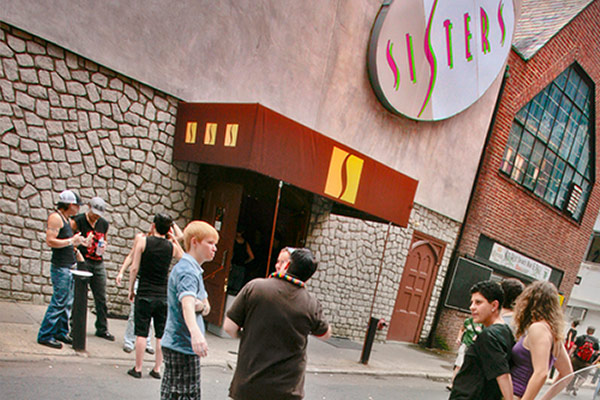
5,000 square feet and three stories of girl-on-girl-on-bar (via VisitPhilly.com)
On Monday, General Manager Denise Cohen posted notice of the closure on Facebook:
How do you say goodbye to something that has been part of your life for so long – a dream – a passion – a love … I have worked within the Gay & Lesbian community for 24 years with 17 of them at Sisters … today with much sadness no actually with a broken heart I am announcing that Sisters Nightclub is no longer in business.
All future events are cancelled except for the Big Gay Boat party hosted by DJ Deejay on August 25. It takes place off site at Moshulu, a four-masted sailing ship; the beloved Gayborhood nightclub and bar itself will open its doors no longer.
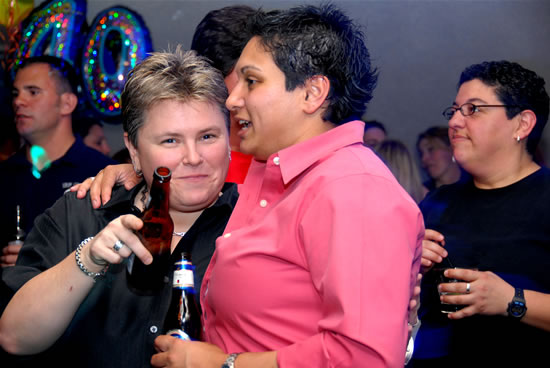
Denise Cohen at Sisters (via sistersnightclub.com)
My personal experience with Sisters was brief, but it made a big impression on me. I went exactly once while it was open, and I stayed 30 minutes, tops. I was so nervous that I walked around the block twice before I worked up the nerve to go inside. At the door, I paid the bouncer a $5 cover for a DJ I never managed to hear over the sound of my own heartbeat in my ears. I sat at the horseshoe-shaped bar, downed two Blue Moons, and attempted to surreptitiously inspect everyone in the bar without landing eye contact. I timidly peeked upstairs and downstairs, then fled for the parking lot, having spoken to no one but the bartender. She had to ask me to repeat my drink order, I spoke so quietly.
All in all, I considered the night to be a great success.
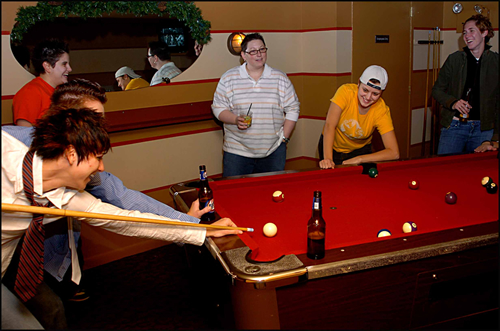
The laid back pool area intrigued me, but I just wasn’t ready to interact with other humans in 2008. (via sistersnightclub.com)
As you may have guessed, Sisters really wasn’t my cup of tea. Lesbian bars terrified me as a questioning 21-year-old; even now, as an out bisexual in New York City, I still don’t feel entirely at home in them. But the point of my adventure that night wasn’t to feel comfortable; it was to explore. I had questions that I couldn’t even give words to, let alone ask out loud. All I wanted right then was to be around some lesbians, watch them living their lives, and see how it made me feel. Sisters allowed me to do exactly that, and I feel so thankful that it was there for me when I needed it.

How did I ever avoid making eye contact while sitting at this bar?
(via sistersnightclub.com)
The news of Sisters’ closure comes at a time when many ponder the death of the lesbian bar scene. Like some of Autostraddle’s smart and wonderful commenters, I find the assessment a tad hyperbolic. As Liz mentioned, queer dance nights are plentiful, and they do tend to skew female. Have you been to Truck Stop in NYC or LA lately? Dyke Night in Boston? They’re thriving – although it’s true that they serve a slightly different function. Honestly, I’m not sure Hot Rabbit is something I could’ve worked up the gumption to explore at 21, although others do it all the time. I probably would have figured something else out, but it stings a little to think that the door on the experience I had is closing, even if not fully.
Molly Webb, a patron of the bar for the past year, points out that while there are many spaces where queer women are welcome, there’s a unique sense of community built within lesbian-specific spaces. She recalls the reliable cast of characters that would show up every week. “My best memory of Sisters would be the certainty of Thursday nights, and that everyone would be there and someone would sing ‘Closer to Fine’ on karaoke. It was just stability in our lives,” she says.“Sisters was the only stable space dedicated to just dykes and queer ladies. There’s a definite hole in the Philly queer scene now.”
On Tuesday, Molly staged a funeral to commemorate Sisters and the loss of lesbian-specific space in Philadelphia. A gathering of 15-20 people showed up to write their goodbyes on Post-it notes, put lipstick kisses on the door and leave plastic flowers in the door handle. They are looking to put together a discussion group, but Molly says, “It’s nebulous right now. … I don’t think that there are any definitive or limiting suggestions on the table right now.”
Whatever the future may hold, Sisters will not be forgotten. Although the physical location may be locked (and the Post-it notes now removed from the door), there’s a beautiful internet love fest going on for anyone who wants to join in the reminiscing at Denise Cohen’s Facebook and Sisters Philly’s Facebook.
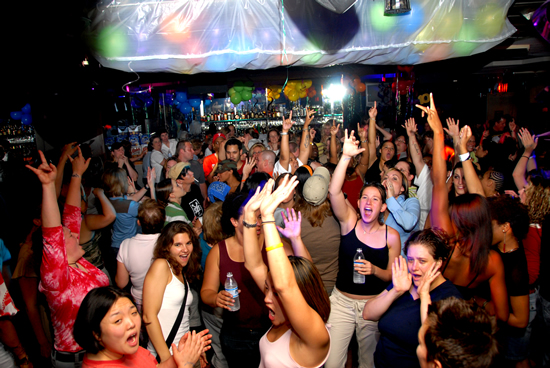
Sisters’ 10 year anniversary party. This week, the bar closes after 17 years.
(via sistersnightclub.com)
You Should Go: The Welcoming Committee’s “Flannel Takeover” Is Queering Boston This Saturday
Hello Bostonians! Are you as sad as I am about the dearth of good bars for queer ladies in our city? Because I’m actively sad about it on kind of a regular basis. Luckily there’s this group of people who have somehow figured out how to make our lack of a solid place to meet each other into a good thing! They’re called The Welcoming Committee — and if you haven’t yet celebrated under their pineapple you’re in luck, because the next opportunity is right around the corner.
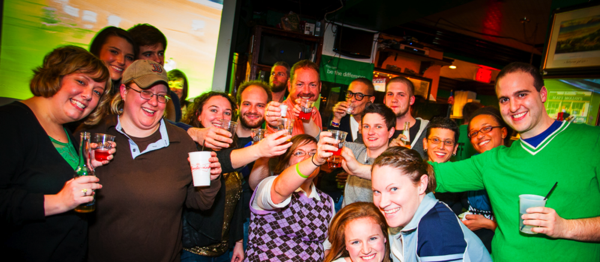
CHEERS, PAST TAKER-OVERERS! (VIA THE WELCOMING COMMITTEE)
The Welcoming Committee (formerly known as Guerilla Queer Bar) is a (currently!) Boston-based movement that “takes over typically straight bars, sports games, special events, and major travel destinations for one-time-only experiences.” Basically the idea is to get enough queer people in the same place that there’s no need to spend your energy worrying about whether that girl over by the jukebox is really giving you the eye or what, and also that said jukebox is only playing Robyn.

ALSO THEY GIVE YOU COOL FREE PINS SOMETIMES (VIA THE WELCOMING COMMITTEE)
So far, they’ve taken over everywhere from Montreal to the Boston Symphony Orchestra to A River In Nature Where You Can Raft. They’ve got all the amenities necessary for a 21st-century movement, including a sweet blog, an Instagram, and a team of attractive and interesting people called The Corps whose entire job is to welcome you into the fold. One time I went to one of their shindigs at the Isabella Stewart Gardner museum and got so tipsy on that “we belong” feeling and those strange pear cocktails that I ended up hitting on a painting. Huge success.

FOXY (FOR REAL)
Like many LGBTQ happenings, some of The Welcoming Committee’s events tend to skew pretty G. So every third Saturday, they throw something specifically for queer women. It’s called the Flannel Takeover, and so far they’ve transformed everywhere from The Burren, an Irish pub in Somerville, to Allston’s Common Ground Bar & Grill (where the DJ thanked them for making it “a little less douchey”). This coming Saturday, August 17th, happens to be one of those third Saturdays, so if you’ve been looking to meet area queers somewhere more soft and comfortable-sounding than Machine, this is your chance! They don’t announce the venue until the day before, so follow the Flannel Takeover Company on Facebook, and/or join the TWC e-mail list to stay in the loop (bonus: their emails are often stuffed with choice gifs). And if you can’t make it this weekend, don’t worry — as long as there is Boston, there will be bars, and as long as there are Saturdays, there will be flannel-based gatherings within them.
